
DOT/FAA/AM-23/09
Aviation Safety
Office of Aerospace Medicine
Washington, DC 20591
UAS Ai
r Carrier Operations Survey: Training Requirements
Kevin W. Williams
1
Theodore C. Mofle
2
Peter T. Hu
2
1
Federal Aviation Administration
Civil Aerospace Medical Institute
Oklahoma City, OK 73125
2
Cherokee Nation 3S, LLC
Oklahoma City, OK 73125
March 2023

i
NO
TICE
This document is disseminated under the sponsorship of the U.S. Department
of Transportation in the interest of information exchange. The United States
Government assumes no liability for the contents thereof.
This publication and all Office of Aerospace Medicine technical reports are
available in full-text from the Civil Aerospace Medical Institute’s
publications Web site: (
www.faa.gov/go/oamtechreports)
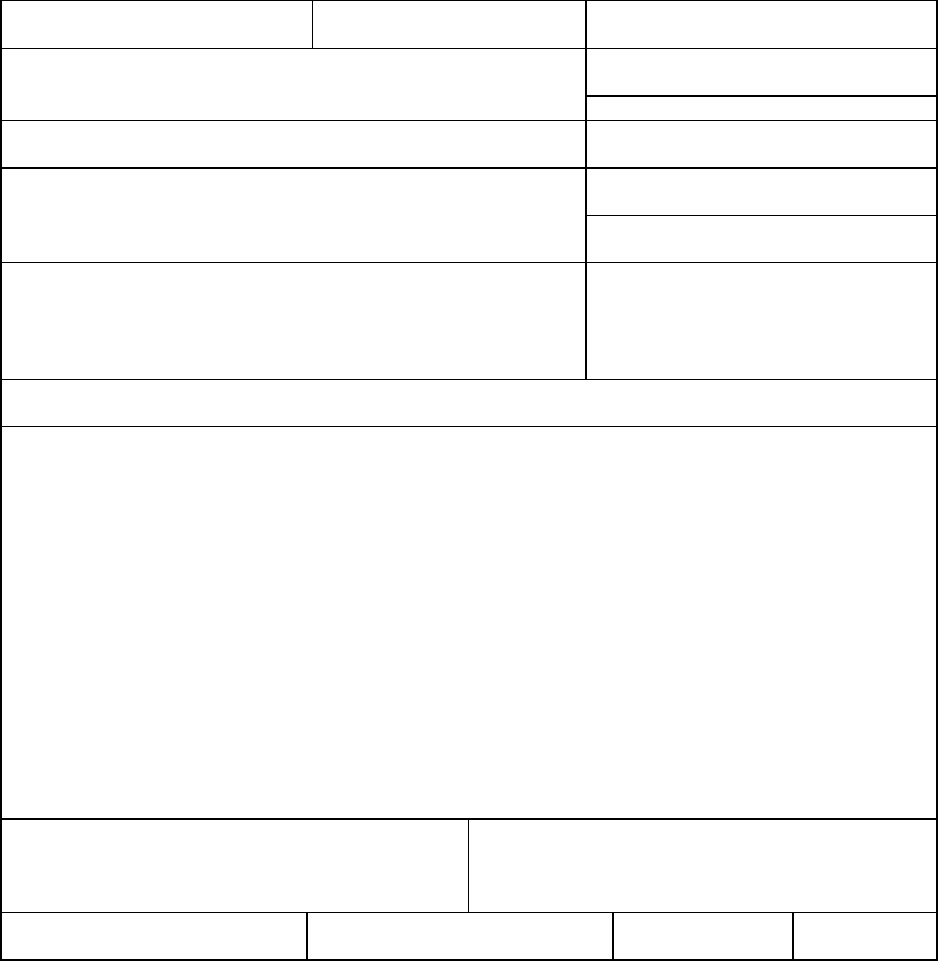
ii
Technical Documentation Page
1. Report No.
2. Government Accession No.
3. Recipient's Catalog No.
DOT/FAA/AM-23/09
4. Title and Subtitle
UAS Air Carrier Operations Survey: Training Requirements
5. Report Date
March 2023
6. Performing Organization Code
7. Author(s)
8. Performing Organization Report No.
Williams, K.
1
, Mofle, T.
2
, Hu, P.
2
9. Performing Organization Name and Address
10. Work Unit No. (TRAIS)
Federal Aviation Administration
Civil Aerospace Medical Institute, AAM-500
Oklahoma City, OK 73169
11. Contract or Grant No.
12. Sponsoring Agency Name and Address
Office of Aerospace Medicine
Federal Aviation Administration
800 Independence Ave., S.W.
Washington, DC 20591
13. Type of Report and Period Covered
15. Supplementary Notes
16. Abstract
There is an increasing demand to utilize unmanned aircraft systems (UAS) for an array of new applications
currently outside the scope of written regulations, such as air taxi services, package delivery, and crop dusting.
The Code of Federal Regulations on Aeronautics and Space (14 CFR) is restrictive to air carrier applications for
UAS. In particular, small UAS (sUAS) regulations (14 CFR § 107 [Federal Regulation for Commercial sUAS])
do not explicitly address air carrier operations. Regulations relevant to air carrier operations (14 CFR §
121
[F
ederal Regulation for Air Carriers] and § 135 [Federal Regulation for Commuter Air Operations]) were not
written to include the use of UAS. Training requirements have been extensively researched in traditionally piloted
aircraft operations (see Torrence et al., 2020), but recent and continuing developments in UAS applications and
UAS automation have resulted in changing roles and responsibilities for crewmembers. Training literature was
gathered in an annotated bibliography, and experts in both industry and academia were surveyed about current
and future policies from their companies to gauge the future direction of UAS operations. This survey will help
inform current and planned future UAS operations related to training. It will also allow for regulations of last-
mile and high-altitude-long-endurance operations so that these novel applications of UAS can be safely integrated
into the National Airspace System (NAS). Findings may inform future regulations concerning UAS training for
crewmembers related to air carrier operations and potentially help standardize these requirements. Altogether, this
will support the safe and efficient integration of UAS into the NAS.
17. Key Words
unmanned aircraft systems, UAS Training, UAS
Training requirements, air carrier operations,
testing, knowledge
18. Distribution Statement
Unlimited
19. Security Classif. (of this report)
Unclassified
20. Security Classif. (of this page)
Unclassified
21. No. of Pages
106
22. Price
Form DOT F 1700.7 (8-72)
Reproduction of completed page authorized
iii
Acknowledgements
The authors would like to thank our sponsors, Barbara Adams (AJF-100) and Autumn
Alderdice (AFS-280) and our program manager, William Oehlschlager (ANG-C21) for their
expertise, continued support, and constructive feedback throughout the research process. The
authors would also like to thank Suzanne Thomas especially for her support in building the
survey instrument and in aggregating the results for reporting.
iv
Table of Contents
Acknowledgements ....................................................................................................................... iii
Table of Contents ......................................................................................................................... iv
List of Figures ............................................................................................................................... vi
List of Tables ............................................................................................................................... vii
List of Abbreviations .................................................................................................................... x
Abstract ......................................................................................................................................... xi
Introduction ................................................................................................................................... 1
UAS Air Carrier-like Training Issues ......................................................................................... 1
Certification and Qualification Requirements............................................................................. 2
Method ........................................................................................................................................... 2
Stratification and Sample Selection ............................................................................................ 2
Survey Items ................................................................................................................................ 3
Survey Administration ................................................................................................................ 4
Results ............................................................................................................................................ 4
Eligibility ..................................................................................................................................... 5
Demographics.............................................................................................................................. 6
Qualification Requirements....................................................................................................... 10
Training ..................................................................................................................................... 12
Organizational Certifications ................................................................................................. 12
Organizational Programs ....................................................................................................... 12
Pilot Training ......................................................................................................................... 17
Discussion..................................................................................................................................... 22
Conclusion ................................................................................................................................... 24
References .................................................................................................................................... 26
Appendix A. Survey Questions Related to UAS Training .................................................... A-1
Example of Report Format ...................................................................................................... A-1
Definitions of Descriptive Statistics ........................................................................................ A-1
Respondent Eligibility ............................................................................................................. A-2
Section A. Demographics ........................................................................................................ A-3
v
Section B. Air Carrier Operational Considerations for Unmanned Aircraft Systems ............ A-8
Section C. Qualification Requirements ................................................................................... A-8
Section D. Training ............................................................................................................... A-10
Appendix B. Text Response to Open Ended Questions for Air Carrier Operational
Considerations for UAS: Training .......................................................................................... B-1
Section A. Demographics ........................................................................................................ B-2
Section B. Qualification Requirements ................................................................................. B-17
Section C. Training ............................................................................................................... B-21
vi
List of Figures
Figure 1 Respondents Who Work with an Organization that Operates/Plans to Operate UAS;
Organizations that Have Established Pilot Qualifications (n = 173) .............................................. 5
Figure 2 Number of Pilots Employed by Each Organization (n = 127) ....................................... 6
Figure 3 Pilots Employed by Each Organization, by Industry Sector (n = 127) ........................... 7
Figure 4 Years of Experience in Current Job Role (n = 168) ........................................................ 8
Figure 5 Required Training Flight Hours upon Hire (n = 115) ................................................... 11
Figure 6 If Yes, Flight Hours Required at Hire (n = 28) ............................................................. 11
Figure 7 Topics Taught by Instructors and Instructors' Ratings of Topic Importance (n = Percent
Taught/ n = Importance) ............................................................................................................... 18
Figure 8 Topics Taught by Instructors and Instructors' Ratings of Topic Importance (continued;
continued; n = Percent Taught/n = Importance) 19
Figure 9 Topics Taught to UAS Operator/Pilots Ranked by Percent Taught (n = Provided by
Topic) ............................................................................................................................................ 21
Figure 10 Recurrent Training Intervals (n = 67) .......................................................................... 22
vii
List of Tables
Table 1 Respondent Recruitment Targets ...................................................................................... 3
Table 2 Main Survey Sections ....................................................................................................... 4
Table 3 Final Respondent Recruitment .......................................................................................... 5
Table 4 Commercial UAS Sector that Best Describes Respondents’ Current or Planned
Operations (n = 168) ....................................................................................................................... 8
Table 5 Commercial UAS Industry that Best Described Respondents’ Current or Planned
Operations (n = 168) ....................................................................................................................... 9
Table 6 Certifications Held by Respondents Who Currently Have a License or Certification to
Fly a UAS (n = 158). .................................................................................................................... 10
Table 7 Minimum Requirements for Instructors (n = 80) and Pilots (n = 123) to Operate Drones
at Respondents’ Organization ....................................................................................................... 11
Table 8 Certification offered at Training Completion (n = 80) ................................................... 13
Table 9 Specific Operation Training Provided by Organization (n = 78) .................................... 14
Table 10 Automation Techniques Taught during Training Programs (n = 80) ........................... 15
Table 11 UAS Platforms Institutes Training Provided (n = 80) .................................................. 15
Table 12 Number of Rotors for each Multi-Rotor Wing UAS Training Provided (n = 66) ........ 16
Table 13 Training Provided by Each Organization (n = 33) ........................................................ 16
Table B1 Responses Provided by Respondents Who Indicated ‘Other’ on Item A1 and Who
Provided a Description of Their Job Role (n = 13) ........................ Error! Bookmark not defined.
Table B2 Descriptions of Job Responsibilities Provided by Respondents on Item A1b (n = 166)
........................................................................................................ Error! Bookmark not defined.
Table B3 Responses Provided by Respondents Who indicated ‘Works with drones, but none of
the above’ on Item A3, and Who Provided the Capacity in Which Their Organization Worked
With Drones on Item A4 (n = 38) .................................................. Error! Bookmark not defined.
Table B4 Responses Provided by Respondents Who Indicated ‘Other’ on Item A5, and Who
Described Their Organization’s Current or Planned Drone Operations (n = 13) .................. Error!
Bookmark not defined.
Table B5 Responses Provided by Respondents Who Indicated ‘Other’ on Item A7, and Who
Described the Certificates They Hold (n = 14). ............................. Error! Bookmark not defined.
viii
Table B6 Responses Provided by Respondents Who Indicated ‘Other’ on Item A8, and Who
Described the Certificates Required for Their Job (n = 12) .......... Error! Bookmark not defined.
Table B7 Responses Provided by Respondents Who Indicated ‘No, I hold a certificate(s) from
another organization’ on Item A9, and Who Listed the Certificates They Hold from Another
Organization (n = 18) ..................................................................... Error! Bookmark not defined.
Table B8 Responses Provided by Respondents Who Indicated ‘Instructor’ on Item A1, and Who
Listed Their Organization’s Requirements to Become an Instructor on Item C6 (n = 39) ... Error!
Bookmark not defined.
Table B9 Responses Provided by Respondents Who Indicated ‘Other training’ on Item C33, and
Who Listed the Minimum Organizational Requirements Necessary for Instructors to Operate
Drones (n = 14) .............................................................................. Error! Bookmark not defined.
Table B10 Responses Provided by Respondents Who Indicated ‘Other training or experience’ on
Item C34, and Who Listed Their Minimum Training or Experience Requirements (n = 19) Error!
Bookmark not defined.
Table B11 Responses Provided by Respondents Who Indicated ‘Yes’ on Item C5, and Indicated
Which Government Agency Provided Review of Their Training Materials (n = 30) ........... Error!
Bookmark not defined.
Table B12 Responses Provided by Respondents Who Indicated ‘Yes’ on Item C3, and Indicated
Which Non-Government Agency Provided Review of Their Training Materials (n = 28) ... Error!
Bookmark not defined.
Table B13 Responses Provided by Respondents Who Indicated ‘Yes’ on Item C7, and Who
Listed the Certificates or Authorizations Held by Their Organization (n = 18) . Error! Bookmark
not defined.
Table B14 Responses Provided by Respondents Who Indicated ‘Other’ on Item C28, and
Described the Type of Operations Provided for Training (n = 6) . Error! Bookmark not defined.
Table B15 Responses Provided by Respondents Who Indicated ‘Other’ on item C31, and
Indicated the Type of Drones They Provide Training on (n = 2) .. Error! Bookmark not defined.
Table B16 Responses Provided by Respondents Who Indicated ‘Simulation training’ on Item
C32, and Indicated the Type of Simulation Training They Provide (n = 17) ..... Error! Bookmark
not defined.
Table B17 Responses Provided by Respondents Who Indicated ‘Yes on item C37a, and
Described the Training Provided outside Their Organization (n = 11) ....... Error! Bookmark not
defined.
ix
Table B18 Responses Provided by Respondents Who Indicated ‘Yes’ on Item C38a, and
Described the Additional Training Provided by Their Organization on Item C38b (n = 1) .. Error!
Bookmark not defined.
Table B19 Responses Provided by Respondents who Indicated ‘Yes’ on Item C38a, and
Described the Training Provided by a 3
rd
Party on Item C38c (n = 2) ........ Error! Bookmark not
defined.
Table B20 Responses Provided by Respondents Who Indicated ‘Other training’ on Item C39,
and listed Training Required by Their Organization (n = 11) ....... Error! Bookmark not defined.
Table B21 Responses Provided by Respondents who Indicated ‘Recurrent training’ on Item C39,
and Listed Frequency of Recurrent Training on Item C54 (n = 68) ............ Error! Bookmark not
defined.

x
List of Abbreviations
AFOQT
Air Force Officer Qualifying Test
ASVAB
Armed Services Vocational Aptitude Battery
BVLOS
Beyond Visual Line of Sight
CFR
Code of Federal Regulation
14 CFR
Title 14 (Federal Regulations on Aeronautics and Space)
14 CFR § 107
Title 14 CFR Part 107 (Federal Regulation for Commercial sUAS)
14 CFR § 121
Title 14 CFR Part 121 (Federal Regulation for Air Carriers)
14 CFR § 135
Title 14 CFR Part 135 (Federal Regulation for Commuter Air Operations)
DoD
Department of Defense
FAA
Federal Aviation Administration
JTA(s)
Job Task Analysis
KSAs
Knowledge, Skills, and Abilities
NAS
National Airspace System
NASA
National Aeronautics and Space Administration
NOAA
National Oceanic and Atmospheric Administration
RPA
Remotely Piloted Aircraft
SA
Situation Awareness
SME(s)
Subject Matter Expert(s)
sUAS
Small Unmanned Aircraft System
TBAS
Test of Basic Aviation Skills
UAS
Unmanned Aircraft System
xi
Abstract
There is an increasing demand to utilize unmanned aircraft systems (UAS) for an array of new
applications currently outside the scope of written regulations, such as air taxi services, package
delivery, and crop dusting. The Code of Federal Regulations on Aeronautics and Space (14 CFR)
is restrictive to air carrier applications for UAS. In particular, small UAS (sUAS) regulations (14
CFR § 107 [Federal Regulation for Commercial sUAS]) do not explicitly address air carrier
operations. Regulations relevant to air carrier operations (14 CFR § 121 [Federal Regulation for
Air Carriers] and § 135 [Federal Regulation for Commuter Air Operations]) were not written to
include the use of UAS. Training requirements have been extensively researched in traditionally
piloted aircraft operations (see Torrence et al., 2020), but recent and continuing developments in
UAS applications and UAS automation have resulted in changing roles and responsibilities for
crewmembers. Training literature was gathered in an annotated bibliography, and experts in both
industry and academia were surveyed about current and future policies from their companies to
gauge the future direction of UAS operations. This survey will help inform current and planned
future UAS operations related to training. It will also allow for regulations of last-mile and high-
altitude-long-endurance operations so that these novel applications of UAS can be safely
integrated into the National Airspace System (NAS). Findings may inform future regulations
concerning UAS training for crewmembers related to air carrier operations and potentially help
standardize these requirements. Altogether, this will support the safe and efficient integration of
UAS into the NAS.
Keywords: unmanned aircraft systems, UAS Training, UAS Training requirements, air
carrier operations, testing, knowledge
1
Introduction
As the use of Unmanned Aircraft Systems (UAS) continues to expand, so too does the
complexity of flight operations. The Federal Aviation Administration (FAA) refers to these
operations, which involve the transportation of cargo and people within the National Airspace
System (NAS), as Air Carrier Operations. The current Code of Federal Regulations for air
carriers (14 CFR § 121) and commuter air operations (14 CFR § 135) were not created with UAS
operations in mind. 14 CFR § 107 provides regulations for small (commercial) UAS (sUAS)
operations, but does not address systems that weigh over 55 pounds, nor the more complex types
of operations expected for unmanned air carrier activities.
The FAA is working to standardize UAS regulations for air carrier operations. Existing
regulations do not adequately address the unique set of challenges presented by novel UAS
operations. The type of UAS (airframe and ground control station) and its operational purpose
affect the required qualifications and training for the crew. This specific training and certification
will be required just as they are for onboard piloted aircraft (e.g., 14 CFR § 91, §121, §135).
To address the expected need for a new set of standards regarding the certification and
training of crews associated with UAS air carrier-like operations, a research program was
initiated. In the first phase of this research program, literature was reviewed on the following
topics:
• Knowledge, skills, and abilities (KSAs; Torrence et al., 2020).
• Crew and staffing options (Hu et al., 2022).
• Duty time, shiftwork, and fatigue (Durham et al., 2020; Nesthus et al., 2021).
For the second phase of this research program, and based on some of the findings from
the literature reviews, a survey was created and administered to subject matter experts (SMEs)
who were either involved in the manufacturing and/or operation of UAS/remotely piloted aircraft
(RPA), or in educating personnel for manufacture and/or operation of UAS/RPA. This report
summarizes findings from the survey related to both the training provided to pilot/operators and
to future training requirements. Other reports summarize aspects of the survey not covered in this
report (Durham et al., Under Review; Williams et al., Under-Review-a, Under Review-b).
UAS Air Carrier-like Training Issues
In the United States, commercial aviation operations have been around for more than a
century, providing sufficient time to define and revise training regulations and procedures based
on research regarding off-nominal events. The publication of 14 CFR § 107 in 2016 was the first
step in establishing UAS pilot training requirements; however, this regulation is restricted to only
sUAS weighing less than 55 lbs. and operating under certain conditions (e.g., within visual line
of sight, less than 400 ft.) with some exceptions provided through waivers (e.g., beyond visual

2
line of sight [BVLOS]). Much work will be needed to fully identify training requirements for all
crewmembers and all types of UAS operations.
Certification and Qualification Requirements
Currently, the only requirement for operating a UAS commercially within the NAS is to
hold a remote pilot certification as established in 14 CFR § 107. In addition, qualifying for a
remote pilot certificate is accomplished solely by passing a written exam, with no need to
demonstrate flight proficiency. While this might be sufficient for simple sUAS operations, it is
expected that operations that are more complex will require a much broader level of training and
testing for pilots before being certified to conduct these operations. We also expect that these
broader requirements will not be the same as those already established for manned air carrier
operations because of differences in how operations are conducted, the type of aircraft employed,
and the level and kinds of automation used. This research effort should assist regulators in setting
requirements for these more complex and specialized operations.
Method
A survey was constructed to gather information regarding the current and expected future
state of UAS training practices that were considered relevant to air carrier-like activities. We
were interested in gathering information from people engaged in different aspects of commercial
UAS activities across a spectrum of responsibilities, from frontline workers to high-level
managers and educators. Specifically, we wanted to poll a variety of experts involved in either
commercial UAS activities or instructors involved in personnel training for commercial UAS
activities.
Stratification and Sample Selection
The strategy employed was to cast a “wide net” of individual experience/knowledge by
probing as many viewpoints regarding UAS operations (including UAS air carrier operations) as
possible. All respondents had to meet three eligibility requirements before providing survey
responses: 1) Must be affiliated with an operation that operates or plans to operate commercial
UAS operations OR be affiliated with a UAS training or educational institution, 2) Must be
affiliated with an organization that has established qualification requirements OR an affiliation
with an organization that develops training requirements/provides training, 3) If affiliated with
an organization that operates or plans to operate commercial UAS activities, the organization
must employ two or more UAS Pilots/Operators.
Participant names and email addresses were gathered from publicly available dockets on
the Federal Register (which identifies corporations who received blanket waivers from 14 CFR §
107), the FAA’s publicly-available Part 107 Waivers website
1
(which identifies individuals who
1
https://www.faa.gov/uas/commercial_operators/part_107_waivers/waivers_issued/

3
have been granted waivers from 14 CFR § 107, thus known to be involved in commercial UAS
activities), Google searches, and names provided by the research sponsors and contractors. To
accommodate electronic distribution, only those individuals with email addresses on file were
included in the initial sample. Respondents were also encouraged to forward the survey link to
other qualified colleagues. Table 1 presents the different types of respondents that were targeted
for the survey along with our original goal for the number of respondents of each type.
Table 1
Respondent Recruitment Targets
Respondent Category
Target
Small UAS Pilot/Operator (<55 lbs.)
40
Large UAS Pilot/Operator (≥55 lbs.)
40
UAS Cargo/Sensor Operator
40
Supervisor/Manager
40
UAS Instructor
40
Engineer
10
Other Crewmembers
10
Total
220
A statistical power analysis
2
demonstrated that 40 respondents per group would result in
a power of 0.8, providing a statistically representative sample of the population. The additional
groups of engineers and other crewmembers were included to provide additional assurance of
generalizability to the UAS industry.
Survey Items
Survey questions were developed to address critical areas in UAS operations. Besides
demographic information, we wanted to cover several topics related to both current and future
UAS operations that could be related to air carrier-like activities (e.g. crew and staffing
requirements, KSA requirements, duty and shift requirements, and training and certification
requirements). The survey was constructed so that not every respondent received the same set of
questions. Branching points were incorporated to route the respondents to the set of questions
appropriate for their particular areas of expertise. Therefore, the number of responses per
question varied. Table 2 provides an exhaustive list of the topics included in the survey. All
survey items were administered electronically via a Qualtrics link.
2
G*Power software, http://www.gpower.hhu.de/

4
Table 2
Main Survey Sections
Air Cargo
Instructor, Training
Air Carrier/Unmanned
Abilities
Crew & Staffing
Skills
Crew & Staffing, Fatigue
Organization
Crew & Staffing, Fatigue, Scheduling
Respondent Population
Crew & Staffing, Selection
Training
Crew & Staffing, Workload
Training, Certification
Fatigue & Fitness For Duty
Training, Not Required
Fatigue & Fitness For Duty, Reporting
Training, Required
Fatigue, Naps & Breaks
Training, Required, Recurrent
Instructor, Qualifications
UAS Equipment
Appendix A contains a listing of the questions and graphed responses relevant to the
training requirements portion of the survey. The survey was reviewed by a group of experienced
FAA researchers and sponsors for clarity of instructions and technical details. In addition, beta
testing was conducted within the research team and with a few UAS SMEs to evaluate the
quality of the survey. Feedback from the beta testing was discussed, incorporated, and approved
by all vested parties.
Survey Administration
Upon clicking on the Qualtrics link, respondents received the informed consent notice
3
,
that provided them with an overview of the study including the purpose, and informed them
about their rights as volunteer research respondents (i.e., participation is optional, the FAA will
de-identify their data before use). All respondents were asked to provide their consent before
continuing with the survey.
The survey consisted of approximately 147 questions; the exact number of questions
varied because of the customized items based on job role and experience (asked at the beginning
of the survey). Lastly, survey respondents were compensated via a $50 mailed check for their
time spent in completing the survey.
Results
The survey was active for 90 days. Recruitment was short of the 220-respondent target.
Table 3 provides the final respondent count by job role.
3
An Informed Consent notice is a legal and ethical requirement for research involving human participants. This
study was separately reviewed and approved by the CAMI Institutional Review Board and by the Office of
Management and Budget (OMB Control No. 2120-0803).

5
Table 3
Final Respondent Recruitment
Respondent Category
Target
Recruitment
Final
Recruitment
Job Role
(%)
Small UAS Pilot/Operator (<55 lbs.)
40
51
29.5
Large UAS Pilot/Operator (≥55 lbs.)
40
14
8.1
UAS Cargo/Sensor Operator
40
4
2.3
Supervisor/Manager
40
45
26.0
UAS Instructor
40
41
23.7
Engineer
10
5
2.9
Other Crewmembers
10
13
7.5
Total
220
173
100.0
Eligibility
One hundred and seventy-three respondents met the eligibility requirements of the
survey. Of these, 131 (75.7%) reported being affiliated with an organization that operates or
plans to operate commercial UAS operations and 42 (24.3 %) of those reported being affiliated
with a training or educational organization. Additionally, 107 (61.8%) reported working with an
organization with established qualification requirements, and 66 (38.2 %) reported being
affiliated with an organization that develops pilot requirements or provides training (Figure 1).
To be considered a valid respondent, the organization for which they are employed needed to
employ two or more UAS operators. The number of operators employed by each organization
and the percentage of organizations with the number of pilots employed per industry sector are
provided in Figure 2.
Figure 1
Respondents Who Work with an Organization that Operates/Plans to Operate UAS;
Organizations that Have Established Pilot Qualifications (n = 173)
75.70%
24.30%
61.80%
38.20%
I work with a crew that
operates, or plans to
operate, UAS
I am affiliated with an
institution that provides
UAS training
I work for an
organization that has
qualification
requirements
I work for an
organization that
develops requirements
or provides training

6
Figure 2
Number of Pilots Employed by Each Organization (n = 127)
4
Demographics
Participants mainly worked in organizations with 10 or fewer pilots, a finding that holds
true across each industry. The military and shipping industries appeared to have the largest
percentages of organizations employing more than 40 pilots (see Figure 3).
Only three respondents reported being associated with current or future UAS passenger
transport; however, there were 23 respondents associated with package delivery (see Table 5).
These respondents would be most associated with future air carrier-like UAS operations;
however, most current UAS operations are not concerned with these future operations at this
time.
4
Results include only respondents who indicated ‘I work with an organization or crew that operates, or plans to
operate, unmanned aircraft systems (UAS)/drones)’ see Appendix A, Section A. Demographics)
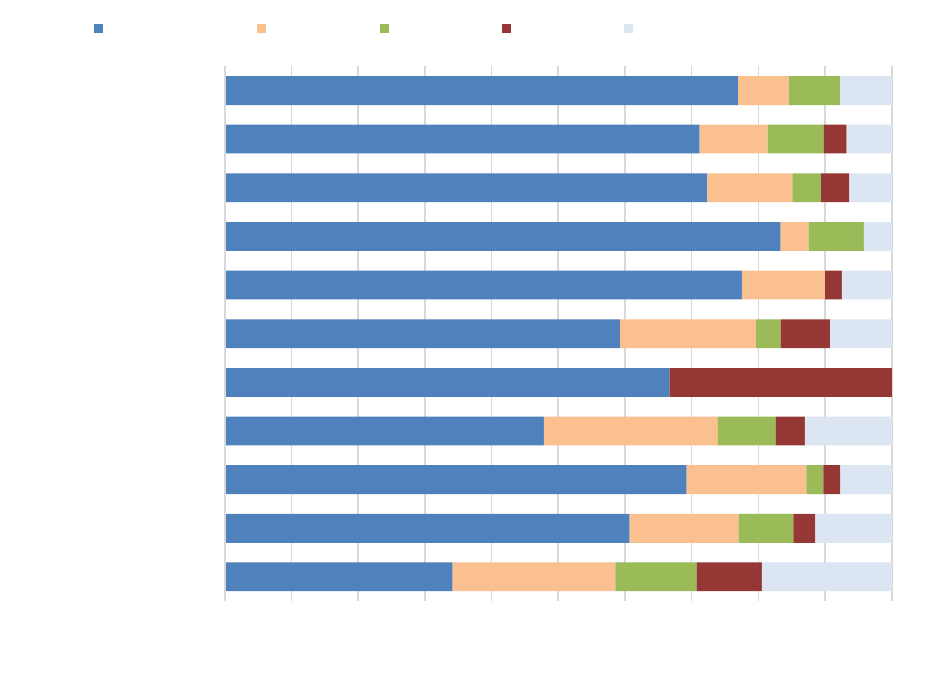
7
Figure 3
Pilots Employed by Each Organization, by Industry Sector (n = 127)
Survey respondents reported an average of 7.01 (SD = 5.58) years of experience in their
current job role (Figure 4). The majority of survey respondents indicated that they work within a
drone service organization, with working at a school or other type of training program being the
second most common response (Table 4). Responses for “work within a drone service
organization” in Table 4 only included organizations that used drones to make money. This led
to a substantial number of respondents (n = 38) under the “Works with drones, but none of the
above” response in Table 4 (see Table B3 in Appendix B for a listing of these responses). Table
5, on the other hand, included sectors that used drones in a “not-for-profit” capacity as well as
“for-profit” sectors. The most common sectors for respondents were infrastructure, education,
and emergency response (e.g., law enforcement, search and rescue).
34.2
60.7
69.2
47.8
66.7
59.3
77.5
83.3
72.3
71.2
76.9
24.4
16.4
18.0
26.1
20.4
12.5
4.2
12.8
10.2
7.7
12.2
8.2
2.6
8.7
3.7
8.3
4.3
8.5
7.7
9.8
3.3
2.6
4.4
33.3
7.4
2.5
4.3
3.4
19.5
11.5
7.7
13.0
9.3
7.5
4.2
6.4
6.8
7.7
0.0 10.0 20.0 30.0 40.0 50.0 60.0 70.0 80.0 90.0 100.0
Military
Infrastructure
Agriculture
Shipping
Passenger Transport
Emergency Response
Entertainment/Media
Real Estate
Research
Education
Other
Pilots Employed at Each Organization (%)
Industry Sector
10 or fewer pilots 11-20 pilots 21-30 pilots 31-40 pilots More than 40 pilots
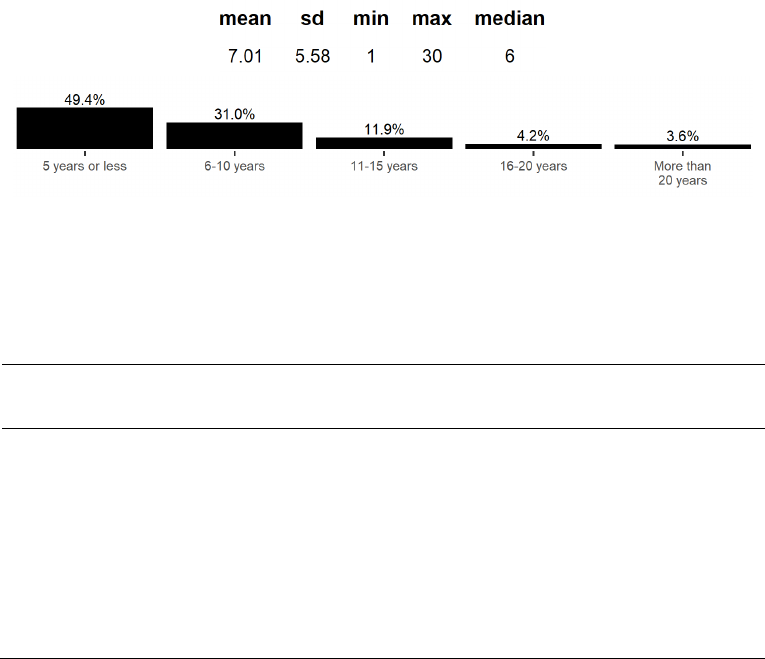
8
Figure 4
Years of Experience in Current Job Role (n = 168)
Table 4
Commercial UAS Sector that Best Describes Respondents’ Current or Planned Operations (n =
168)
Respondents
Sector Type
Count
(n*)
Percent
(%*)
Drone Service Operator (Uses drones to make
money)
95
56.5
School or Training Program (Teaches students
about drones)
76
45.2
Manufacturer of Drones (e.g., drone hardware,
control station equipment, software)
28
16.7
Works with drones but none of the above
38
22.6
Note: May sum to greater than the number of respondents to the item as the response option was
“select all that apply”, providing an opportunity for respondents to select more than one option.
The percentage of respondents (percent [%]) is the number of respondents to the item, out of the
total number of respondents.

9
Table 5
Commercial UAS Industry that Best Described Respondents’ Current or Planned Operations (n
= 168)
Respondents
Industry Type
Count
(n*)
Percent
(%*)
Military or Military Contractor
41
24.4
Infrastructure (e.g., energy, roads, construction)
61
36.3
Agriculture
39
23.2
Shipping Package Delivery
23
13.7
Passenger Transportation (Air Taxi)
3
1.8
Emergency Response (e.g., law enforcement, search and rescue)
54
32.1
Entertainment and Media (e.g., news, film-making)
40
23.8
Real Estate
24
14.3
Academic/Scientific Research
47
28.0
Education
59
35.1
Other
5
13
7.7
Note: May sum to greater than the number of respondents to the item as the response option was
“select all that apply”, providing an opportunity for respondents to select more than one option.
Over ninety percent of respondents currently hold a license or certification to fly a UAS
(see Table 6). Respondents who held a certificate that was not listed as an option indicated their
certificate in a text entry box (see Table B5 in Appendix B).
5
For responses for ‘Other’ UAS industries not in response list see Appendix B: Table B4 for a list of written
responses

10
Table 6
Certifications Held by Respondents Who Currently Have a License or Certification to Fly a UAS
(n = 158)
6
.
Respondents
License or Certification Type
Count
(n*)
Percent
(%*)
14 CFR § 107 certificate (e.g., remote pilot certificate)
143
90.5
14 CFR § 61 certificate (e.g., manned pilot certificate)
50
31.6
Non-certificate: Fly Drones under hobbyist exemption
(I fly drones as a hobby)
43
27.2
Instrument Rating
40
25.3
Military-qualified (RPA) pilot
22
13.9
Other
7
14
8.9
I do not hold a certificate
3
1.9
Non U.S. (foreign) license
1
0.6
Note: May sum to greater than the number of respondents to the item as the response option was
“select all that apply”, providing an opportunity for respondents to select more than one option.
Qualification Requirements
Instructors provided a wide range of responses for the minimum requirements for an
instructor at their organization. Responses ranged from “no formal requirements” (i.e., 0) to 250
hours of launch and recovery time. Some respondents stated that several certifications and/or
degrees with a check flight by a lead instructor were required (see Table B8 in Appendix B. The
most frequently cited minimum requirement for instructors operating UAS was to hold a Remote
Pilot Certification, followed by Organizational-Specific Training (Table 7). The results indicated
similar organizational requirements for UAS Pilots (Table 8). Only 25.2% (n = 30) of
respondents indicated that their company established a minimum number of training flight hours
upon hire (see Figure 5). For those who responded ‘yes’, the average number of required hours
was 127.64 (s = 226.96; see Figure 6).
6
Results for ‘Which Certifications do you hold’ includes only respondents who indicated they hold a certification to
operate an aircraft see Appendix A, Section A. Demographics).
7
For a full list of written responses for those who indicated ‘other’ to the certifications they hold see Appendix B,
Section A. Demographics (Table B5)
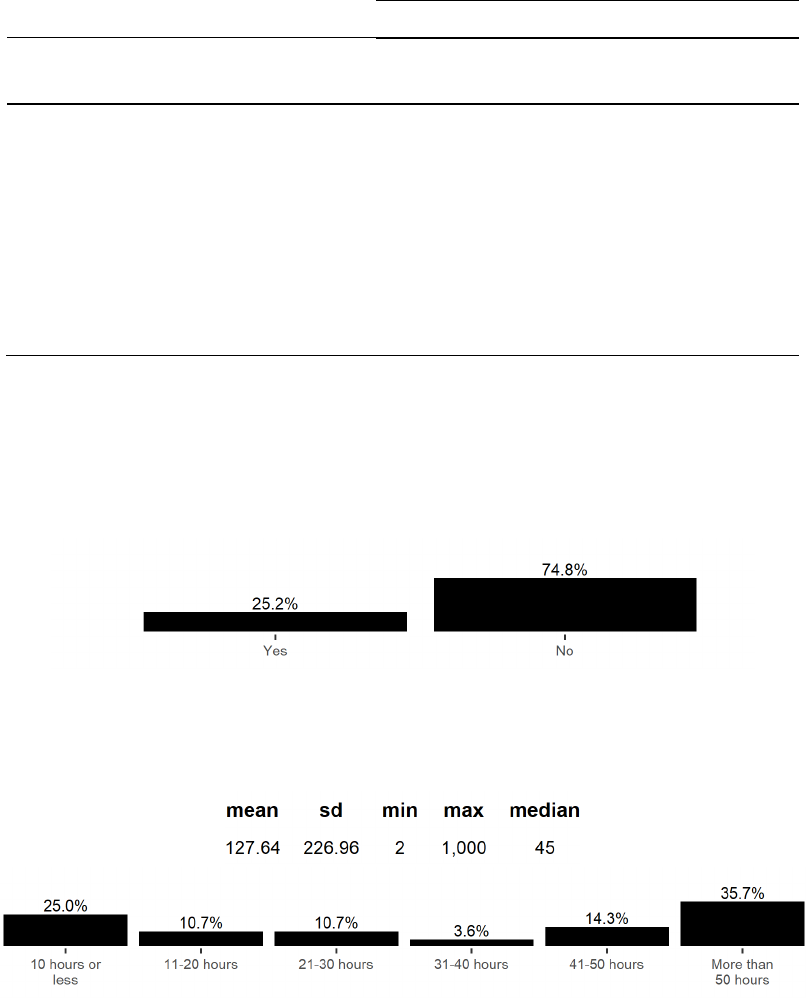
11
Table 7
Minimum Requirements for Instructors (n = 80) and Pilots (n = 123) to Operate Drones at
Respondents’ Organization
Instructors
Pilots
Requirements
Count
(n*)
Percent
(%*)
Count
(n*)
Percent
(%*)
Remote Pilot Certification
69
86.2
111
90.2
Organizational-Specific Training
52
65
72
58.5
Site-Specific Training
28
35
36
29.3
Manufacturer Training
16
20
15
12.2
Other Training
15
18.8
19
15.4
Manned Pilot Certification
14
17.5
11
8.9
N/A or Don’t know
2
2.5
3
2.4
Note: May sum to greater than the number of respondents to the item as the response option was
“select all that apply”, providing an opportunity for respondents to select more than one option.
Figure 5
Required Training Flight Hours upon Hire (n = 115)
Figure 6
If Yes, Flight Hours Required at Hire (n = 28)
12
Training
Organizational Certifications
Forty-one instructors responded to several questions regarding their organization’s
training certifications and materials. Thirty-nine of the 41 instructors responded to whether their
organization holds certifications to train UAS pilots. Eighteen (46.2%)
8
respondents indicated
their organization does hold a training certification. Additionally, 43 (31.9%)
9
respondents
indicated the FAA reviews their organizations’ training material. Thirty-one (22%)
10
respondents
indicated that another government agency (other than the FAA) reviews their organizations’
training material for UAS Pilots/Operators. Many of the respondents cited military branches or
Department of Defense (DoD), with other less common responses including the National
Aeronautics and Space Administration (NASA) and National Oceanic and Atmospheric
Administration (NOAA; see Table B11 in Appendix B, Section C). Twenty-eight (22%)
11
respondents indicated that their organizations’ training material is reviewed by a non-
government organization (see Table B12 in Appendix A, Section D).
Organizational Programs
Instructors and operators associated with a training organization indicated the
certifications and degrees provided by their organization’s training program. These included a
Remote Pilot Certification (14 CFR § 107 compliant), followed by topic-specific certification
(no certification at the completion of program) (Table 8). Top-cited UAS operational training
provided for specific operations included education, emergency response, and infrastructure
inspection (Table 9). Most respondents indicated that they provide manual flight control training
and in-flight automation with pilot controlling takeoff and landing (see Table 10 for other
automation techniques). Respondents’ organizations most commonly provided training to UAS
pilot/operators for multi-rotor (82.5 %) and fixed-wing (61.3%) UAS airframes (Table 11).
Multi-rotor airframes were most commonly equipped with four (95.5%) and six (36.4%) rotor-
blades (Table 12). All respondents indicated that they were provided classroom based training,
and nearly all of the organizations (93.3%) indicated that they performed supervised hand flying
training (Table 13).
8
Respondents only included if indicated instructor as a job role (n = 39); Bar graph is presented in Appendix A,
Section D.
9
Respondents included all job types (n = 135); Bar graph is presented in Appendix A, Section D.
10
Respondents included all job types (n = 141); Bar graph is presented in Appendix A, Section D.
11
Respondents included all job types (n = 140); Bar graph is presented in Appendix A, Section D.

13
Table 8
Certification offered at Training Completion (n = 80)
Respondents
Certifications
Count
(n*)
Percent
(%*)
Remote Pilot Certification (Part 107 Compliant)
40
50.0
We Do Not Offer Any Recognized Certification
25
31.2
Topic-Specific Certification
24
30.0
Four-year Degree from a College or University
12
15.0
Two-year Degree from a College or University
11
13.8
AUVSI TOP Certification
2
2.5
Note: May sum to greater than the number of respondents to the item as the response option was
“select all that apply”, providing an opportunity for respondents to select more than one option.

14
Table 9
Specific Operation Training Provided by Organization (n = 78)
Respondents
Operation Type
Count
(n*)
Percent
(%*)
Education
45
57.7
Emergency Response
41
52.6
Infrastructure Inspection
39
50.0
Academic/Scientific Research
38
48.7
Agriculture
32
41.0
Surveillance
32
41.0
Real Estate
31
39.7
Entertainment and Media
30
38.2
Military
28
35.9
Oil and Gas
27
34.6
Shipping or Cargo Delivery
9
11.5
Other
12
6
7.7
Passenger Transport
0
0.0
Note: May sum to greater than the number of respondents to the item as the response option was
“select all that apply”, providing an opportunity for respondents to select more than one option.
12
See Appendix B, Section C, Table B14 for a list of respondent-provided specific operational training.

15
Table 10
Automation Techniques Taught during Training Programs (n = 80)
Respondents
Automation Techniques
Count
(n*)
Percent
(%*)
Pilot manually controls the drone, which may
include manipulating the actual flight controls,
minimal automation
69
86.2
Pilot programs the flight plan, performs takeoffs
and landings
68
85.0
Pilot monitors flights and only intervenes when
an abnormal event or emergency occurs
52
65.0
Complete autonomy, no human intervention from
takeoff to landing
23
28.7
Note: May sum to greater than the number of respondents to the item as the response option was
“select all that apply”, providing an opportunity for respondents to select more than one option.
Table 11
UAS Platforms Institutes Training Provided (n = 80)
Respondents
Airframe Type
Count
(n*)
Percent
(%*)
Multi-Rotor Wing
66
82.5
Fixed-Wing
49
61.3
Transition (VTOL, Vertical to Horizontal)
23
28.7
Single Rotor Wing
11
13.8
Other
13
2
2.5
Note: May sum to greater than the number of respondents to the item as the response option was
“select all that apply”, providing an opportunity for respondents to select more than one option.
13
See Appendix B, Section C, Table B15 for a list of respondent-provided specific airframe training.

16
Table 12
Number of Rotors for each Multi-Rotor Wing UAS Training Provided (n = 66)
14
Respondents
Number of
Rotor Blades
Count
(n*)
Percent
(%*)
4 rotors
63
95.5
6 rotors
24
36.4
8 rotors
20
30.3
1 rotor
4
6.1
2 rotors
3
4.5
3 rotors
2
3.0
10 rotors
1
1.5
5 rotors
0
0.0
7 rotors
0
0.0
9 rotors
0
0.0
Note: May sum to greater than the number of respondents to the item as the response option was
“select all that apply”, providing an opportunity for respondents to select more than one option.
Table 13
Training Provided by Each Organization (n = 33)
Respondents
Types of Training
Count
(n*)
Percent
(%*)
Classroom Training
33
100.0
Supervised Hands-on Flight Training
31
93.9
Computer-Based Training
20
60.6
Simulation Training
15
17
51.5
Note: May sum to greater than the number of respondents to the item as the response option was
“select all that apply”, providing an opportunity for respondents to select more than one option.
14
Respondents only included those who indicated ‘multi-rotor’ training provided by organization from Table 11.
15
See Appendix B, Section C, Table B16 for a list of respondent-provided simulation type of training provided (n =
17).
17
Pilot Training
Respondents answered questions related to pilot training requirements, such as whether
their training materials were submitted to, or reviewed by the FAA (see Appendix A for the
complete set of training questions and responses). Only 31.9% of respondents indicated yes.
They were also asked whether the training materials were submitted to or reviewed by any other
government agency. Twenty-two percent of the respondents indicated yes. The majority of those
respondents identified a military branch or the DoD as the reviewing agency (see Appendix B
Table B11 for the complete set of responses).
All respondents were asked whether their organization provided training and testing on
specific topics. These topics included: 1) requirement to remain clear of and give way to manned
aircraft; 2) distance limitations from other aircraft; 3) prohibition on unauthorized flight beyond
visual line of sight; 4) requirement to flight plan to avoid public use airports and
approach/departure corridors; 5) requirement to communicate with ATC regarding flight
authorizations; 6) training of visual observers and briefing before each flight; 7) procedures to
cease flight when hazardous conditions arise; and 8) procedures covering carriage of hazardous
materials. Approximately 90% of the respondents indicated their organization provided training
and testing for those topics, with the exception of procedures covering the carriage of hazardous
materials, which was covered by only 69% of the organizations.
UAS Instructors were asked to review a list of training topics and identify which ones
they provided training on, as well as rate their importance. Results are provided in Figure 7 and
Figure 8.
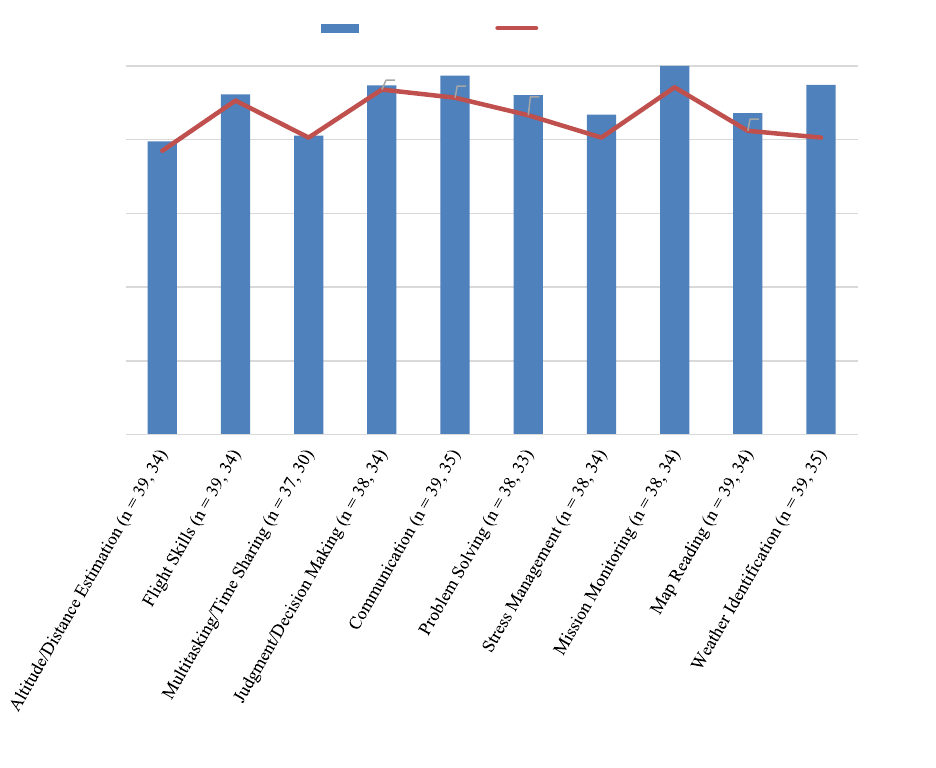
18
Figure 7
Topics Taught by Instructors and Instructors' Ratings of Topic Importance (n = Percent Taught/
n = Importance)
Note: Instructors provided an Importance Rating for each Training Topic on a scale of 1 (Not
Important) to 5 (Extremely Important). Responses may sum to greater than the number of
respondents to the item as the response option was a rate all that apply, providing an
opportunity for respondents to select more than one option. Number of respondents (n) are
reported in pairs for Percent Taught and Importance, respectively.
3.85
4.53
4.03
4.68
4.57
4.33
4.03
4.71
4.12
4.03
0
1
2
3
4
5
0%
20%
40%
60%
80%
100%
Importance Rating
Percent Taught
Training Topics
Percent Taught Importance
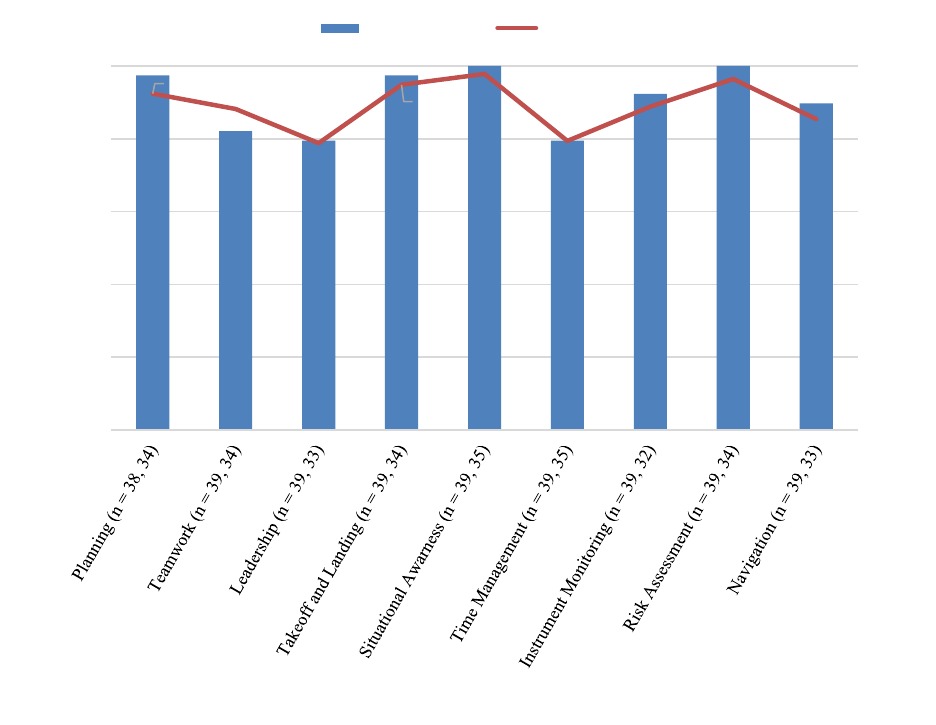
19
Figure 8
Topics Taught by Instructors and Instructors' Ratings of Topic Importance (continued;
n = Percent Taught/n = Importance)
Note: Instructors provided an Importance Rating for each Training Topic on a scale of 1 (Not
Important) to 5 (Extremely Important). Responses may sum to greater than the number of
respondents to the item as the response option was a rate all that apply, providing an
opportunity for respondents to select more than one option. Number of respondents (n) are
reported in pairs for Percent Taught and Importance, respectively.
As can be seen in these figures, all of the training topics included were taught, according
to at least 80% of the respondents. Ratings of importance for each of the topics were closely
correlated with the percentage taught. Three of the topics, Mission Monitoring, Situational
Awareness, and Risk Assessment, were taught by 100% of the respondents. Topics with a lower
percentage of being taught included Altitude/Distance Estimation, Multi-tasking/Time Sharing,
Teamwork, Leadership, and Time Management. The fact that Altitude/Distance Estimation was
not taught at a higher percentage could be due to systems and/or operations that are flown
4.62
4.41
3.94
4.74
4.89
3.97
4.44
4.82
4.27
0
1
2
3
4
5
0%
20%
40%
60%
80%
100%
Importance Rating
Percent Taught
Training Topics
Percent Taught Importance
20
beyond visual line of sight of the crew. Lower percentage scores for the other topics listed here
may be due to many operations requiring only a single or very few crewmembers, thus lessening
the need for crew cooperation skills.
Respondents were asked if a number of topics were taught specifically for UAS
operations. Figure 9 lists those topics, ranked from the highest percentage of coverage to the
lowest. Looking at the results, we see that topics with the lowest percentage of training coverage
deal primarily with the development of skills required in the manual control of the aircraft.
Topics with the highest percentage of training coverage deal with procedures required for
conducting a full operation from beginning to end.
In addition to asking respondents about topics covered during initial training, we also
asked them about recurrent training requirements as well. When asked whether recurrent training
occurred in-house or by a second party, 78.8% of the respondents indicated the recurrent training
was in-house. When asked how often recurrent training was required, responses varied from as
often as weekly, to once every three years. Figure 10 shows the various recurrent training
periods, along with the number and percentage of respondents indicating each period of recurrent
training.
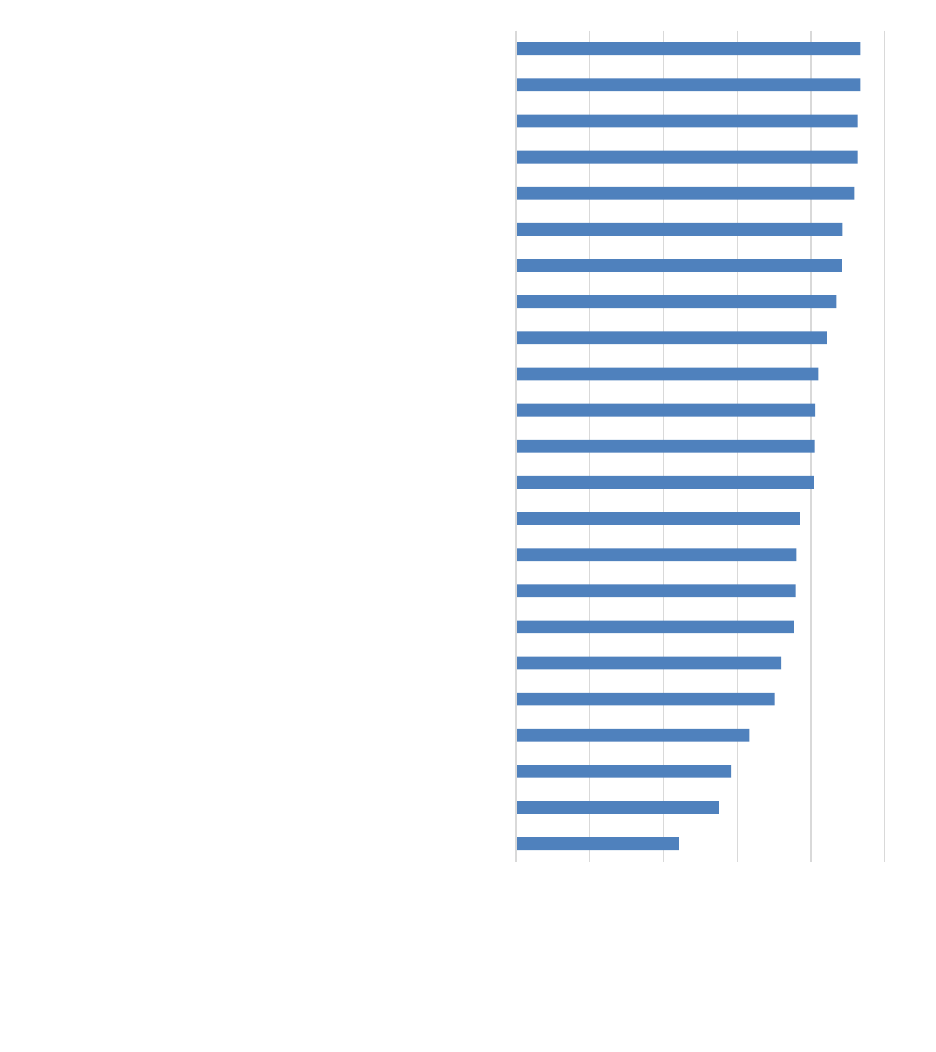
21
Figure 9
Topics Taught to UAS Operator/Pilots Ranked by Percent Taught (n = Provided by Topic)
93.4%
93.4%
92.6%
92.6%
91.8%
88.5%
88.4%
86.9%
84.3%
82.0%
81.1%
81.0%
80.8%
77.0%
76.0%
75.8%
75.4%
71.9%
70.2%
63.3%
58.3%
55.0%
44.2%
0.0% 20.0% 40.0% 60.0% 80.0% 100.0%
Preflight Procedures (n = 121)
Preflight Preparation (n = 121)
FAA Aviation Regulations (n = 122)
Post-Flight Procedures (n = 121)
Safe and Efficient Operation of the Aircraft (n = 122)
Use of Aeronautical Weather Report and Forecast (n = 122)
Radio Communication Procedures (n = 122)
Accident Reporting Requirements (n = 122)
Takeoff, Landing, and Go-Arounds (n = 121)
Effects of Density Altitude on Aircraft Performance (n = 122)
Use of Aeronautical Charts for Navigation (n = 122)
Navigation (n = 121)
Airport Operations (n = 120)
Use of AIM and ACs (n = 122)
Principles of Aerodynamics, Aircraft Engines, and Systems…
Weight and Balance Computations (n = 120)
Radio Communication Procedures (n = 122)
Night Operations (n = 121)
Performance Manuevers (n = 121)
Stall Awareness and Recovery Techniques (n = 120)
Ground Reference Manuevers (n = 120)
Basic Instrument Maneuvers (n = 120)
Slow Flight and (Aerodynamic) Stalls (n = 120)
Percent of Respondants Taught the Training Topic for UAS Operations
Training Topics
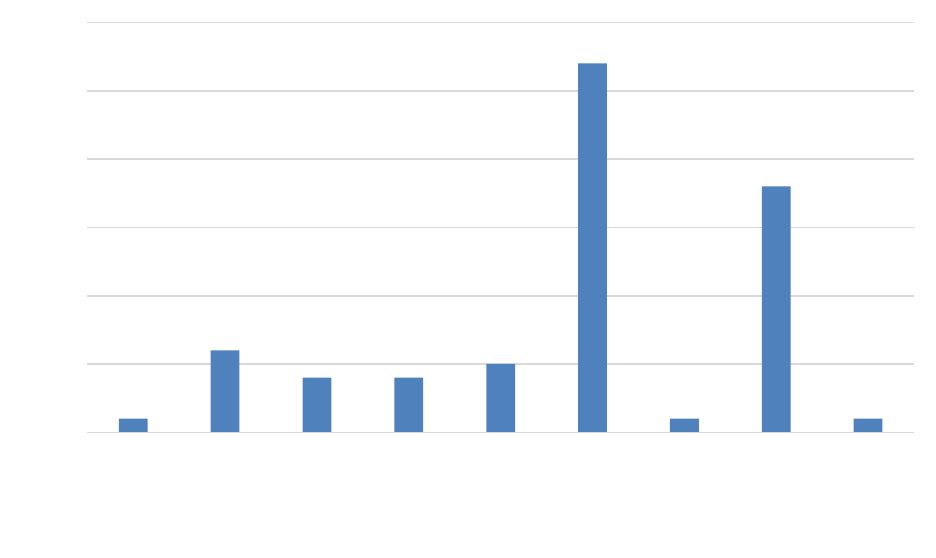
22
Figure 10
Recurrent Training Intervals (n = 67)
As can be seen in Figure 10, the most common recurrent training was once a year
(40.3%), followed by once every two years (26.87%). All other recurrent training periods were a
much smaller percentage.
Discussion
It was not surprising to find a majority of the respondents worked for organizations
employing 10 or fewer pilots (Figure 2). However, it was disappointing that we were not able to
include a larger sample of respondents for the Large UAS Pilot, UAS Cargo operator, or Sensor
Operator categories (see Table 3). Respondents represented sectors engaged in both for-profit
and not-for-profit activities (Table 5). The large majority of respondents (90.5%) indicated
having a remote pilot certificate (14 CFR § 107); in addition, a substantial number (31.6%) had a
manned pilot certificate as well (Table 6). A majority of respondents (56.5%; see Table 4)
indicated their organizations were either conducting or planning UAS operations, and a sizeable
minority of respondents indicated that their organizations were providing (or were planning to
provide) training programs (see Table 9).
Industry type varied, with no apparent standouts as a leading area of employment among
the respondents. Notably, only 3 respondents reported being associated with organizations
expected to be involved with air carrier-like operations and only 23 were associated with
package delivery (Table 5); however, evidence suggests that these particular industries will grow
0
5
10
15
20
25
30
Every Week
(1.49%)
Every
Month
(8.96%)
Every Three
Months
(5.97%)
Every 45
Days
(5.97%)
Every 6
months
(7.46%)
Every Year
(40.3%)
Every 17
months
(1.49%)
Every Two
Years
(26.87%)
Every Three
Years
(1.49%)
Number of Respondents
Recurrent Training Intervals
23
in the future (see Durham et al., 2020; Hu et al., 2022; Torrence et al., 2021). Interestingly, only
about 60% of respondents work for an organization that has established qualification
requirements for crewmembers (Figure 1). Further, there were no established requirements for
instructors across organizations, with some instructors responding “no formal requirements”, but
the large majority (90.2%) stated that a remote pilot certification was required (Table 7).
Responses varied regarding the type of certification offered to students upon completion
of their respective training programs. For instance, only 50% of respondents are awarded a
remote pilot certification upon completion of their training, while 31.2% of the respondents
stated that they were not provided any recognized certification (Table 8). Much of the training
provided by organizations is operationally specific (e.g., agriculture, real estate, infrastructure
inspection; Table 9). Regarding the level of automation taught in the training program, a majority
of respondents (86.2%) indicated their training program primarily taught manual control of the
drone but a similar percentage (85%) indicated training was largely focused on automated
function of the drone, with the exception of the takeoff and landing (Table 10). The types of
systems used for training were mostly multi-rotor or fixed wing systems, with a much smaller
percentage of tiltrotor or single rotor systems (Table 11).
Respondents reported that not only did a majority of organizations require remote pilot
certification (under 14 CFR § 107; 90.2% of respondents), but that their organizations
supplemented Part 107 training with their own organization-specific training (58.5%), and with
additional field training (86.7%). This finding suggests that certification requirements might
have to include operation-specific training or be flexible enough to satisfy requirements across a
broad spectrum of operations.
Training topics were largely similar, as no less than 80% of instructors taught a given
queried topic (Figure 8). Interestingly, the pattern of topics taught by instructors appears to
roughly match the ratings of importance that the instructors attached to each topic, however;
when broken down further there are some notable variations (Figure 9). Some topics, such as
“basic instrument maneuvers” (55%) and “slow flight and (aerodynamic) stalls” (44.2%) were
taught to fewer students than other topics such as “preflight procedures” (93.4%) and “preflight
preparation” (93.4%). Although these differences are driven by different needs of the UAS
industry, further research will be needed to understand whether this finding represents a need for
improvement in training procedures and certifications.
The majority of respondents indicated recurrent training occurred every year (40.3%).
However, Given the rapid changes in UAS operations, the finding that over a quarter of
respondents received training every two years (26.9%) may indicate an opportunity for improved
and up-to-date training practices for these operators.
It should be noted that there are some limitations to the survey itself that must be
acknowledged. The primary limitation of this survey pertains to a variety of job roles that were
under-represented by respondents (e.g., UAS pilots > 55 lbs. and sensor operators) while some
24
job roles were over-represented, such as supervisors and UAS instructors making up
approximately half of all respondents sampled. Further, a portion of the total respondents belong
to an undefined ‘other crewmember’ job role which could have skewed results related to
perceptions and experiences with training, or which could have created other inconsistencies. In
addition to issues with representative sample sizes across job roles, it should be recognized that
the majority of respondents have no more than 10 years of experience in their current job role,
which is both to be expected given the newness of UAS operations, and which could have
skewed results in the current and associated reports.
Conclusion
While there is substantial overlap between UAS training topics and those in manned
aviation, there are important differences as to which topics are given more emphasis. Many
topics dealing with flight control skills are not emphasized in UAS training curricula as much as
they are in manned flight training. This finding is most likely due to many current UAS being
highly automated, with a large number containing no reversionary modes that require or even
allow manual control of aircraft surfaces. While this approach requires higher levels of reliability
for automated functionality to maintain a proper level of safety, it also reduces training
requirements involving hand-eye coordinated skills.
A second important finding regarding training was the substantial number of
organizations that focus on some level of operation-specific training topics. At present, besides
the requirements established in 14 CFR § 107, there are no training regimes that allow a graduate
of a training program to be prepared to operate across a large variety of operations without some
type of operation-specific training. This finding speaks more to the large variety of operations,
systems, and pilot/system interface designs than anything else. To date, there are no established
control station design standards. This lack of standardization almost guarantees that training on
one system will not transfer to other systems. It also creates the possibility of negative transfer
between systems, which could create potential safety issues. This possibility becomes more
critical as the industry eventually transitions to air carrier-like operations, especially those
involving passenger transport.
One approach to handling the large variety of systems and system interfaces suggested by
an SAE International working group (SAE International, 2016) was to establish a set of
restrictions that could be placed on a UAS pilot certification. Examples of these restrictions
include Off-Airport Operations Only, Daytime Operations Only, Automated Landings Only,
Automated Takeoffs Only, and others. The reader is directed to SAE document ARP5707 (2016)
for more detailed information.
In general, the results of the survey suggest an important role for regulators to provide
guidance for how UAS operators should be trained. Interest among respondents to provide
training programs is likely due to the growing interest and need in providing UAS services. This,
25
in turn, suggests a role for FAA to provide guidance and regulations to ensure a safe NAS
complemented with operators trained with necessary and sufficient Knowledge, Skills, and
Abilities as UAS operations increase over time.
Recommendations include frequent assessment of industry SMEs to identify and
understand opportunities for training, and guidance for organizations based on identified best
practices. The development and introduction of new levels of certification will also be needed in
the future to ensure proper training and knowledge across operators.
Overall, the results suggest that organizations recognize the importance of the FAA’s Part
107 certificate, but that real-world operations requires further training provided by organizations.
It will be necessary to consider type certifications for UAS operations and systems as there are
for manned aircraft operations. For example, a commercial transport pilot requires a different
certification than a general aviation pilot. Such considerations will also be required for
commercial UAS operations. Different skillsets are required and therefore different certification
should be considered for operators carrying large cargo versus operators performing aerial
photography. Under current regulations, UAS air carrier operators must apply for an airline
certification but as demonstrated by the results of the survey the skills and safety checks between
manned air carrier operations and UAS are different and thus may require a new type of
certification process.
The variety of industries represented by respondents suggests that UAS are operating in
very different use cases. When coupled with the finding that organizations are requiring further
organization-specific training for their UAS pilots, the results overall suggest that certification
requirements may need to more nuanced, with different training requirements perhaps dependent
on use case.

26
References
Durham, J. D., Hu, P. T., Baumgartner, H. M., & Nesthus, T. E. (Under Review). UAS air
carrier operations survey: Fatigue. Federal Aviation Administration, Office of
Aerospace Medicine.
Durham, J. D , Mofle, T. C., Nesmith, B. L., Hu, P., Fercho, K. A., & Nesthus, T. E. (2020).
Literature review and annotated bibliography (1990 – 2019): Duty time, shift work, and
operator fatigue for consideration of unmanned aircraft systems in air carrier operations
(Report No. DOT/FAA/AM-21/21). Federal Aviation Administration, Office of
Aerospace Medicine.
https://www.faa.gov/sites/faa.gov/files/data_research/research/med_humanfacs/oamtechr
eports/202121.pdf
Hu, P. T., Nelson, B., Nesmith, B. & Williams, K. W. (2022). Annotated bibliography (1997 –
2021): Crew and staffing requirements of unmanned aircraft systems in air carrier
operations (Report No. DOT/FAA/AM-22/06). Federal Aviation Administration, Office
of Aerospace Medicine. https://www.faa.gov/sites/faa.gov/files/2022-
07/Annotated%20Bibliography%20%281997-2021%29-
%20Crew%20and%20Staffing%20Requirements%20of%20Unmanned%20Aircrafts%20
Systems%20in%20Air%20Carrier%20Operations.pdf
Nesthus, T. E, Fercho, K. A., Durham, J. D., Mofle, T. C., Nesmith, B. L., & Hu, P. (2021).
Summary final report for unmanned aircraft systems in air carrier operations: UAS
operator fatigue (Report No. DOT/FAA/AM-21/16). Federal Aviation Administration,
Office of Aerospace Medicine.
https://www.faa.gov/data_research/research/med_humanfacs/oamtechreports/2020s/medi
a/202116.pdf
SAE International. (2016). Pilot training recommendations for Unmanned Aircraft Systems
(UAS) commercial operations (Aerospace Recommended Practice Document No.
ARP5707). SAE International.
Torrence, B., Nelson, B., Thomas, G. F., Nesmith, B. L., Williams, K. W. (2020). Annotated
bibliography (1990 – 2019): Knowledge, skills, and tests for Unmanned Aircraft Systems
(UAS) air carrier operations. Federal Aviation Administration, Office of Aerospace
Medicine. https://rosap.ntl.bts.gov/view/dot/57233
Williams, K. W., Hu, P. T., & Mofle, T. C. (Under Review-a). UAS air carrier operations
survey: Crew and staffing requirements. Federal Aviation Administration, Office of
Aerospace Medicine.
Williams, K. W., Mofle, T. C., & Hu, P. T. (Under Review-b). UAS air carrier operations
survey: KSAO requirements. Federal Aviation Administration, Office of Aerospace
Medicine.
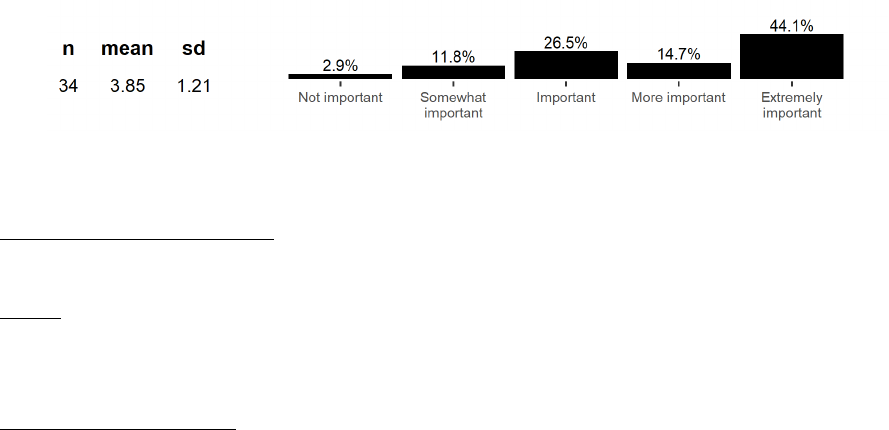
A-1
Appendix A.
Survey Questions Related to UAS Training
The Federal Aviation Administration’s (FAA) Civil Aerospace Medical Institute (CAMI)
constructed a survey to gather information about the current state of Unmanned Aircraft Systems
(UAS) operations considered relevant to air carrier flight activities. The survey polled a variety
of people involved in commercial UAS activities from frontline workers to high-level managers
to educators. The survey examined areas related to UAS operations such as crew and staffing,
operator knowledge and skills, duty/rest, and training requirements.
An open invitation to complete the online survey was distributed via email to a sample of
potential respondents with UAS industry, training, or crew experience (N=2,524). Of those, 97
invitations were returned undeliverable resulting in 2,427 invitations delivered directly to
potential respondents. Invitees were encouraged to share the open invitation with other UAS
professionals who met eligibility requirements. Invitees were informed that survey completion
was voluntary and that a third-party contractor would compensate respondents for completing the
survey.
Overall, 173 respondents met the requirements for inclusion: 1) work as crew that
operates/plans to operate UAS, or provides UAS training; or 2) work for an organization with
UAS pilot qualification requirements; and 3) the organization had more than 1 employee. This
report summarizes the survey results for the Training Requirements items.
Example of Report Format
C8b. How important is altitude and distance estimation for your trainees?
Definitions of Descriptive Statistics
Number of Respondents (n): The number of respondents who provided a valid response for an
item.
Mean: The arithmetic average, calculated as the sum of response values for an item divided by
the number of respondents (n) who answered that item. Not applicable (N/A), Don't know, and
No experience to say responses are excluded from calculations and reporting.
Standard Deviation (sd): The measure of dispersion, or spread of values around the mean.
Smaller standard deviation values indicate higher levels of agreement among respondents. Not
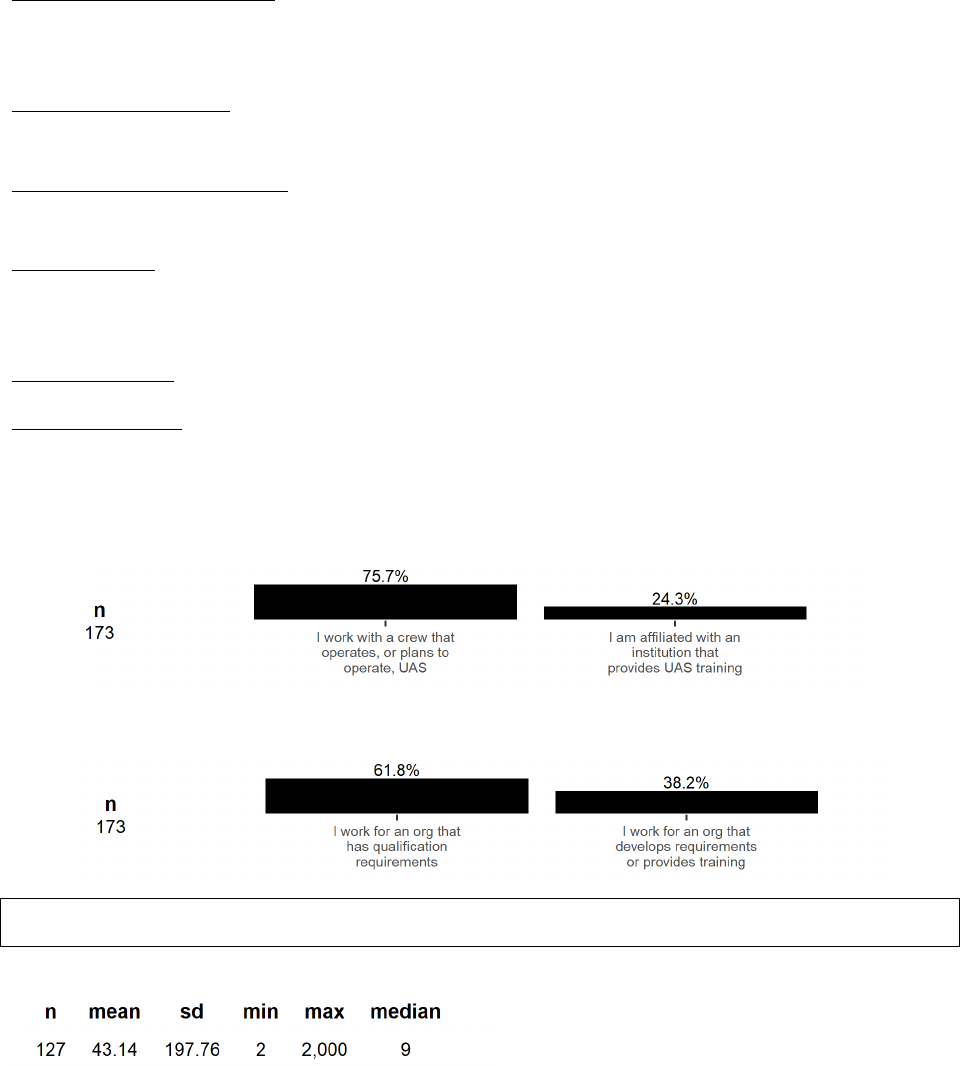
A-2
applicable (N/A), Don't know, and No experience to say responses are excluded from
calculations and reporting.
Response Distribution (%): The proportion, or percentage, of respondents that selected a given
response across item response options. Not applicable (N/A), Don't know, and No experience to
say responses are excluded from calculations and reporting.
Frequency Count (n*): The number of times a response option is selected. A frequency count for
‘mark all that apply’ items may sum to greater than the number of respondents (n).
Percent (%) of Respondents: The percent is calculated by dividing the frequency count by the
number of respondents and multiplying by 100.
Median (med): The exact middle data point calculated in a set of rank-ordered values. It is less
affected by extreme values in comparison to the mean, and thus, is relied upon when extreme
values are present in a data set (e.g., total flight hours flown).
Minimum (min): The lowest, or minimum, value provided.
Maximum (max): The highest, or maximum, value provided.
Respondent Eligibility
1. Which of these statements best applies to you?
2. Do you work for an organization with established UAS pilot qualification requirements?
Results for Item 3 include only respondents who indicated ‘I work with an organization or crew that operates, or plans to
operate, unmanned aircraft systems (UAS)/drones)’ on Item 1.
3. How many drone operators/pilots does your organization currently employ?
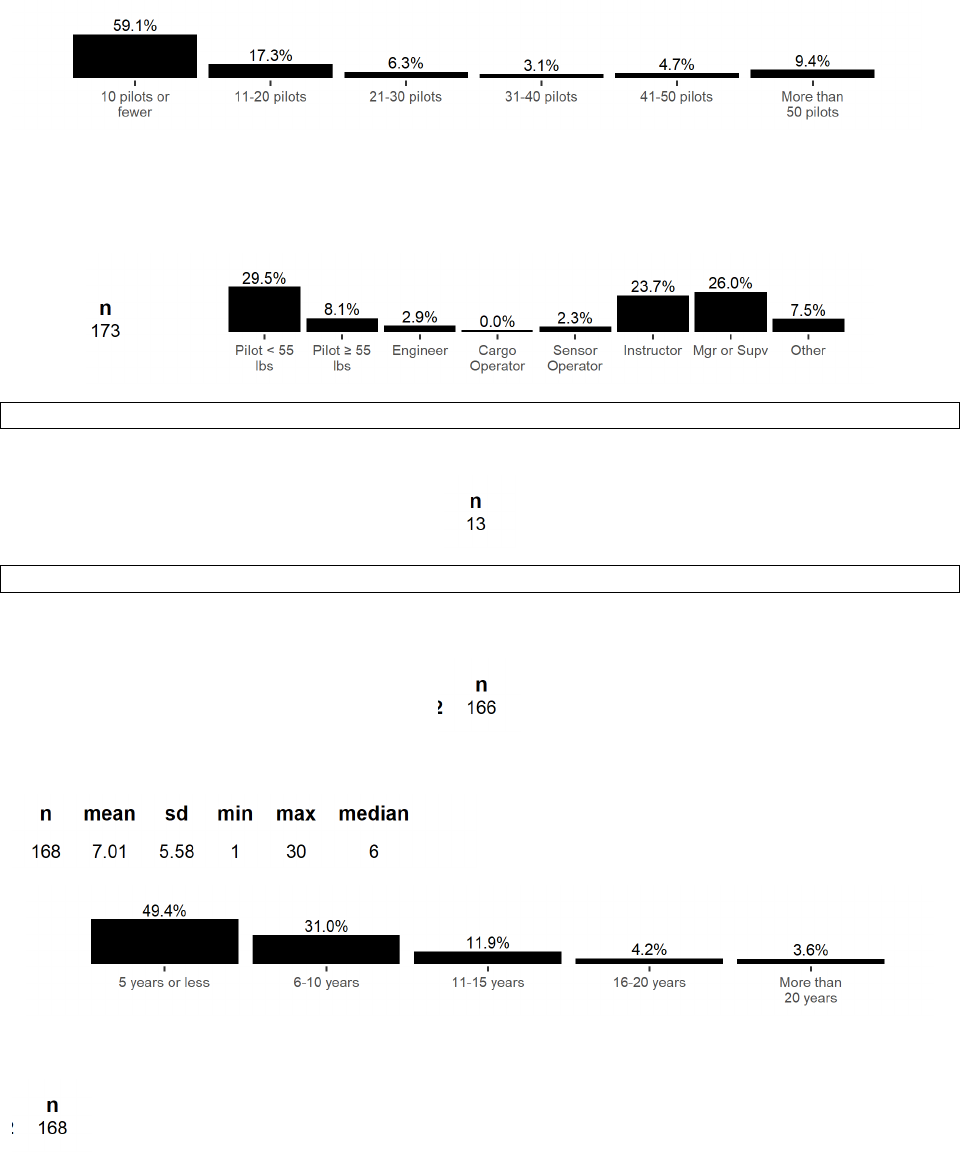
A-3
Section A. Demographics
A1. Currently, what is your primary job role? (required)
Results for Item A1a include only respondents who indicated ‘Other’ on Item A1 and provided a written response.
A1a. In brief, please describe your job role: (See Appendix B. Section A. Demographics for a list of responses)
Results for Item A1b include only respondents who provided a written response.
A1b. In brief, please describe the main responsibilities of your job: (See Appendix B. Section A. Demographics
for a list of responses)
A2. How many years of experience do you have with your current role(s)?
A3. The organization that I work for is, or plans to be, a: [mark all that apply] (required)

A-4
n* may sum to greater than the number of respondents to the item (n) due to multiple responses. The %* of respondents is based on the number of
respondents to the item (n).
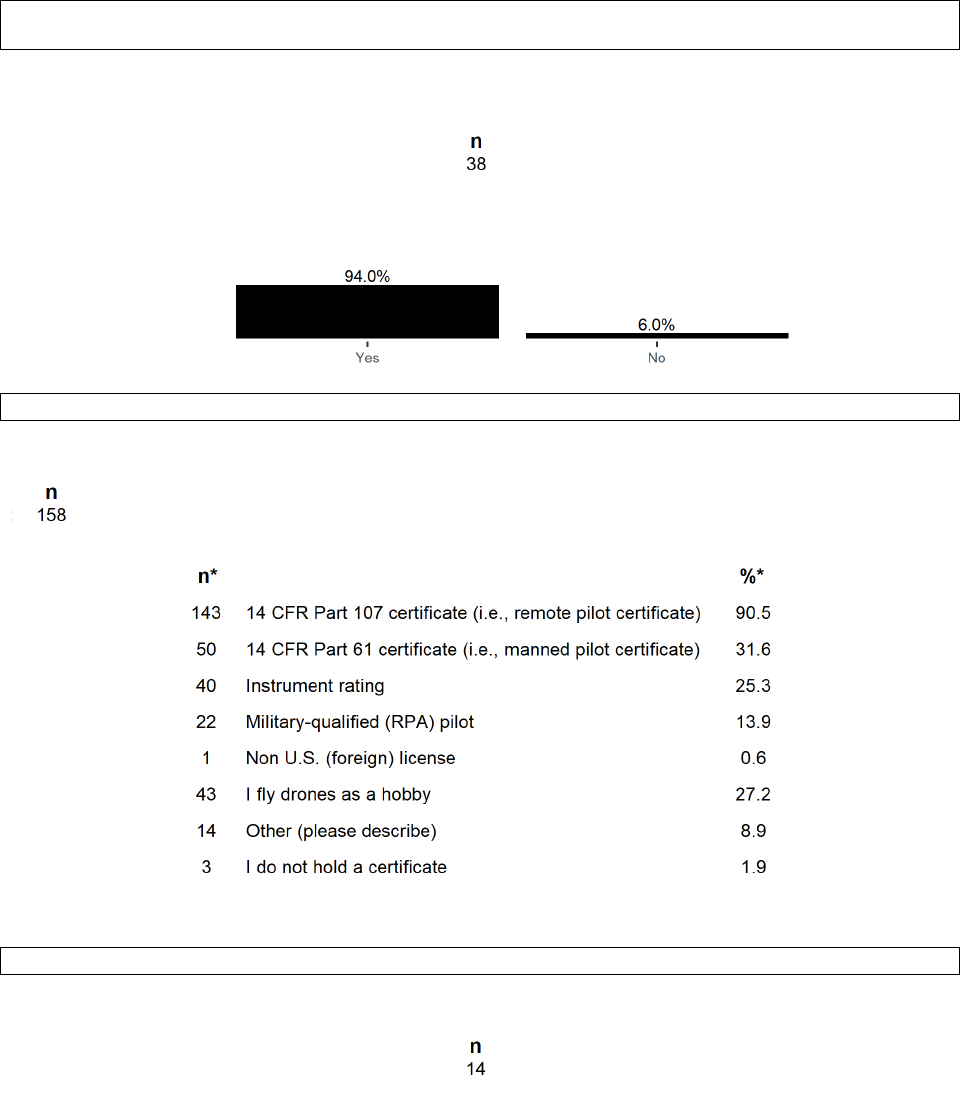
A-5
Results for Item A4 include only respondents who indicated ‘Works with drones, but none of the above’ on Item A3 and
provided a written response.
A4. In what capacity does your organization work with drones? (See Appendix B. Section A. Demographics for a
list of responses)
A6. Are you currently trained, licensed, or certified to fly a drone?
Results for Item A7 through Item A8 include only respondents who indicated ‘Yes’ on Item A6.
A7. Which of these certificates do you hold? [mark all that apply]
n* may sum to greater than the number of respondents to the item (n) due to multiple responses. The %* of respondents is based on the number of
respondents to the item (n).
Results for Item A7a include only respondents who indicated ‘Other’ on Item A7 and provided a written response.
A7a. Other certificate(s), please describe: (See Appendix B. Section A. Demographics for a list of responses)
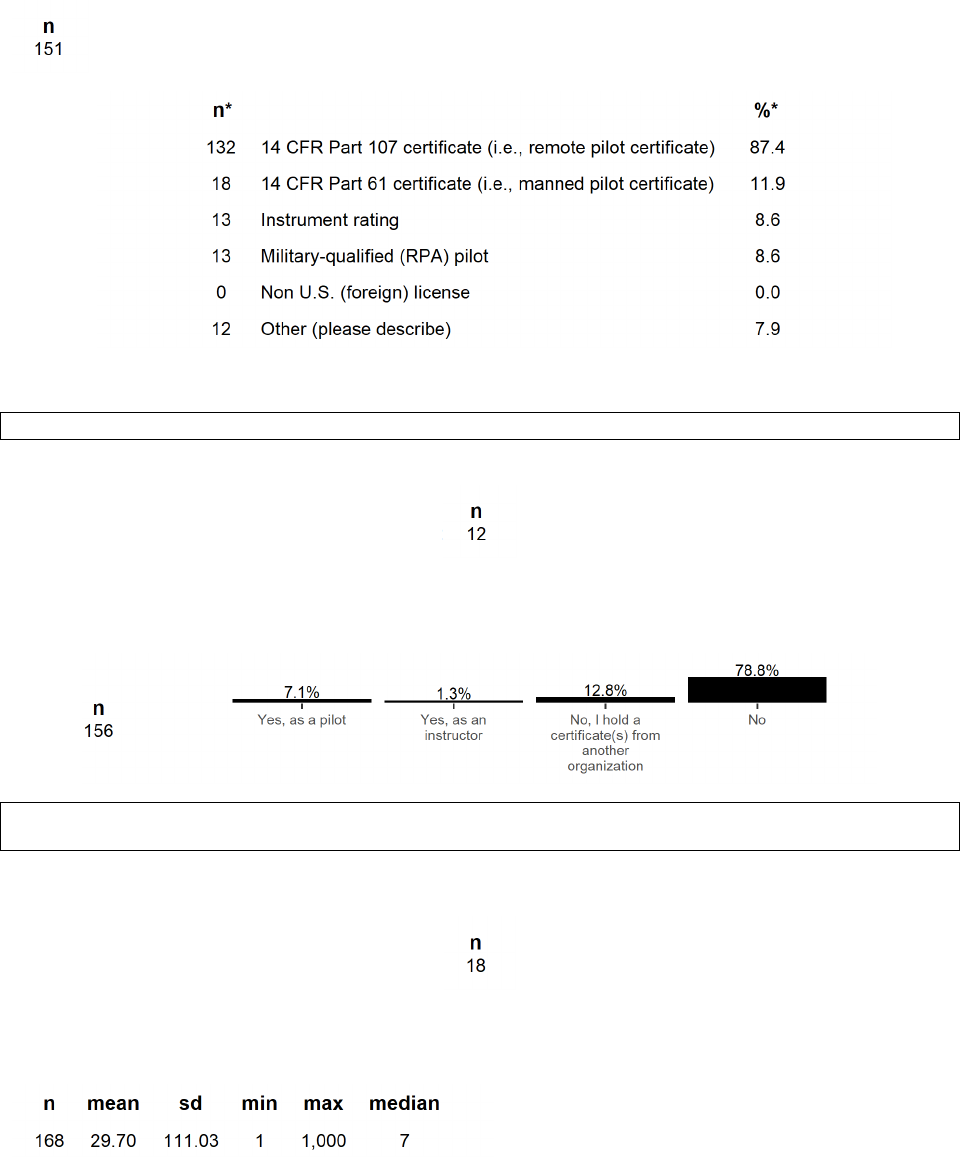
A-6
A8. Which of these certificates are required for your job? [mark all that apply]
A8
n* may sum to greater than the number of respondents to the item (n) due to multiple responses. The %* of respondents is based on the number of
respondents to the item (n).
Results for Item A8a include only respondents who indicated ‘Other’ on Item A8 and provided a written response.
A8a. Other certificate(s), please describe: (See Appendix B. Section A. Demographics A for a list of responses)
A9. Do you hold a Trusted Operator certificate from the Association for Unmanned Vehicle
Systems International (AUVSI)?
Results for Item A9a include only respondents who indicated ‘No, I hold a certificate(s) from another organization’ on
Item A9 and provided a written response.
A9a. What certificate(s) do you hold from another organization? Please describe. (See Appendix B.
Section A. Demographics for a list of responses)
A10. What is your estimate of the number of certified UAS/drone pilots employed by the
organization where you work?
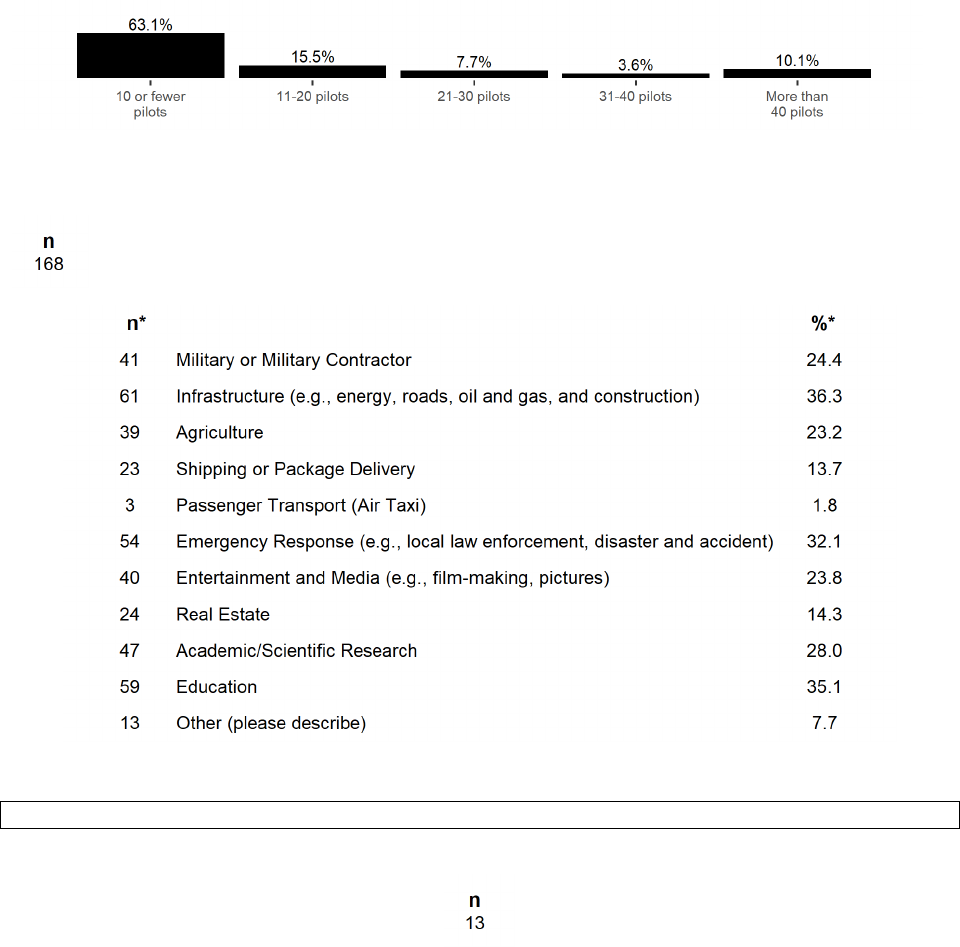
A-7
A5. Please select the industry or sector that best describes the current or planned drone
operations of your organization: [mark all that apply] (required)
n* may sum to greater than the number of respondents to the item (n) due to multiple responses. The %* of respondents is based on the number of
respondents to the item (n).
Results for Item A5a include only respondents who indicated ‘Other’ on Item A5 and provided a written response.
A5a. Other industry or sector, please describe: (See Appendix B. Section A. Demographics for a list of responses)

A-8
Section B. Air Carrier Operational Considerations for Unmanned Aircraft Systems
Results for Item B1 through Item B2 include only respondents who indicated ‘Passenger Transport (Air Taxi)’ on Item A5.
B1. If remote pilot control is possible, what should be the lowest level of flight control
automation available to the remote pilot?
B2. If a remote pilot is monitoring multiple aircraft, how many aircraft should be monitored
(maximum)?
Section C. Qualification Requirements
Results for Item C6 include only respondents who indicated ‘Instructor’ on Item A1 and provided a written response.
C6. What are your organization’s requirements to become an instructor? (See Appendix B. Section B.
Qualification Requirements for a list of responses)
C33. What are the minimum requirements necessary for instructors to operate drones at your
organization? [mark all that apply]
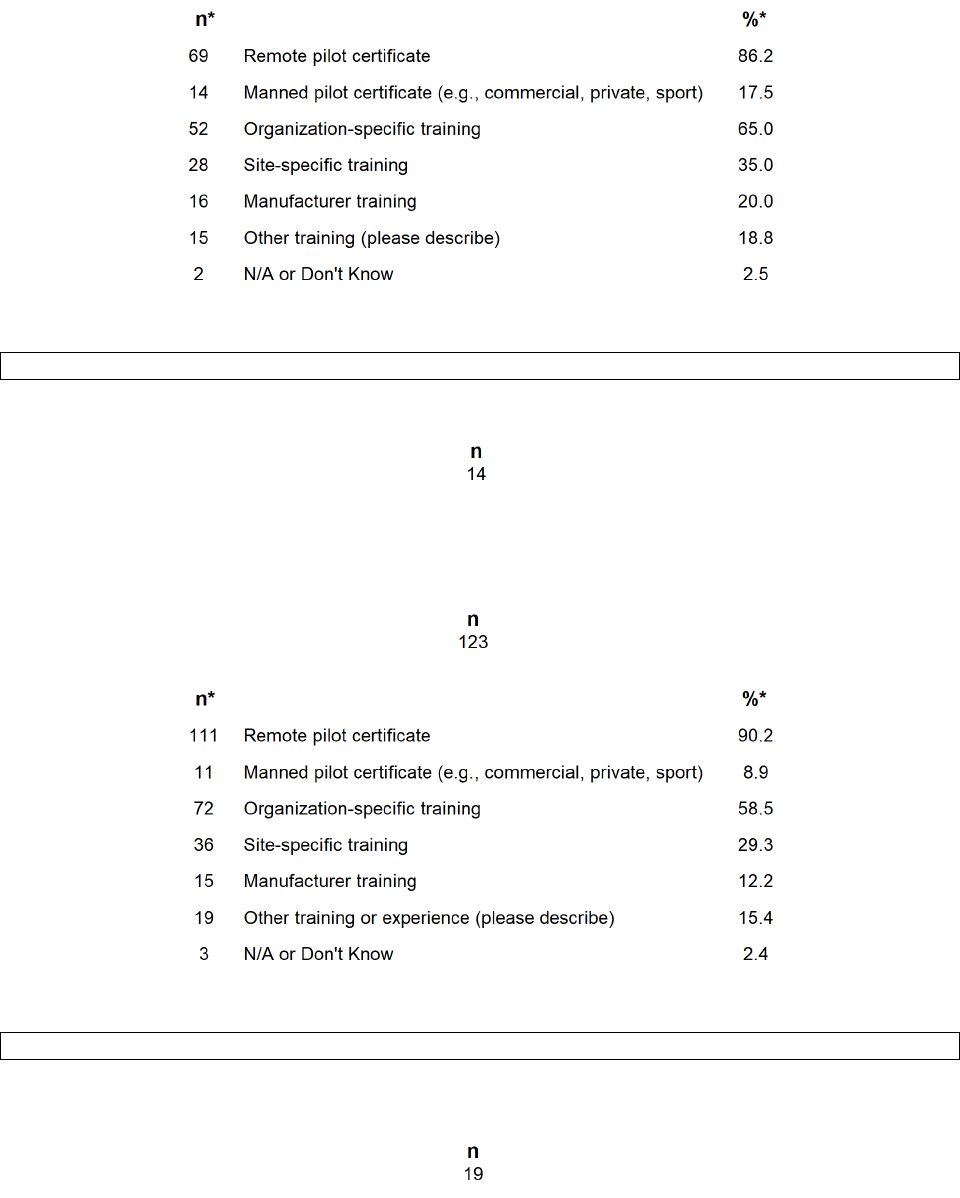
A-9
n* may sum to greater than the number of respondents to the item (n) due to multiple responses. The %* of respondents is based on the number of
respondents to the item (n).
Results for Item C33a include only respondents who indicated ‘Other’ on Item C33 and provided a written response.
C33a. Other, please describe: (See Appendix B. Section B. Qualification Requirements for a list of responses)
C34. What are the minimum requirements necessary for drone pilots at your organization?
[mark all that apply]
n* may sum to greater than the number of respondents to the item (n) due to multiple responses. The %* of respondents is based on the number of
respondents to the item (n).
Results for Item C34a include only respondents who indicated ‘Other’ on Item C34 and provided a written response.
C34a. Other training or experience, please describe: (See Appendix B. Section B. Qualification Requirements for a list of
responses)
C35. Does your organization require a minimum number of training flight hours at hire?
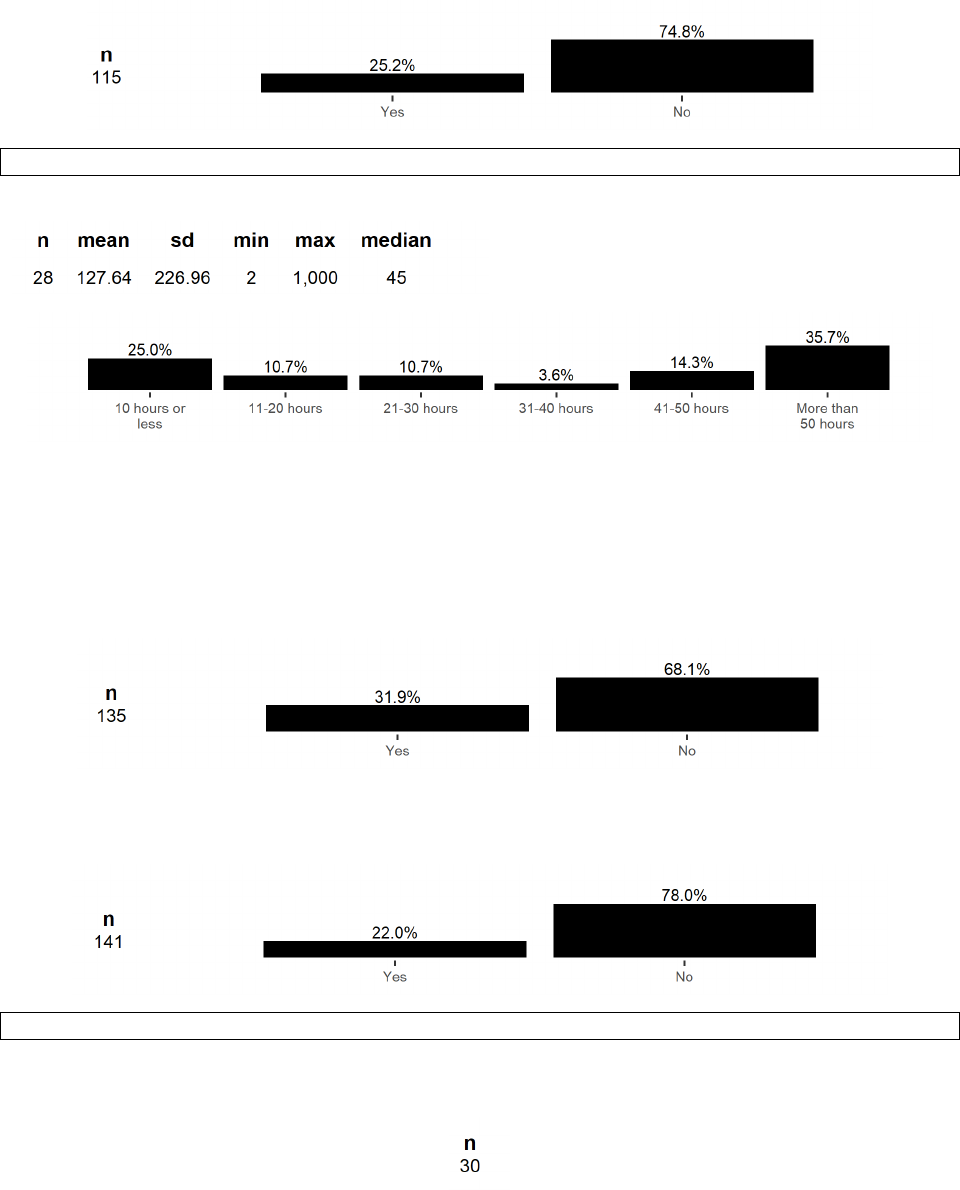
A-10
Results for Item C35a include only respondents who indicated ‘Yes’ on Item C35.
C35a. If Yes, what number of flight hours is required?
Section D. Training
D1. Are your drone pilot education and training materials currently submitted to, or reviewed by,
the FAA?
D2. Are your drone pilot education and training materials currently submitted to, or reviewed
by, another government agency (not the FAA)?
Results for Item D2a include only respondents who indicated ‘Yes’ on Item D2 and provided a written response.
D2a. Please indicate which government agency reviews your training materials. (See Appendix B. Section
C. Training for a list of responses
)
D3. Are your drone pilot education and training materials currently submitted to, or reviewed
by, a non-government agency?

A-11
Results for Item D3a include only respondents who indicated ‘Yes’ on Item D3 and provided a written response.
D3a. Please indicate which non-government agency reviews your training materials. (See Appendix B.
Section C. Training for a list of responses)
D4. Is initial training provided within 14 days of hiring a new employee?
D5. Does your organization train and test drone pilots in the following specific areas?
A requirement to remain clear of and give way to manned aircraft at all times
D5. Does your organization train and test drone pilots in the following specific areas?
Distance limitations from other aircraft covering takeoff, landing and in-flight phases,
obstruction clearance limitations, and airspeed limitations
Prohibition on unauthorized flight beyond visual line of sight of the UAS pilot, and a means to
detect-and-avoid other aircraft
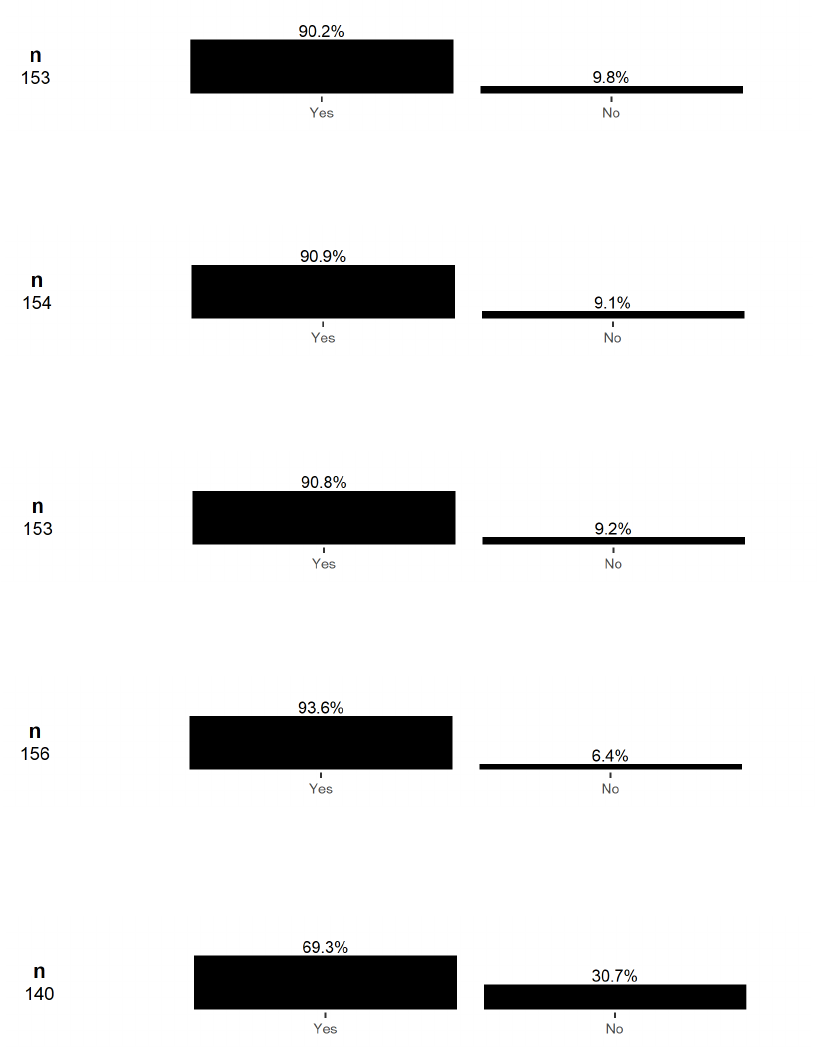
A-12
A requirement to plan a route of flight that avoids public use airports and approach and departure
corridors, unless prior authorization is obtained, and alternatives if a flight cannot be completed
as planned
A requirement for remote pilots to communicate with and obtain any necessary authorization
from air traffic control or the controlling agency for each flight in controlled airspace
A requirement that any visual observers be trained by the operator and briefed on the operation
by the pilot in command before each flight
Procedures to cease flight when hazardous conditions arise, or communications or control
become degraded, without causing danger to other persons
D5. Does your organization train and test drone pilots in the following specific areas?
Standards and procedures covering the carriage of hazardous materials
Security procedures and security risks assessments
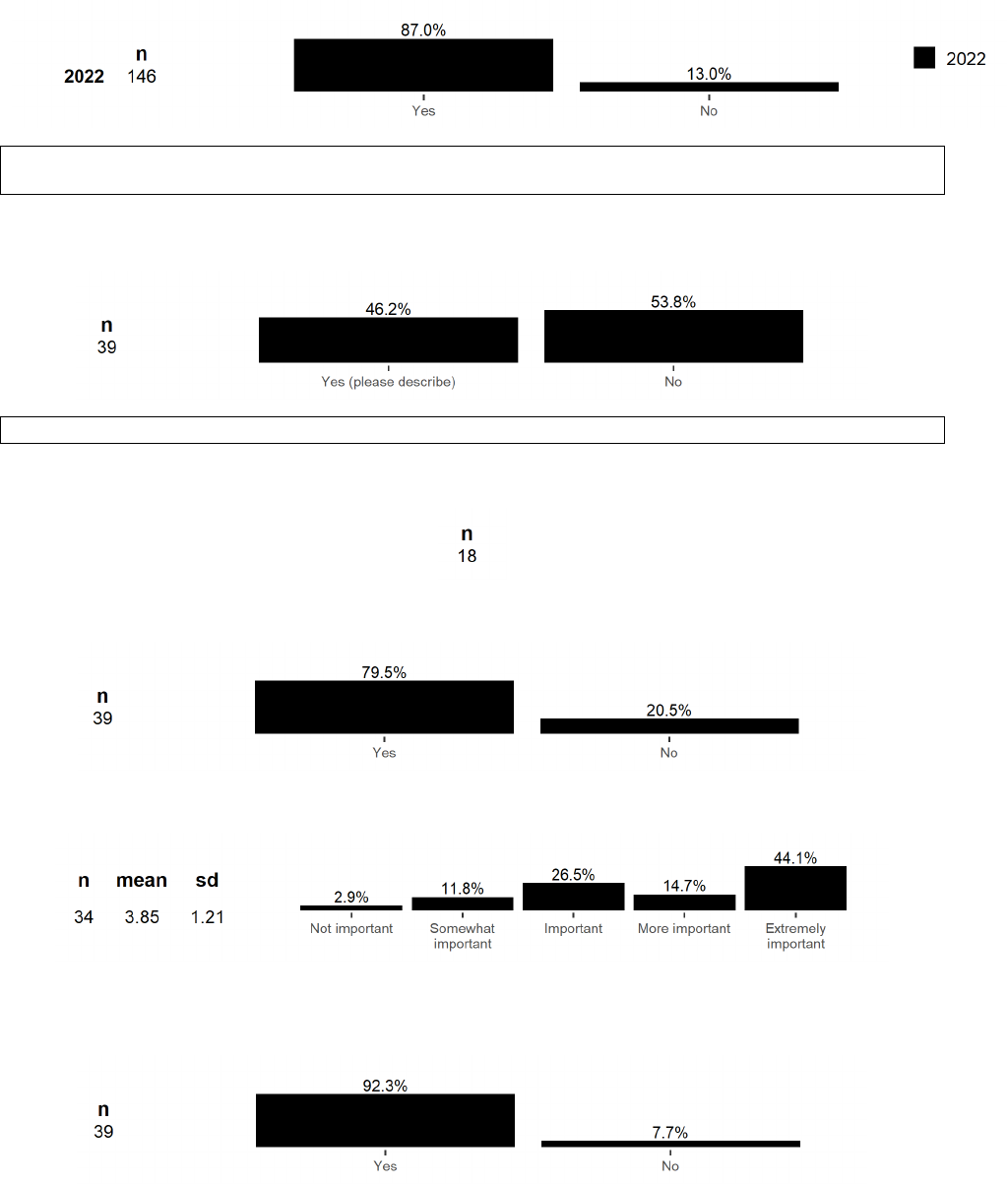
A-13
Results for Item D7 through Item D26b include only respondents who indicated ‘Instructor (teaches about drones,
regulations, best practices, etc.)’ on Item A1.
D7. Does your organization hold any certifications or authorizations for training drone pilots
and/or operators?
Results for Item D7a include only respondents who indicated ‘Yes’ on Item D7 and provided a written response.
D7a. What kind of certificates or authorizations does your organization hold? (See Appendix B. Section C.
Training for a list of responses)
D8a. Do your trainees receive training in altitude and distance estimation?
D8b. How important is altitude and distance estimation for your trainees?
D9a. Do your trainees receive training in flight skill (e.g., changing direction, maintaining
speed)?
D9b. How important is flight skill (e.g., changing direction, maintaining speed) for your
trainees?
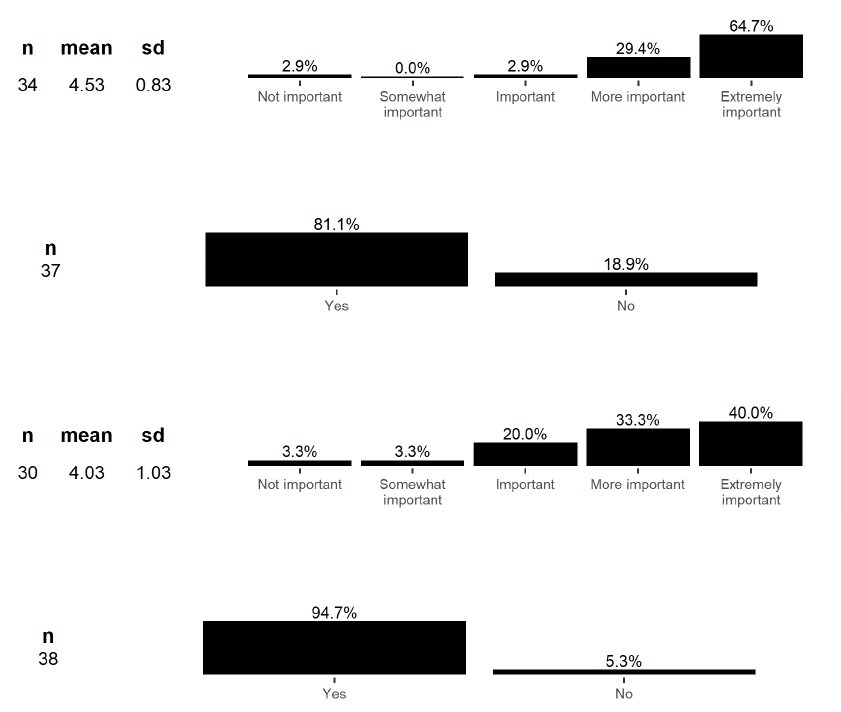
A-14
D10a. Do your trainees receive training in multitasking and timesharing?
D10b. How important is multitasking and timesharing for your trainees?
D11a. Do your trainees receive training in judgment and decision-making?
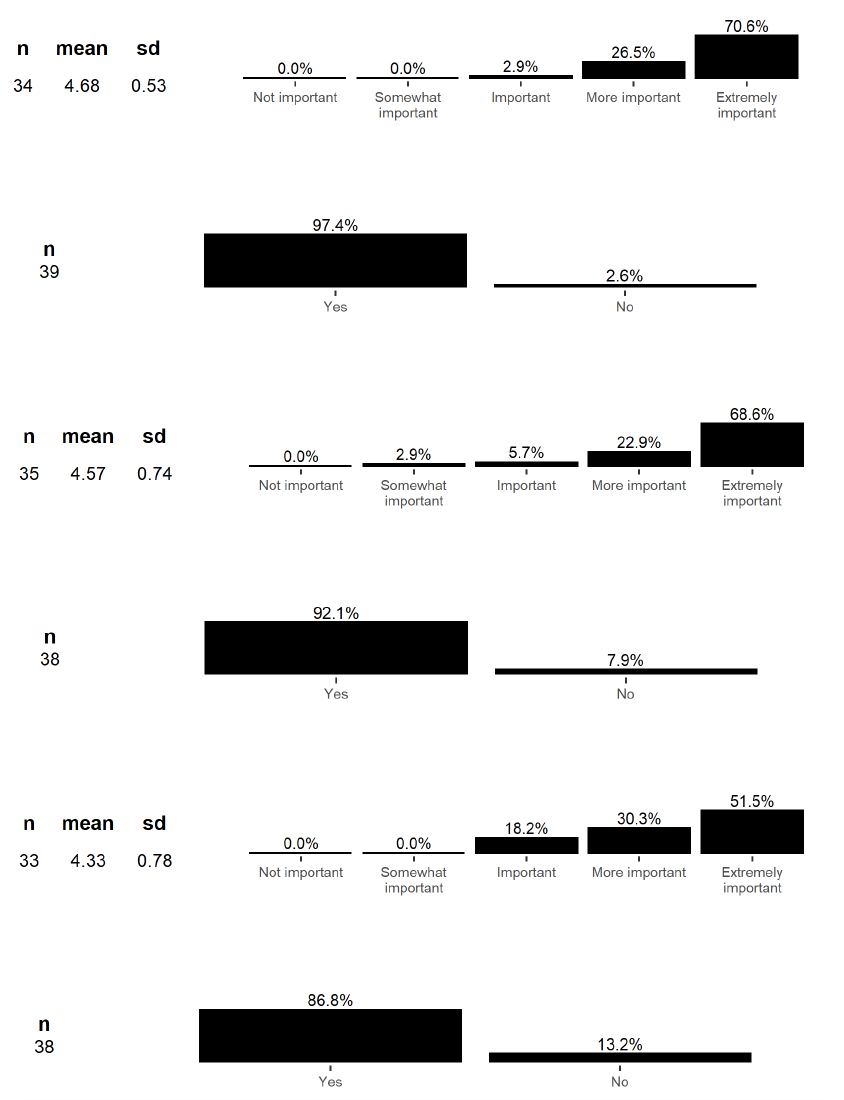
A-15
D11b. How important is judgment and decision-making for your trainees?
D12a. Do your trainees receive training in communication?
D12b. How important is communication for your trainees?
D13a. Do your trainees receive training in problem-solving?
D13b. How important is problem-solving for your trainees?
D14a. Do your trainees receive training in stress management?
D14b. How important is stress management for your trainees?
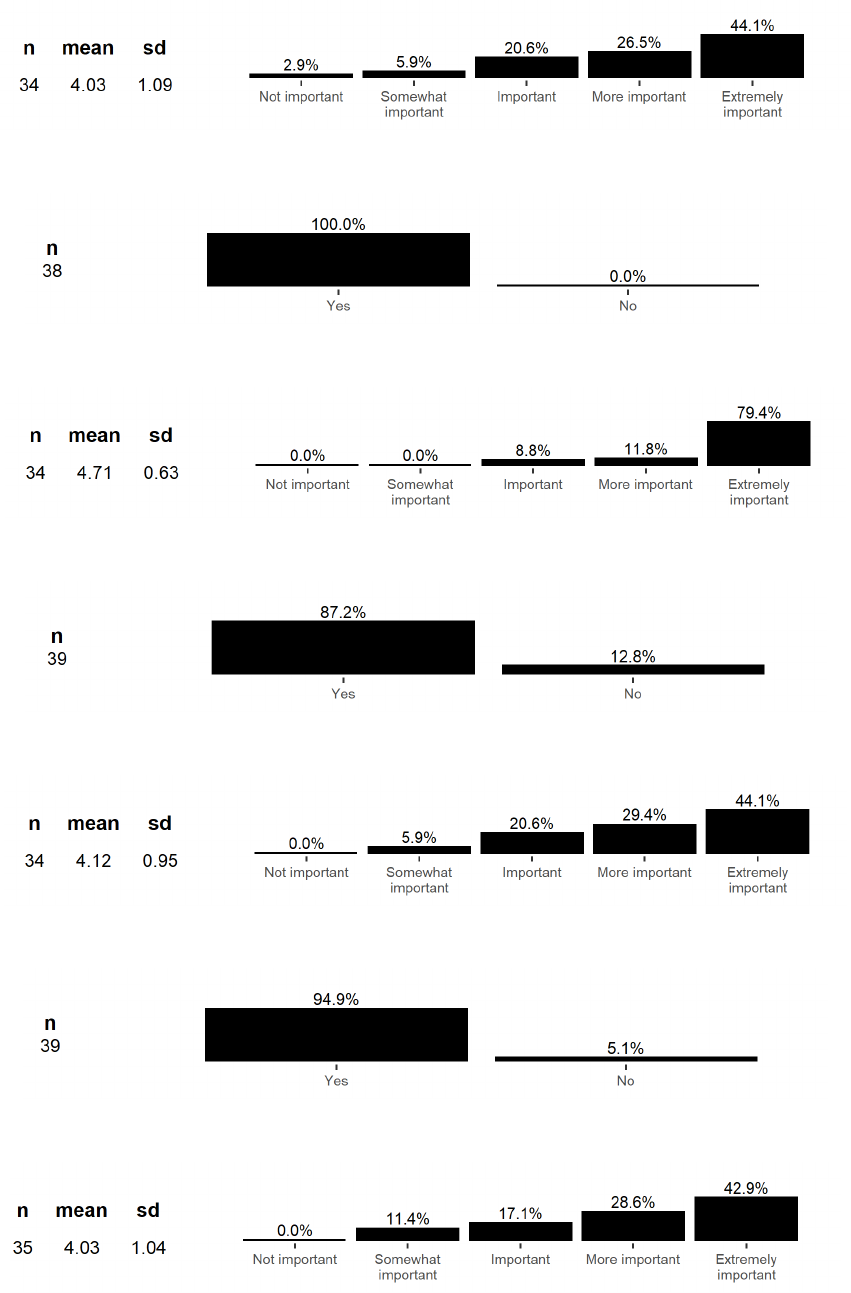
A-16
D15a. Do your trainees receive training in mission monitoring?
D15b. How important is mission monitoring for your trainees?
D16a. Do your trainees receive training in map reading?
D16b. How important is map reading for your trainees?
D17a. Do your trainees receive training in weather identification?
D17b. How important is weather identification for your trainees?
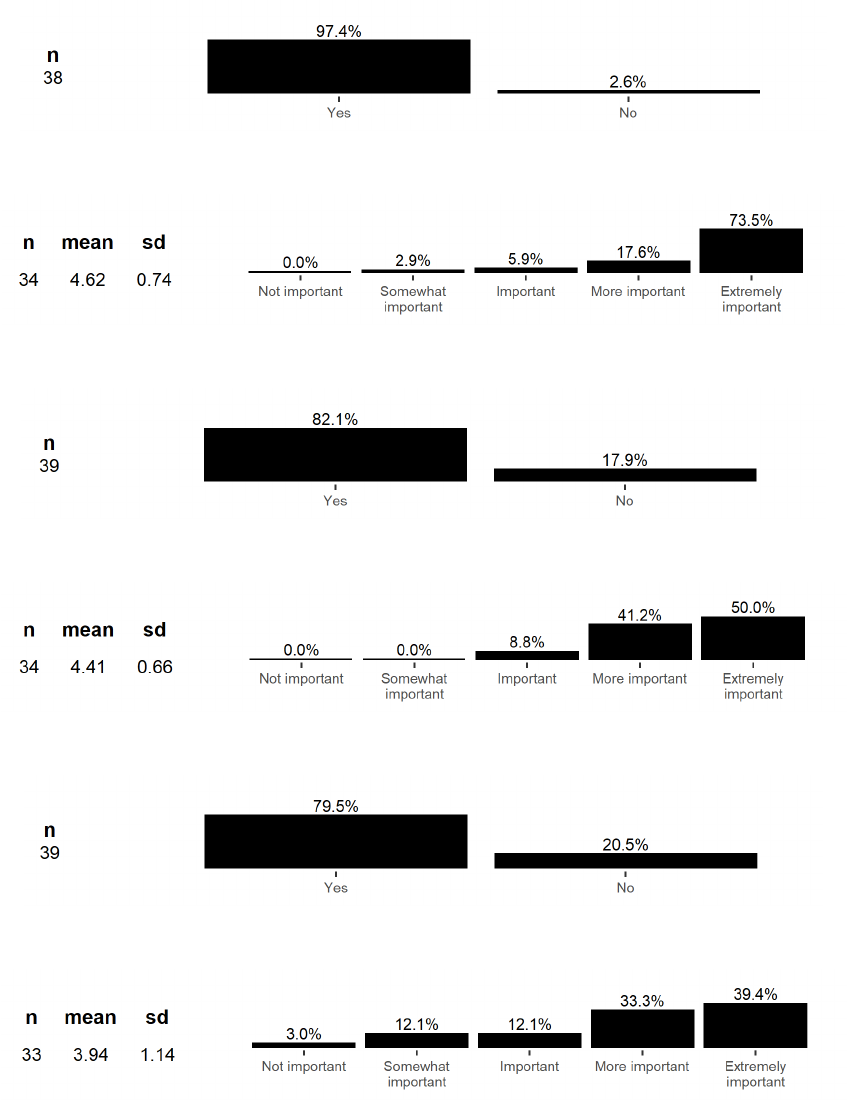
A-17
D18a. Do your trainees receive training in planning?
D18b. How important is planning for your trainees?
D19a. Do your trainees receive training in teamwork?
D19b. How important is teamwork for your trainees?
D20a. Do your trainees receive training in leadership?
D20b. How important is leadership for your trainees?
D21a. Do your trainees receive training in takeoff and landing?
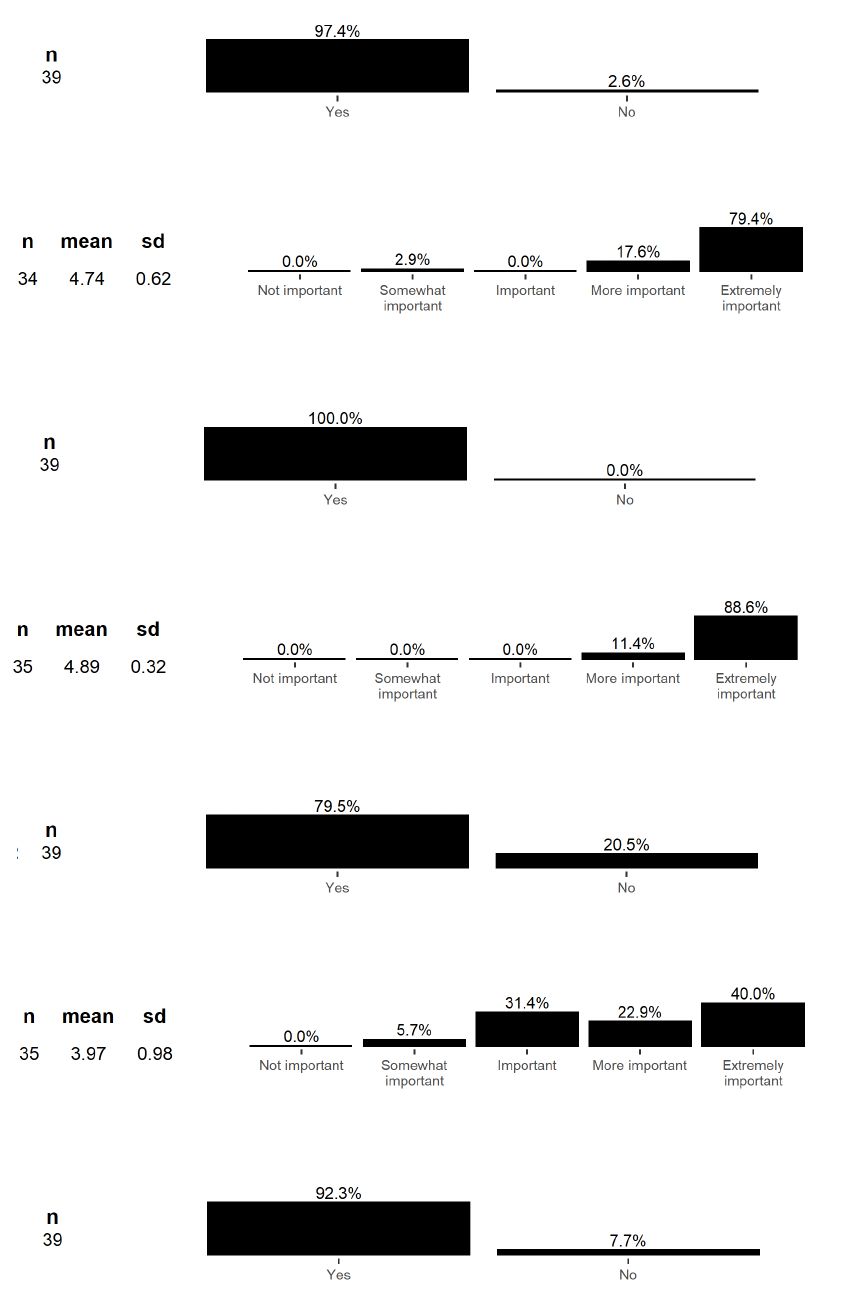
A-18
D21b. How important is takeoff and landing for your trainees?
D22a. Do your trainees receive training in situational awareness?
D22b. How important is situational awareness for your trainees?
D23a. Do your trainees receive training in time management?
D23b. How important is time management for your trainees?
D24a. Do your trainees receive training in instrument monitoring?
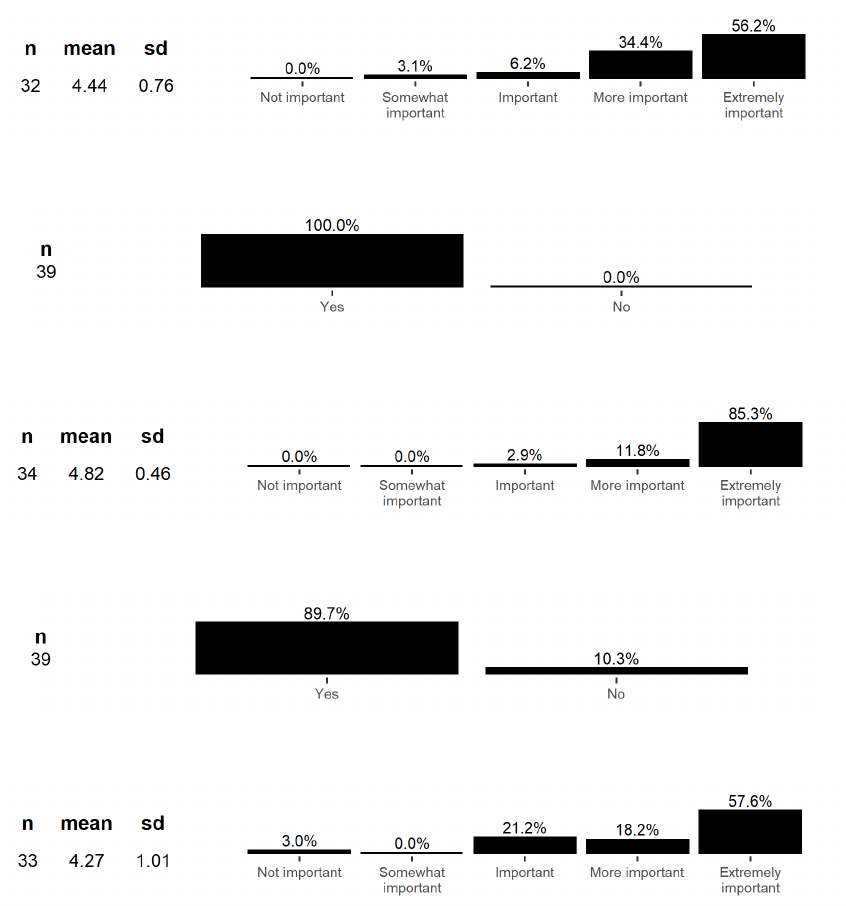
A-19
D24b. How important is instrument monitoring for your trainees?
D25a. Do your trainees receive training in risk assessment?
D25b. How important is risk assessment for your trainees?
D26a. Do your trainees receive training in navigation?
D26b. How important is navigation for your trainees?
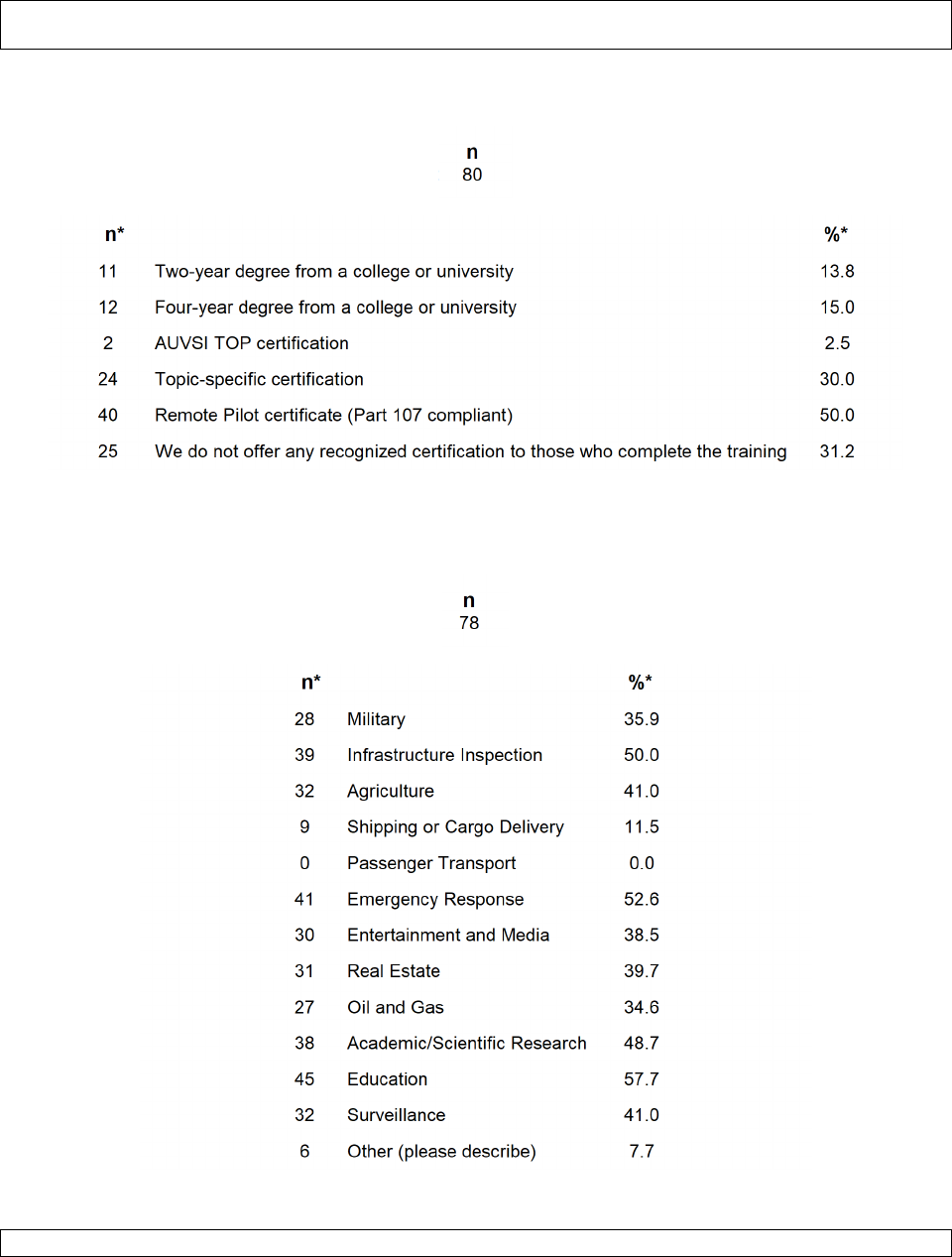
A-20
Results for Item D27 through Item D33 include only respondents who indicated ‘Instructor (teaches about drones,
regulations, best practices, etc.’ on Item A1 or ‘School or training program (teaches students about drones)’ on Item A3.
D27. What certifications or degrees do you offer to those who complete your training? [mark all
that apply]
n* may sum to greater than the number of respondents to the item (n) due to multiple responses. The %* of respondents is based on the number of
respondents to the item (n).
D28. What type of operations do you provide training for? [mark all that apply]
n* may sum to greater than the number of respondents to the item (n) due to multiple responses. The %* of respondents is based on the number of
respondents to the item (n).
Results for Item D28a include only respondents who indicated ‘Other’ on Item D28 and provided a written response.
D28a. Other, please describe: (See Appendix B. Section C. Training for a list of responses)
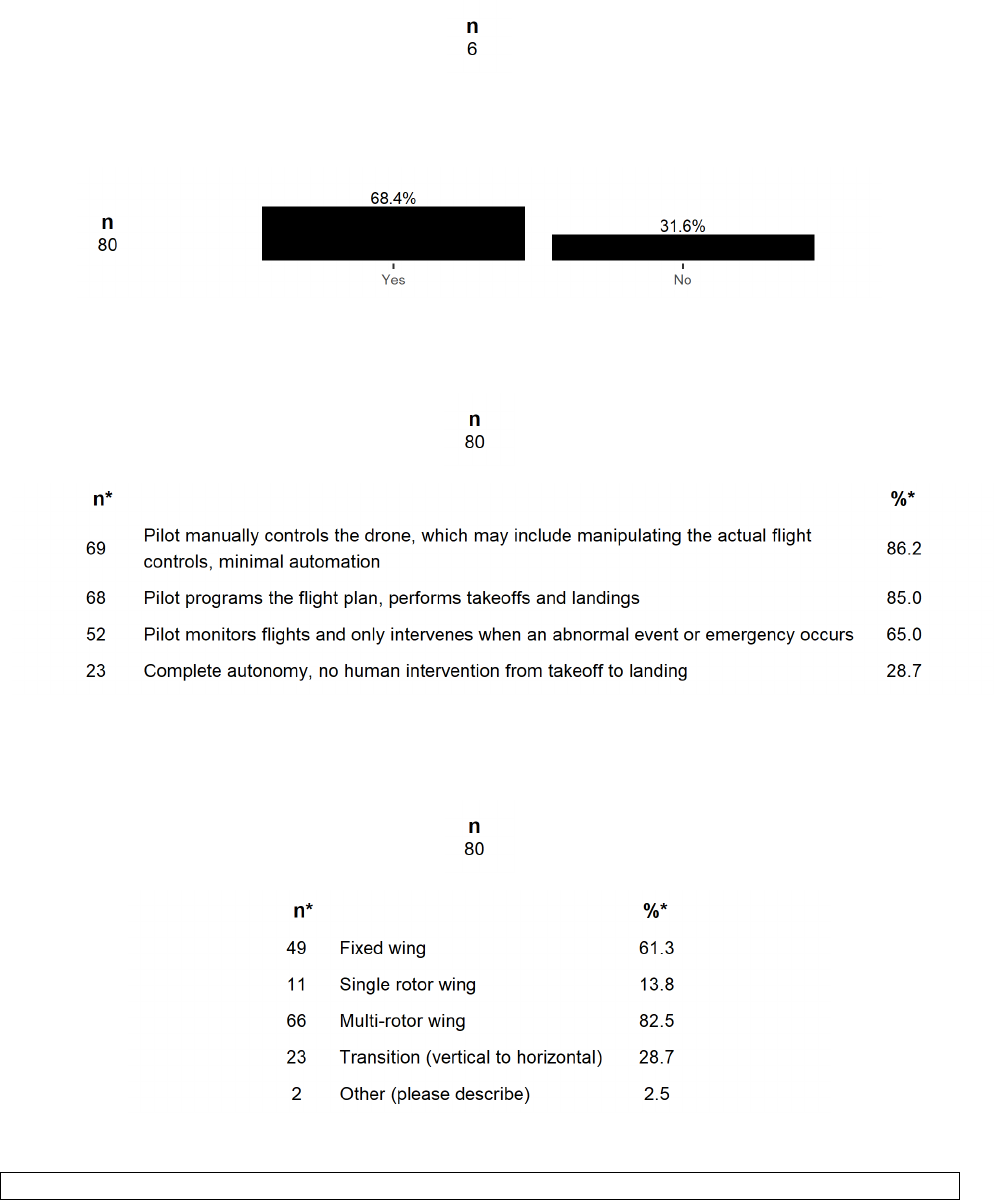
A-21
D29. Do you provide training for night operations (i.e., flights that begin or end after civil
twilight)?
D30. What type of automation techniques are taught during the training program? [mark all that
apply]
n* may sum to greater than the number of respondents to the item (n) due to multiple responses. The %* of respondents is based on the number of
respondents to the item (n).
D31. What types of drones do you provide training on? [mark all that apply]
n* may sum to greater than the number of respondents to the item (n) due to multiple responses. The %* of respondents is based on the number of
respondents to the item (n).
Results for Item D31a include only respondents who indicated ‘Other’ on Item D31 and provided a written response.
D31a. Other drone type (please describe): (See Appendix B. Section C. Training for a list of responses)
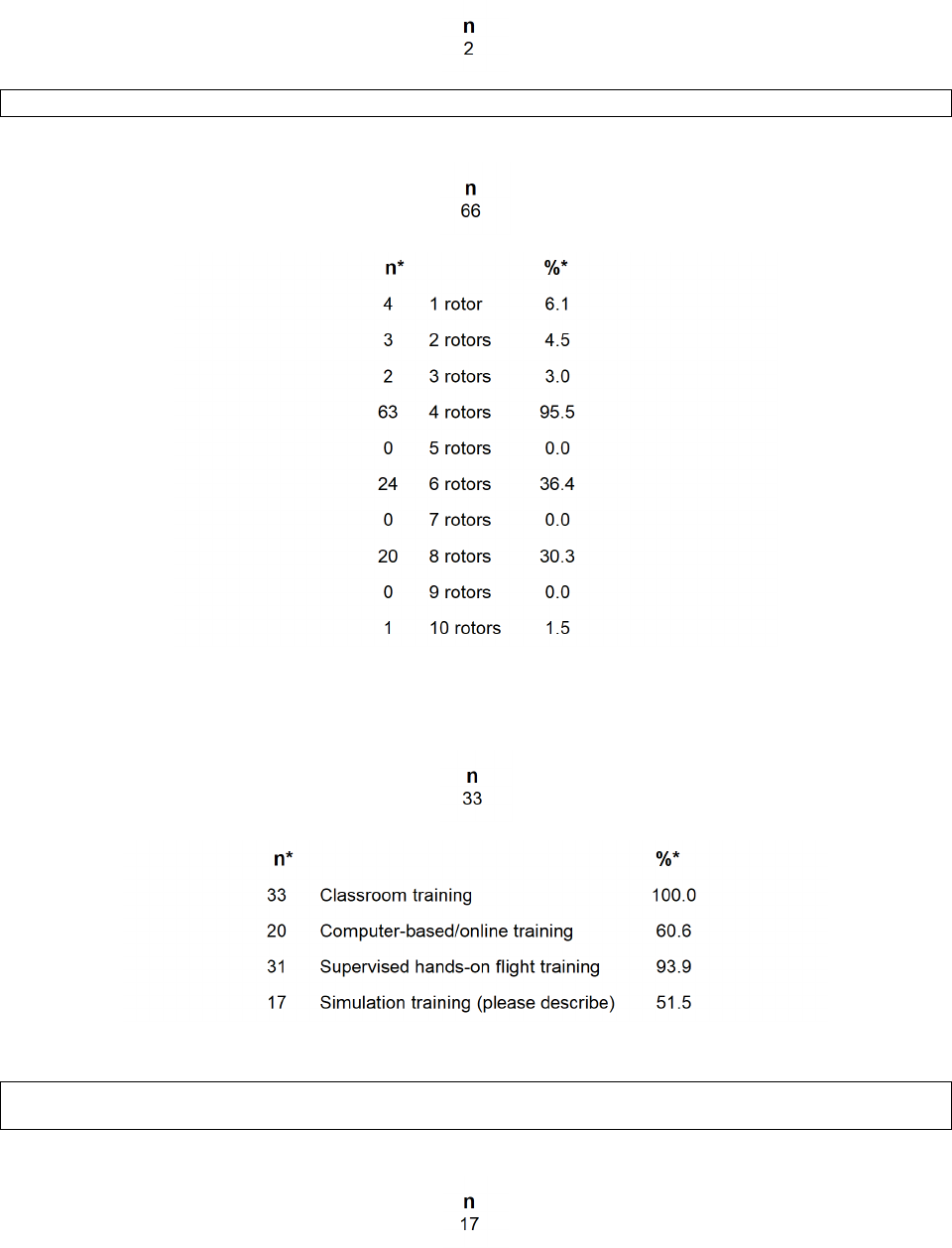
A-22
Results for Item D31b include only respondents who indicated ‘multi-rotor wing’ on Item D31.
D31b. Please enter the number of rotors for each multi-rotor wing drone you provide training on.
n* may sum to greater than the number of respondents to the item (n) due to multiple responses. The %* of respondents is based on the number of
respondents to the item (n).
D32. What types of training do you offer? [mark all that apply]
n* may sum to greater than the number of respondents to the item (n) due to multiple responses. The %* of respondents is based on the number of
respondents to the item (n).
Results for Item D32a include only respondents who indicated ‘Simulation training’ on Item D32 and provided a written
response.
D32a. Simulation training (please describe): (See Appendix B. Section C. Training for a list of responses)
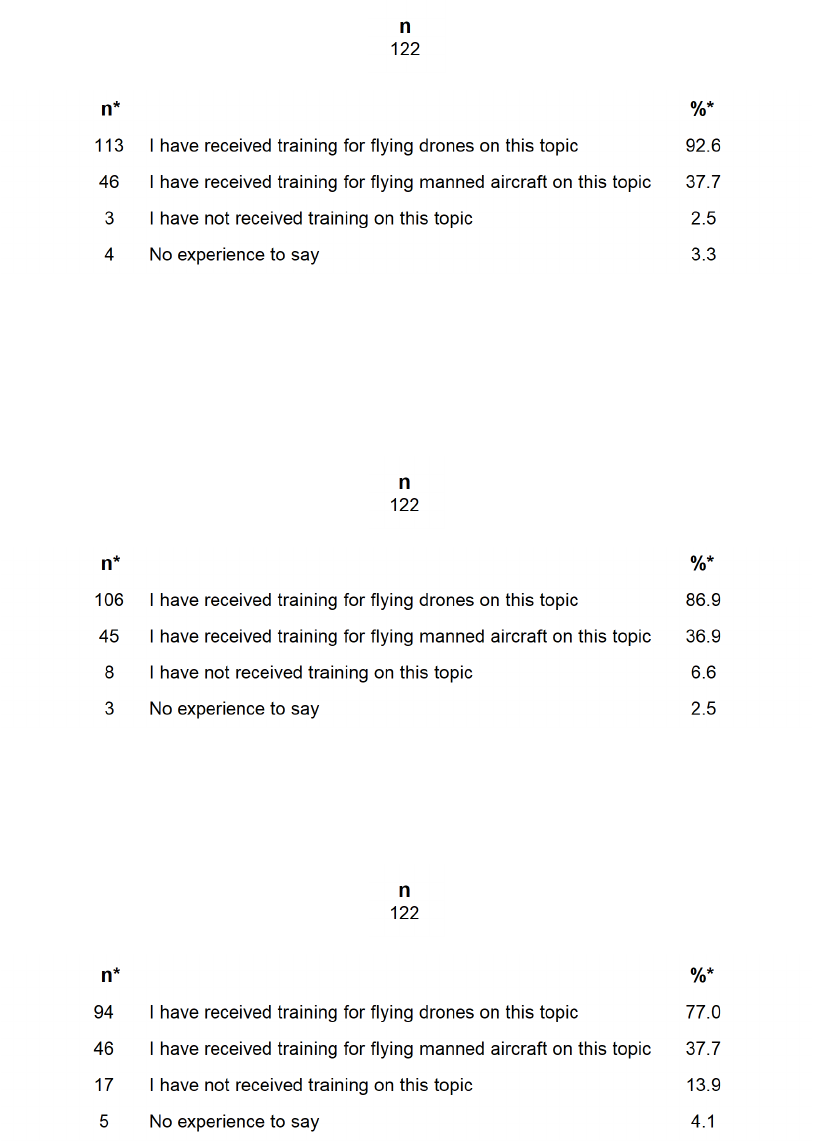
A-23
D36. What training topics have you received training on?
Applicable Federal Aviation Regulations [mark all that apply]
n* may sum to greater than the number of respondents to the item (n) due to multiple responses. The %* of respondents is based on the number of
respondents to the item (n).
D36. What training topics have you received training on?
Accident reporting requirement of the National Transportation Safety Board [mark all that
apply]
n* may sum to greater than the number of respondents to the item (n) due to multiple responses. The %* of respondents is based on the number of
respondents to the item (n).
Use of applicable portions of the Aeronautical Information Manual (AIM) and FAA Advisory
Circulars (AC) [mark all that apply]
n* may sum to greater than the number of respondents to the item (n) due to multiple responses. The %* of respondents is based on the number of
respondents to the item (n).
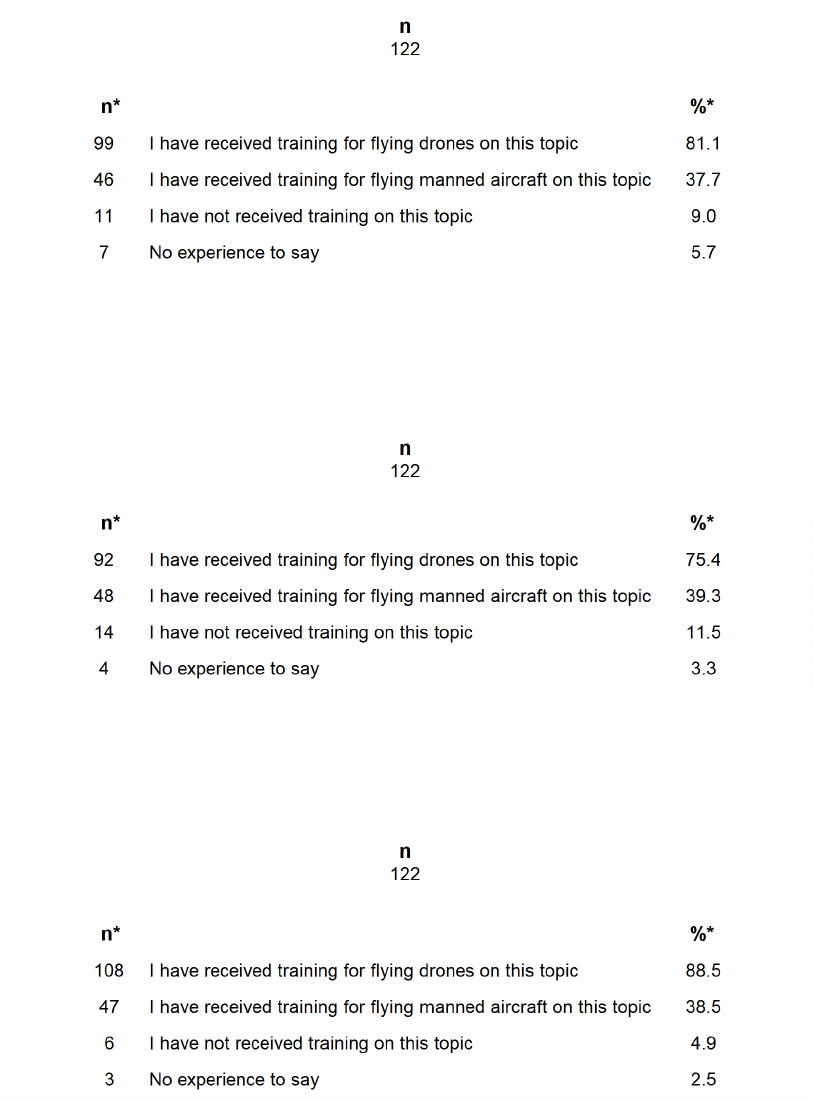
A-24
Use of aeronautical charts for navigation under Visual Flight Rules (VFR) using pilotage, dead
reckoning, and navigation systems [mark all that apply]
n* may sum to greater than the number of respondents to the item (n) due to multiple responses. The %* of respondents is based on the number of
respondents to the item (n).
D36. What training topics have you received training on?
Radio communication procedures [mark all that apply]
n* may sum to greater than the number of respondents to the item (n) due to multiple responses. The %* of respondents is based on the number of
respondents to the item (n).
Recognition of critical weather situations from the ground and in flight and the procurement and
use of aeronautical weather reports and forecasts [mark all that apply]
n* may sum to greater than the number of respondents to the item (n) due to multiple responses. The %* of respondents is based on the number of
respondents to the item (n).
Safe and efficient operation of the aircraft [mark all that apply]

A-25
n* may sum to greater than the number of respondents to the item (n) due to multiple responses. The %* of respondents is based on the number of
respondents to the item (n).
D36. What training topics have you received training on?
Effects of density altitude on aircraft takeoff and climb performance [mark all that apply]
n* may sum to greater than the number of respondents to the item (n) due to multiple responses. The %* of respondents is based on the number of
respondents to the item (n).
Weight and balance computations [mark all that apply]
n* may sum to greater than the number of respondents to the item (n) due to multiple responses. The %* of respondents is based on the number of
respondents to the item (n).
Principles of aerodynamics, aircraft engines, and systems [mark all that apply]

A-26
n* may sum to greater than the number of respondents to the item (n) due to multiple responses. The %* of respondents is based on the number of
respondents to the item (n).
D36. What training topics have you received training on?
Stall awareness and recovery techniques [mark all that apply]
n* may sum to greater than the number of respondents to the item (n) due to multiple responses. The %* of respondents is based on the number of
respondents to the item (n).
Preflight preparation [mark all that apply]
n* may sum to greater than the number of respondents to the item (n) due to multiple responses. The %* of respondents is based on the number of
respondents to the item (n).
Preflight procedures [mark all that apply]
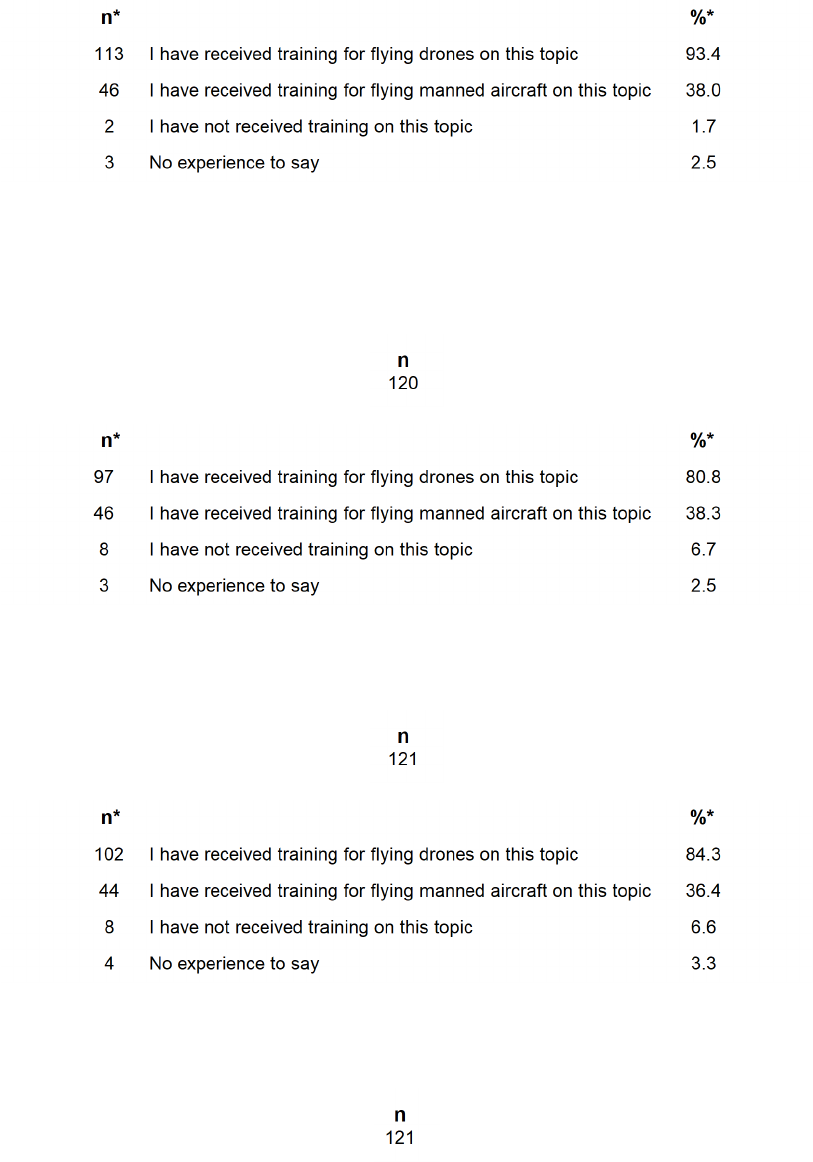
A-27
n* may sum to greater than the number of respondents to the item (n) due to multiple responses. The %* of respondents is based on the number of
respondents to the item (n).
D36. What training topics have you received training on?
Airport operations [mark all that apply]
n* may sum to greater than the number of respondents to the item (n) due to multiple responses. The %* of respondents is based on the number of
respondents to the item (n).
Takeoff, landings, and go-arounds [mark all that apply]
n* may sum to greater than the number of respondents to the item (n) due to multiple responses. The %* of respondents is based on the number of
respondents to the item (n).
Performance maneuvers [mark all that apply]
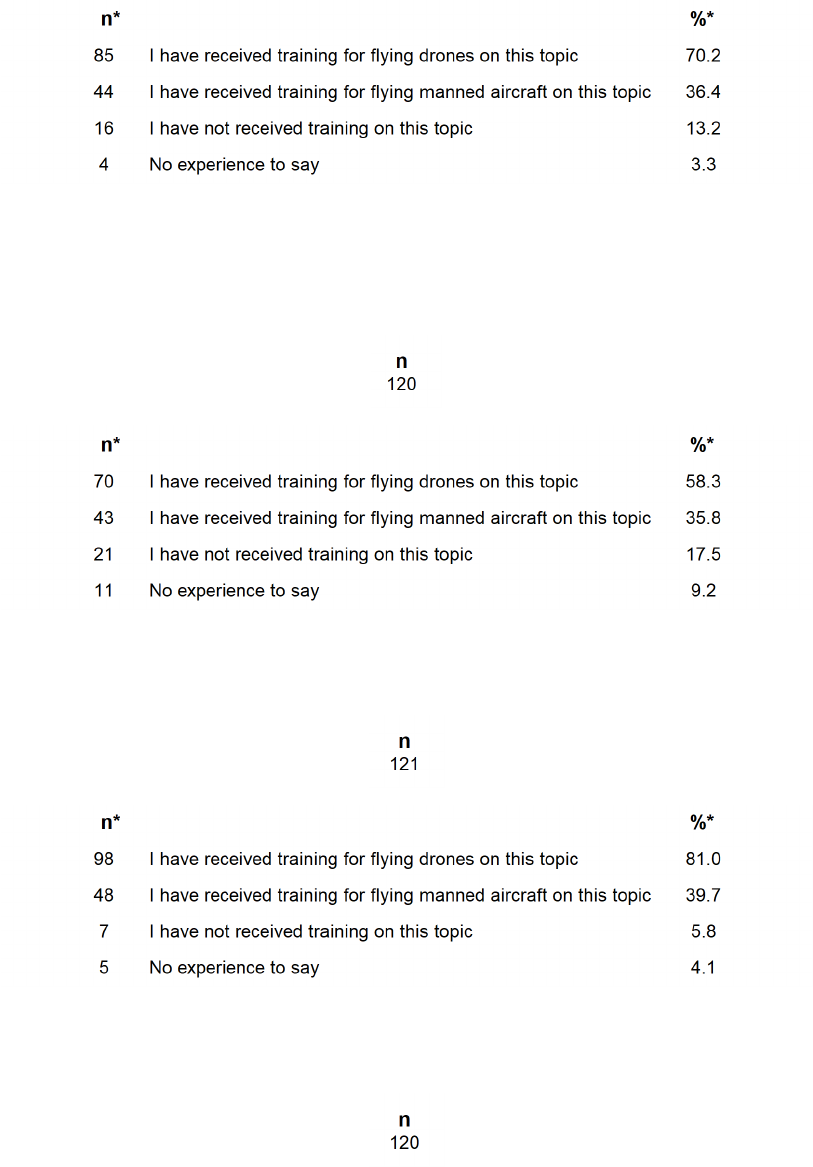
A-28
n* may sum to greater than the number of respondents to the item (n) due to multiple responses. The %* of respondents is based on the number of
respondents to the item (n).
D36. What training topics have you received training on?
Ground reference maneuvers [mark all that apply]
n* may sum to greater than the number of respondents to the item (n) due to multiple responses. The %* of respondents is based on the number of
respondents to the item (n).
Navigation [mark all that apply]
n* may sum to greater than the number of respondents to the item (n) due to multiple responses. The %* of respondents is based on the number of
respondents to the item (n).
Slow flight and (aerodynamic) stalls [mark all that apply]
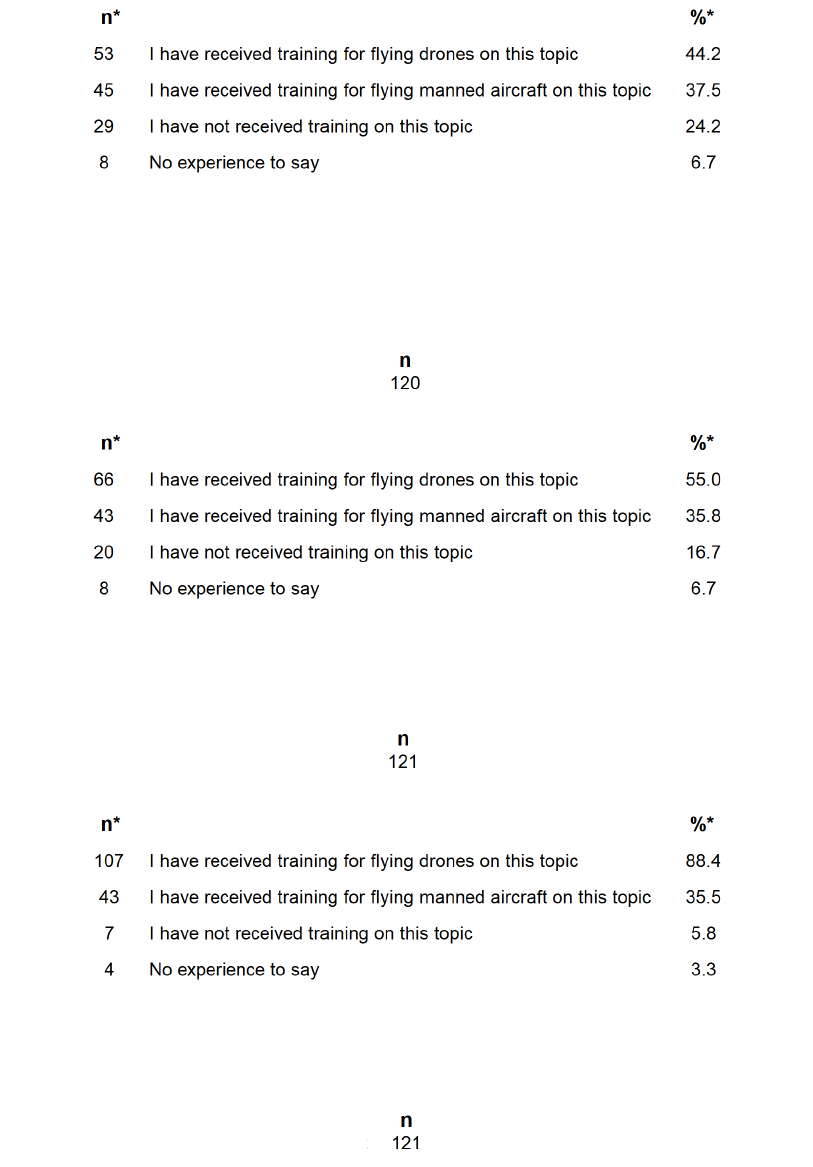
A-29
n* may sum to greater than the number of respondents to the item (n) due to multiple responses. The %* of respondents is based on the number of
respondents to the item (n).
D36. What training topics have you received training on?
Basic instrument maneuvers [mark all that apply]
n* may sum to greater than the number of respondents to the item (n) due to multiple responses. The %* of respondents is based on the number of
respondents to the item (n).
Emergency operations [mark all that apply]
n* may sum to greater than the number of respondents to the item (n) due to multiple responses. The %* of respondents is based on the number of
respondents to the item (n).
Night operations [mark all that apply]
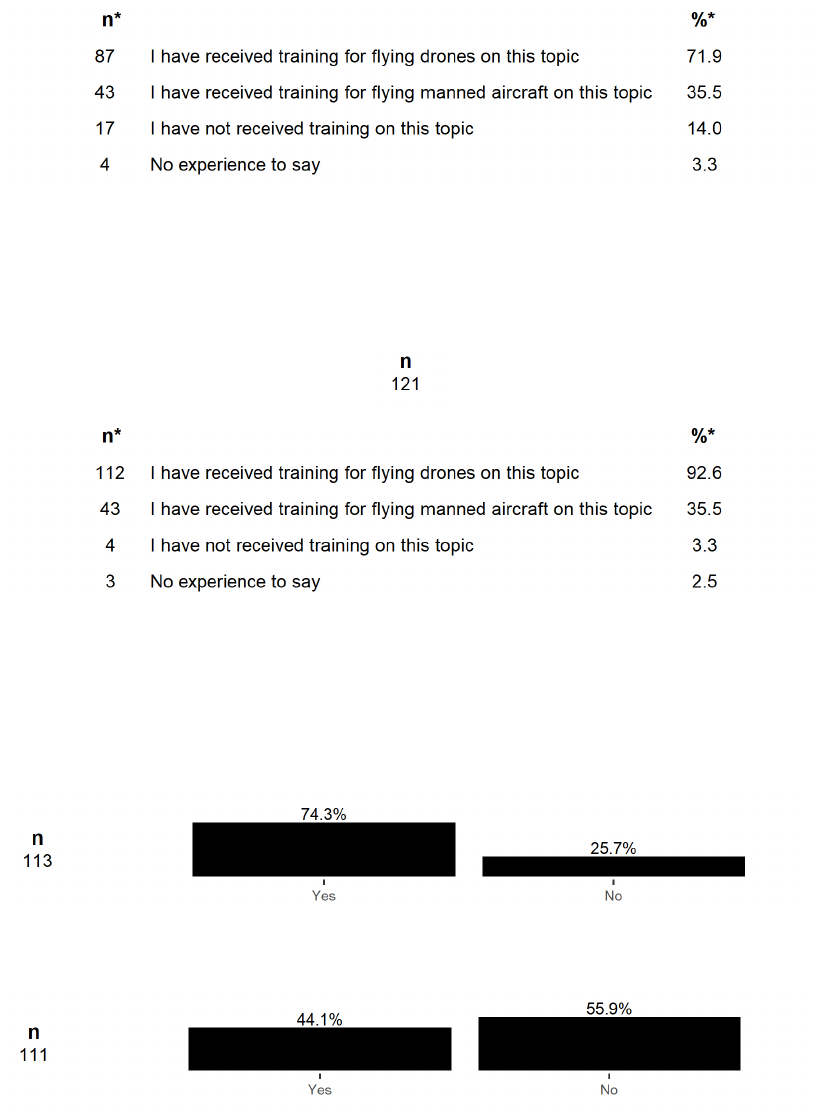
A-30
n* may sum to greater than the number of respondents to the item (n) due to multiple responses. The %* of respondents is based on the number of
respondents to the item (n).
D36. What training topics have you received training on?
Post-flight procedures [mark all that apply]
n* may sum to greater than the number of respondents to the item (n) due to multiple responses. The %* of respondents is based on the number of
respondents to the item (n).
D37. What type of drone/UAS training have you completed, outside of your organization’s
requirements?
Computer-based/online training course
Classroom operations training
Classroom drone training

A-31
Simulation drone training
D37. What type of drone/UAS training have you completed, outside of your organization’s
requirements?
Field training using the drone (i.e., in-person flight training)
Supervised on-the-job training (i.e., supervised operating experience)
D37a. Are there other types of drone/UAS training not listed in the previous question that you
have completed outside of your organization’s requirements?
Results for Item D37b include only respondents who indicated ‘Yes’ on Item D37a and provided a written response.
D37b. Other type of training provided outside of your organization, please describe: See Appendix B.
Section C. Training for a list of responses)
D38. The training you completed outside of your organization’s requirements was provided by:
Computer-based/online training course [mark all that apply]
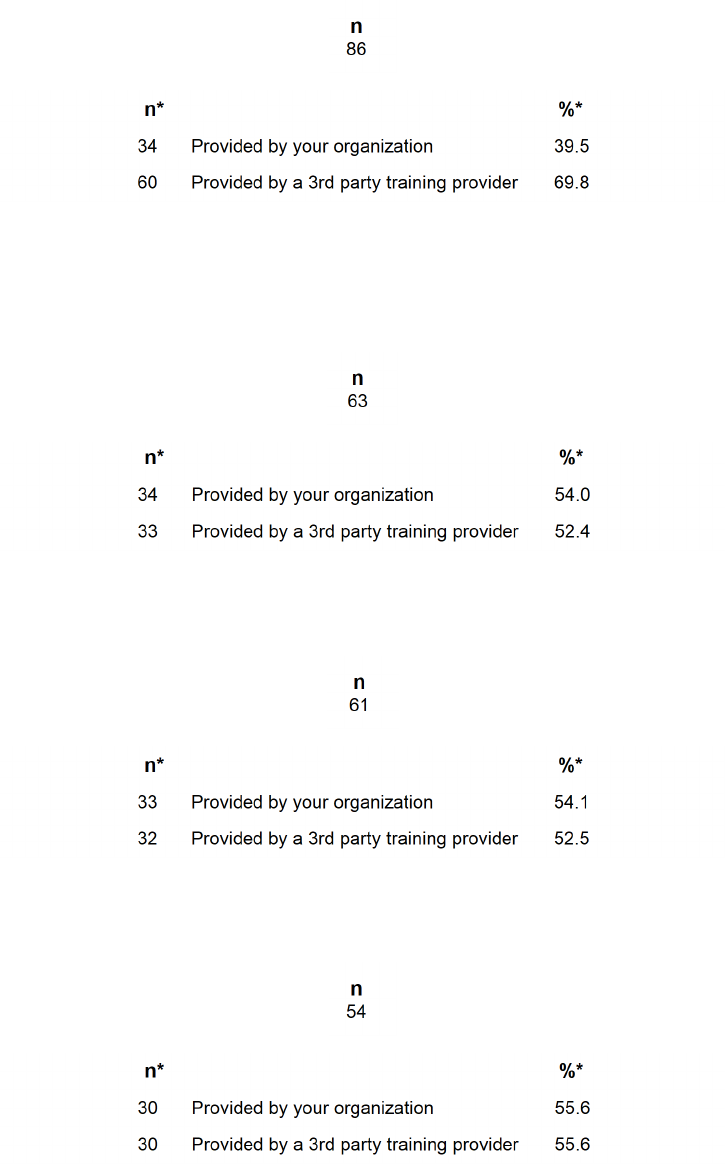
A-32
n* may sum to greater than the number of respondents to the item (n) due to multiple responses. The %* of respondents is based on the number of
respondents to the item (n).
D38. The training you completed outside of your organization’s requirements was provided by:
Classroom operations training [mark all that apply]
n* may sum to greater than the number of respondents to the item (n) due to multiple responses. The %* of respondents is based on the number of
respondents to the item (n).
Classroom drone training [mark all that apply]
n* may sum to greater than the number of respondents to the item (n) due to multiple responses. The %* of respondents is based on the number of
respondents to the item (n).
Simulation drone training [mark all that apply]
n* may sum to greater than the number of respondents to the item (n) due to multiple responses. The %* of respondents is based on the number of
respondents to the item (n).
D38. The training you completed outside of your organization’s requirements was provided by:
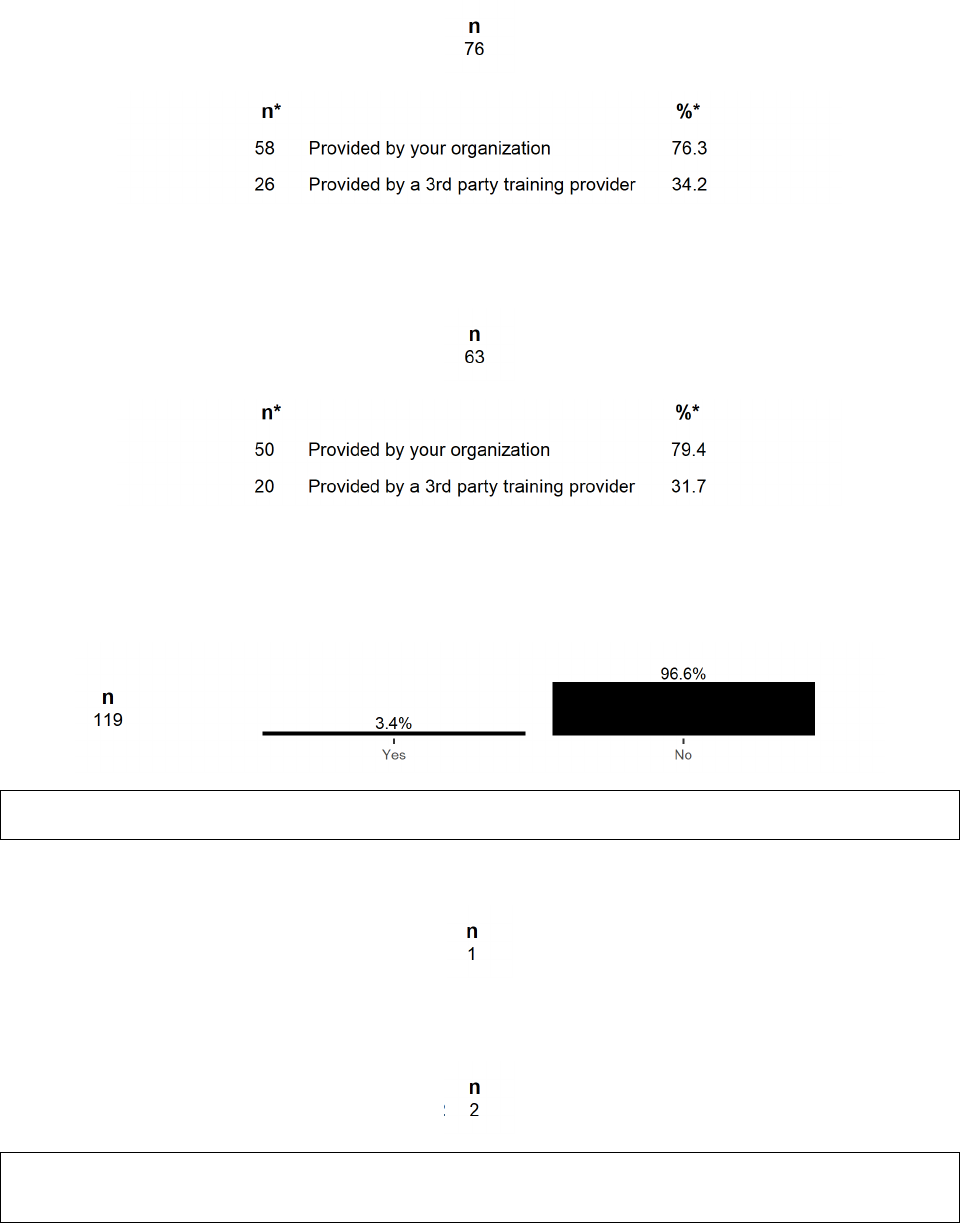
A-33
Field training using the drone (i.e., in-person flight training) [mark all that apply]
n* may sum to greater than the number of respondents to the item (n) due to multiple responses. The %* of respondents is based on the number of
respondents to the item (n).
Supervised on-the-job training (i.e., supervised operating experience) [mark all that apply]
n* may sum to greater than the number of respondents to the item (n) due to multiple responses. The %* of respondents is based on the number of
respondents to the item (n).
D38a. Are there other training requirements not listed in the previous question that are provided
by your organization or by a 3rd party training provider?
Results for Item D38b through Item D38c include only respondents who indicated ‘Yes’ on Item D38a and provided a
written response.
D38b. Other training, provided by your organization, please describe: (See Appendix B. Section C. Training for a
list of responses)
D38c. Other training, provided by a 3rd party, please describe: (See Appendix B. Section C. Training for a list of
responses)
Results for Item D39 include respondents who indicated ‘Pilot/Operator with systems less than 55 pounds,’ ‘Pilot/Operator
of systems equal to/greater than 55 pounds,’ ‘Cargo Operator,’ ‘Sensor Operator,’ ‘Manager or Supervisor,’ or ‘Other’ on
Item A1.
D39. What type of training does your organization require [mark all that apply]?
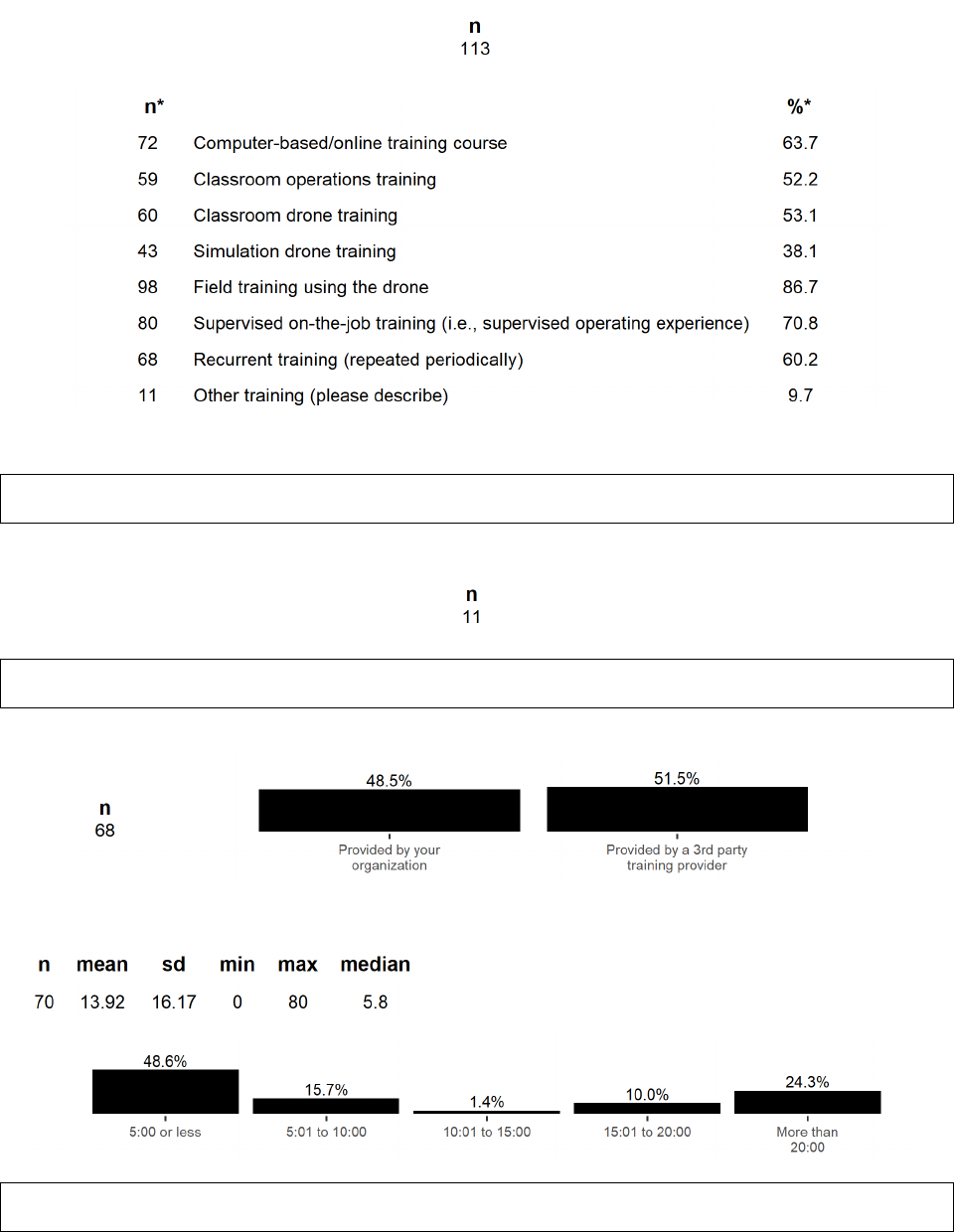
A-34
n* may sum to greater than the number of respondents to the item (n) due to multiple responses. The %* of respondents is based on the number of
respondents to the item (n).
Results for Item D39a include only respondents who indicated ‘Other training’ on Item D39 and provided a written
response.
D39a. Other required training, please describe: (See Appendix B. Section C. Training for a list of responses)
Results for Item D40 through Item D41 include only respondents who indicated ‘Computer-based/online training course’
on Item D39.
D40. Your organization requires computer-based/online training course. Is this training:
D41. How long is the computer-based/online training course?
Results for Item D42 through Item D43 include only respondents who indicated ‘Classroom operations training’ on Item
D17.
D42. Your organization requires classroom operations training. Is this training:

A-35
D43. How long is the classroom operations training?
Results for Item D44 through Item D45 include only respondents who indicated ‘Classroom drone training’ on Item D39.
D44. Your organization requires classroom drone training. Is this training:
D45. How long is the classroom drone training?
Results for Item D46 through Item D47 include only respondents who indicated ‘Simulation drone training’ on Item D39.
D46. Your organization requires simulation drone training. Is this training:
D47. How long is the simulation drone training?
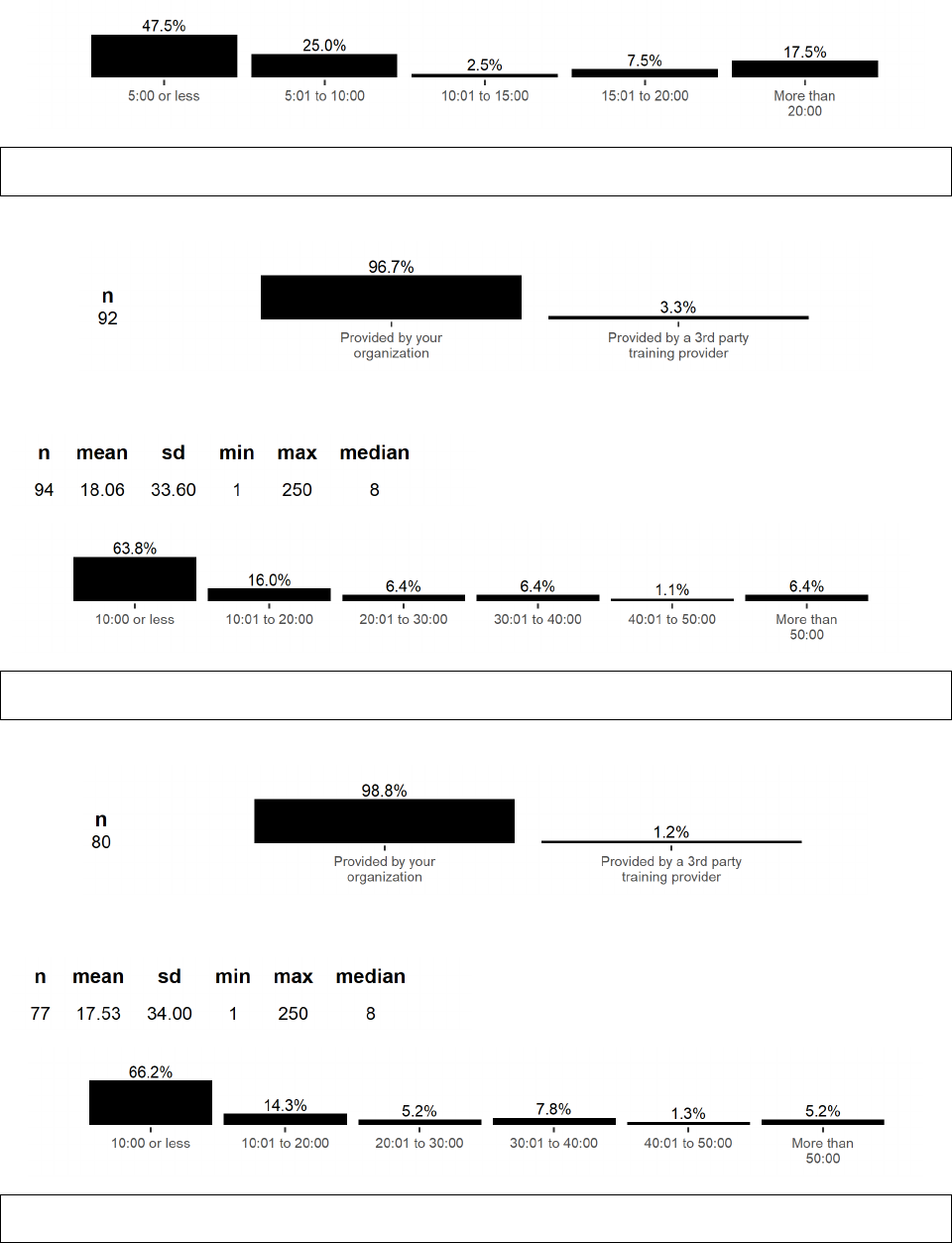
A-36
Results for Item D48 through Item D49 include only respondents who indicated ‘Field training using the drone’ on Item
D39.
D48. Your organization requires field training using the drone. Is this training:
D49. How long is the field training using the drone?
Results for Item D50 through Item D51 include only respondents who indicated ‘Supervised on-the-job training (i.e.,
supervised operating experience)’ on Item D39.
D50. Your organization requires supervised on-the-job training. Is this training:
D51. How long is the supervised on-the-job training?
Results for Item D52 through Item D53 include only respondents who indicated ‘Recurrent training (repeated
periodically)’ on Item D39.
D52. Your organization requires recurrent training. Is this training:
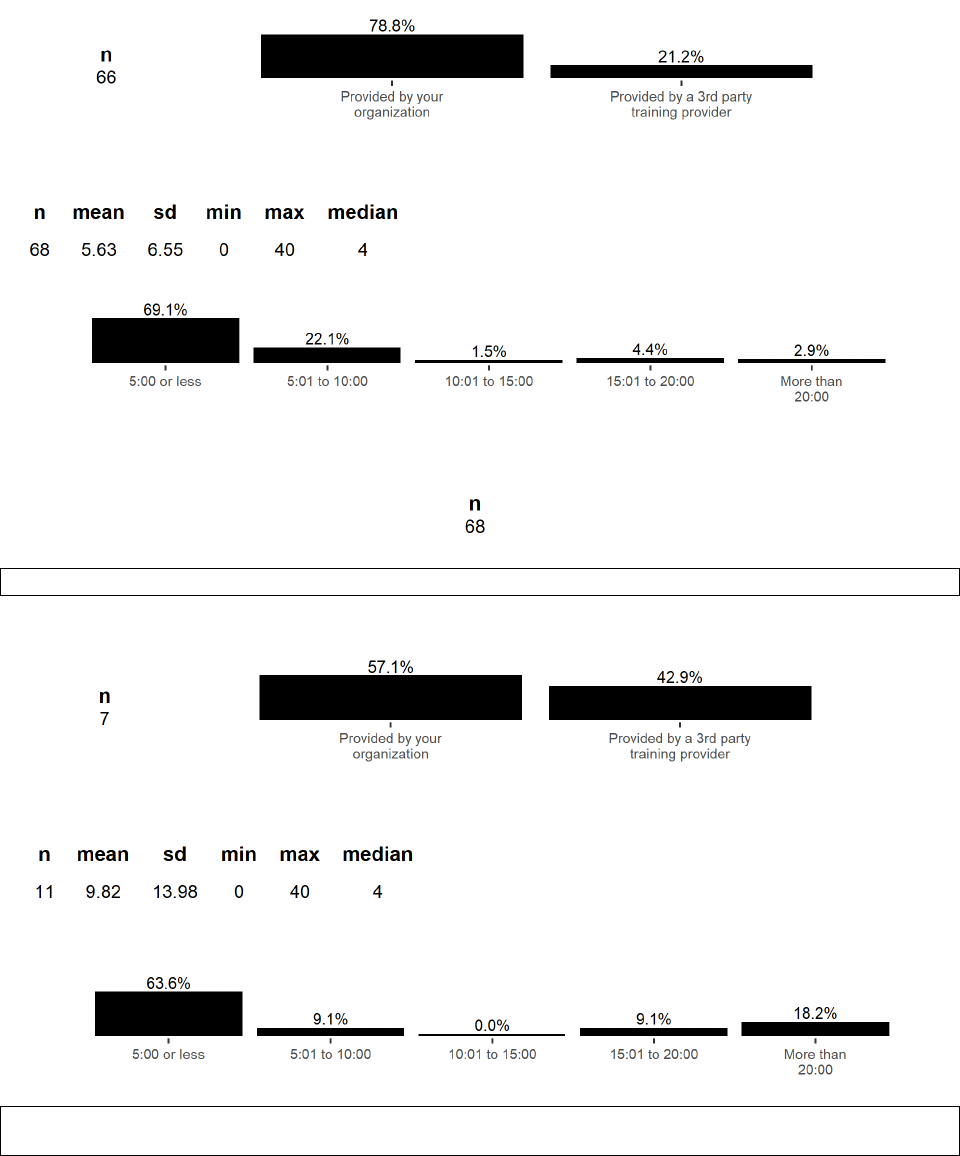
A-37
D53. How long is the recurrent training? (See Appendix B. Section C. Training for a list of responses)
D54. How often is recurrent training required?
Results for Item D55 through Item D56 include only respondents who indicated ‘Other’ Item D39.
D55. Your organization requires Other required training. Is this training:
D56. How long is the Other required training?
D56
Results for Item D57 include respondents who indicated ‘Manager or Supervisor’ on Item A1 and provided a written
response.
D57. If your organization requires training when integrating a new drone, how long is the new
training? (See Appendix B. Section C. Training for a list of responses)

A-38

B-1
Appendix B. Text Response to Open Ended Questions for Air Carrier Operational
Considerations for UAS: Training
The FAA constructed a survey to gather information about the current state of UAS
operations considered relevant to air carrier flight activities. The survey examined four areas
related to UAS operations: operator knowledge, skills, and tests; duty and rest; training
requirements; and crew and staffing requirements.
The items addressing training requirements included 24 open response items formatted
for text entry. These items typically asked respondents to explain the job roles and training
requirements for UAS operators within their organization. Of those 24 open response items, one
(1) had no response, and is not presented in this report: D37.
This appendix provides responses for the remaining 23 UAS training open response items.
These are verbatim responses with the exception of removing any personally identifying
information and expletives, as needed.
A. Demographics
Item A1a, Item A1 asked for the primary job role of the respondent. Respondents who
indicated ‘Other’ were asked to describe the job role (A1a) as well as the main
responsibility of the job (A1b), Table B1 and Table B2 respectively.
Table B1; Item A1, Table B2; Item A1b,
Table B3; Item A3a, Table B4; Item A5a,
Table B5; Item A7a,
Table B6; Item A8a, Table B7; Item A9a
B. Qualification Requirements
Item C6, Table B6; provides responses from UAS instructors who indicated their job role as
an Instructor and provided a written response for other requirements to be an Instructor at
their organization. The type of requirements for instructors to fly a UAS at their
organizations are presented in Table B9 and requirements for UAS Pilot/Operators are in
Table B10.
C. Training
Item D2a, Table B11 presents responses from instructor for what government agency reviews
their training material, other than the FAA. Item D3a, Table B12 provides a list of non-
government agencies who review UAS training material. Organization level certifications
and authorizations are shown in Table B13 (item D7a). Respondents who answered ‘other’
on Item D28 (What type of operations do you provide training for) are given in Table B14
(Item D28a). Six respondents indicated their organization provides training on other system
than those presented in the survey list (item D31), their written responses are shown in Table
B15 (item D31a). The type of simulation training provided by the organizations are given in
Table B16. Additional training provide from outside training provides and within the

B-2
organization are provided in Table B17 and Table B18, respectively. Third-party training
organization are listed in Table B19. Required training and required reoccurring training
types are in Table B20 and Table B21.
For all tables, each new comment is denoted by an asterisk (*) in the far left column.
Section A. Demographics
Item A1 asked for the primary job role of the respondent. Respondents who indicated ‘Other’
were asked to describe the job role (A1a) as well as the main responsibilities of the job (A1b),
Table B1 and Table B2, respectively.
Table B1
Responses Provided by Respondents Who Indicated ‘Other’ on Item A1 and Who Provided a
Description of Their Job Role (n = 13)
A1. Currently, what is your primary job role? (required) Other (please describe)
a. In brief, please describe your job role:
* Business Owner
* CEO
* Director, UAS Flight Operations
* I am a Detective with the Sheriff’s Office and also the lead UAS pilot/program coordinator
*
I am the VP of our company, and manage, operate and maintain UAS above and below 55
lbs
* Marketing Manager
* Operations and also Pilot
* owner/exec
* Part 141 assistant chief flight instructor, airplane
* Pilot and Manager of pilots
* Public Safety Representative
* Research UAS applications, and in that also pilot, but also instruct
* Supervisor and Pilot/Operator of systems equal to/less than 55 pounds.

B-3
Table B2
Descriptions of Job Responsibilities Provided by Respondents on Item A1b (n = 166)
A1b. In brief, please describe the main responsibilities of your job:
* Working with engineers and former NASA astronauts by researching, preparing and
producing media content (Videography, Photography, and/or Drone Content, etc.) for
documentation, training, promotion, sales, and other communicative purposes for both
internal and external audiences. • Monitor and track manufacturing schedule of important
programs • Remote camera operations for static tests
* As a professor of Aeronautical Science teaching our Bachelor of Science in Unmanned
Systems Applications and our Master of Science in Unmanned Systems at [University], I
teach the concepts about UAS operations and safety management. Later, in advanced
classes, I lead students through applications of UAS-related student projects.
* As CEO of our Part 107 test prep and drone flight instruction company, I manage each of
our key team members and set strategy.
* As operations manager, prepare estimates for clients to obtain traffic data for engineering
companies.
* As President I run the business and co-manage field operations which I also participate in
at times
* Associate professor providing ground and flight instruction utilizing sUAS.
* Build and fly drones for various government sponsors.
* Camera operation and weapons guidance on the MQ-9
* CEO/Owner [Company] an unmanned systems and services company
* Chief pilot and instructor, also cfi/i/mei/agi for small growing company, I bring the
mindset of GA part 61 aviation and apply to part 107
* Chief Pilot, team management as well as current/qualified RPIC
* Co-designee, develop, edit, and author Unmanned Aerial System (UAS) training programs.
Ensure federal, state, and local law regulatory compliance for all administrative and
operational documents. Ensure all Safety Management System (SMS) administrative and
operational documents meet all regulatory guidance standards. Perform academic, hands-on
system training, and various UAS simulation and flight operations instruction for civilian
(foreign/domestics), military (foreign/domestics), and other governmental agencies.

B-4
A1b. In brief, please describe the main responsibilities of your job:
* Co-Founder of [Company]. I am responsible for business development and the managing
member of the company. I join the crew on service jobs, provide instructional training and
work with the Airborne Public Safety Association on the NIST sUAS Standard Test
Methods program.
* Conduct training and evaluations for a P135 UAS operation. I also participate in flight
operations.
* Contract MQ-9 Pilot/Instructor for the U.S. Air Force, [Address]
* COO - Operations Management. Flight planning, drone operations and maintenance,
planning and development, FAA and waiver management.
* Coordinate Geospatial program at the college and other public safety programs.
* Criminal Division Commander, UAS Program Commander
* Curriculum development and instruction
* Define operational requirements form local missions. Maintain your aircraft and log
flights. Tran our group of volunteer spotters in operations and safety standards
* Department Chair over the training for our UAS dept.
* Deputy Director of Emergency Management for a County government
* Develop and disseminate testing procedures and standards for response robotics.
* Develop core competencies for UAS operators and sensor operators; help select equipment
to meet mission requirements; train operators; obtain all necessary approvals; oversee
safety; responsible for safe and effective execution of the mission.
* Develop, maintain and teach and 1 year UAS certificate program at a community college
* Direct a non-profit that facilitates the use of unmanned technologies for environmental
research and monitoring.
* Director of Operations
* Director of UAS Operations and Safety - Review operational safety plans, set policies and
procedures for drone use, provide flight instruction and analyze safety metrics.
* Director of UAS Programs. EP for grp 1-3 UAS, Primary UAS Instructor
* Drone & field operator flying under and above the canopy as well as conducting radio
tower inspections
* Drone Pilot for [University] Extension Communications Department for Photo and Video
purposes

B-5
A1b. In brief, please describe the main responsibilities of your job:
* Emergency Management
* Ensures that all flight operations are conducted safely and in compliance with all FAA
regulations, OpSpecs and company policies. Coordinates with the POI on regulatory
requirements and OpSpecs, to ensure the highest level of safety and regulatory compliance.
* Executive Director, [Company], [Company], responsible for "all things uncrewed" for the
[Company].
* Filming and editing all videos for my organization
* Flight and regulatory instructor for a UAS training company.
* Flight instructor for public safety UAS
* flight of uav in response to wildfires
* Flight operations and mission planning
* Flight Operations Manager: I manage upwards of 15 pilots currency and medical
requirements, as well as a fleet of SUAS.
* Flying for the film industry
* Founder and President of [Company], a drone service company that specializes in provide
aerial film to sports teams.
* Geospatial Program Manager and sUAS Pilot and Data Specialist for Emergency
Responses.
* GIS Administrator for company. Gathering, managing data and imagery.
* Help teach the teacher and kids in school about drones and the rules to govern them
* I am a Director of the [University] Drone Center. A research based educational center that
build, maintains, operates, educates, integrates, and provides training with UAS systems.
* I am a drone operator and program administrator for the UAS program of the [Company].
* I am a professor and department chair in the Department of Wildlife at [University] (aka
[University]), as well as a Principal Investigator for projects run through [University]
Sponsored Programs Foundation. For two of my projects, I serve as the primary UAS pilot
for externally-funded research - it is this role that I am writing about in the survey.
* I am a professor at a university. My primary responsibilities include developing course
content, instructing in a lecture setting, instructing in a project setting, supervising a UAS
instructor team, grading, advising, and mentorship.

B-6
A1b. In brief, please describe the main responsibilities of your job:
* I am a scientist that uses drones for animal surveys, we have agency oversight that liaises
with the FAA and has established further protocols in addition to part 107
* I am a software engineer. I develop web based applications and streaming systems to
deliver content to paid students.
* I am a Video Producer/Director at a local PBS affiliate TV station tasked with producing
commercial/educational content for public broadcast.
* I am primarily a civil engineer (previously engineer in training). I maintain a Remote Pilot
Certification for the purpose of operating a small UAS for land surveying purposes. I
develop plans for surveys including verifying airspace, altitudes, and planning ground
control point locations. I often act as the person manipulating the controls for the small
UAS as well.
* I am responsible for building our drone fleet for last mile delivery and other applications
* I am responsible for the operation of the UAS. I collect assets typically video footage used
for marketing purposes. I then edit the footage into marketable deliverables and deliver
them to the client. I also serve as my companys software engineer providing web
development support as needed.
* I am the aviation coordinator and UAS pilot for a large agency.
* I am the Deputy Chief of Special Operations, Research and Training. I supervise our UAS
Unit.
* I am the Director of [Company] UAS Flight Operations. I am a SME for UAS Operations
worldwide both Civil and Military. I design UAS flight operations Airspace, and the
Documented Programs of record.
* I am the drone RPIC that operates and performs various drone jobs.
* I am the founder/CEO of [Company]. We are a Drone Technology company. I am an FAA
Part 107 Pilot having flown 4,000 UAS missions
* I am the Leadin Instructor for the [Company] Fire Academy UAS program
* I am the Lieutenant and Program Manager of our Aviation Unit.
* I am the owner of a Drone Service Provider company, [Company name].
* I am the program coordinator, curriculum designer, and lead instructor at a university UAS
degree program.
* I am the UAS Program Manager and lead FAA Part 107 Pilot in our organization.

B-7
A1b. In brief, please describe the main responsibilities of your job:
* I am the UAS Program Manager for a collegiate UAS program. I develop and oversee the
training for students and professionals
* I am [Company] COO - responsible for national operations and flight management for our
UAS systems.
* I build, own, and operate 12 electric and gas powered RC aircraft and helicopters, some
with FPV or HD recording cameras. I operate these under the FAA rules, and with AMA
insurance as provided by my RC flying organization, of which I am the Vice President.
* I co-coordinate the drone certificate and degree program at [Name] College. I teach
students how to operate drones and process drone data for mapping and surveying
applications.
* I handle sensor integration as well as airframe design. Over the development of the
platform I train and educate or internal personnel.
* I lead the unmanned systems division within a large industrial services company. I oversee
operations, sales, and the backend business in general.
* I manage DOD programs and several are either UAS or C-UAS customers.
* i manage FPL's drone organization that is responsible for the safety, training and
integration of UAS into the company and also all FAA waivers and authorizations as well.
* I manage our UAS program. I am responsible for developing new uses for drones in our
organization and am generally responsible for managing our fleet.
* I oversee advanced technology Initiatives within the [Company], including oversight and
management of the [Company] and oversight of the [Company] participation in the FAA
BEYOND program (the [Company] is the only tribal lead participant in the BEYOND
program).
* I provide private training for customers of small, medium, and large businesses to adopt
drones, learn the Part 107 test, and develop workflows for UAS mapping, GIS analysis,
data collection, and inspection.
* I run the drone studies program at [Name] Junior College, including course development
and delivery.
* I teach young research students how to become FAA Part 107 certified and how to operate
UAVs.
* I train unmanned aircraft system pilots in Part 107 rules and regulations in order to get
them ready for the written qualification test.
* I work as a City emergency manager as well as a communications specialist.

B-8
A1b. In brief, please describe the main responsibilities of your job:
* I’m the Vice President of our company. I operate drones, operate payloads, maintain, and
manage drones for inspection purposes. Above and below 55 lbs. I used to fly for
government contracts overseas in the SUAS, and MEUAS fields
* I'm a Land Surveyor and on some jobs we use a drone to capture imagery above the site.
Sometimes we build an orthomosaic from the drone photos and sometimes we build a 3D
model with the drone photos using Structure from Motion software to get X, Y and Z data
of features on the site.
* IN FIELD PIOT RESPOSIBLE FOR MULTISPECTRAL INSPECTION OF
AGGRIGULTURE
* Instruct
* Instruct military/civilian personnel on the use of UAVs
* Instructing UAS systems for military
* Instructor & Evaluator. When new pilots join the team, I will assist in ground training,
application training, drills, and on-the-job training. Once they have met the minimum
requirements, I conduct checkrides which are oral and practical, as well as conducting
annual line and competency checks.
* Instructor MQ-9 Launch & Recovery Pilot, Instructor MQ-9 Mission Control Element
Pilot, USAF
* Instructor sensor operator operating and teaching camera manipulation, synthetic aperture
radar use, and other equipment usage
* Investigate felony level crimes UAS Program coordinator/lead UAS pilot
* IT director for a construction company
* Launch and recovery instructor for sensor operators. In an FTU school house
* Lead a 4 man operations of a Group 3 UAS
* Lead electrical and firmware engineer for avionics, chief UAS pilot, CEO.
* Maintain automation for building and lighting energy consumption. Maintain HVAC
equipment controls and I use the drone to do visual assessments on buildings faster and
more economical for building sustainability
* Maintain Clients Fly and Maintain Aircraft Compliance
* manage a team of pilots worldwide with the largest number in the USA.

B-9
A1b. In brief, please describe the main responsibilities of your job:
* Manage global Company Unmanned Aerial System program consisting of over 100 drones
of various types and more than 100 drone operators operating in four countries focused on
supporting mining activities.
* Manage group of pilots charged with selling, supporting sUAS.
* Manage team of UAS pilots performing public safety and commercial UAS flights.
* Manage the curriculum and resources for [Name] University's UAS, aviation maintenance,
and aviation administration programs.
* Managing Member/Chief Pilot of an Agricultural Aerial application Company
* My company works with private corporations and government entities looking to establish
drone programs. We write the SOP's, safety procedures, train the trainer programs, risk
mitigation strategies, assist in identifying platforms that satisfy their use-cases and finally
manage/oversee the programs (fleet, pilots, software, etc.).
* Oil and Gas Training, including drone training.
* Operate a commercial delivery drone
* Operate an MQ-9 Reaper as pilot-in-command; conduct intelligence collection (ISR) and
precision strike as required in pursuit of US interests and Joint Forces Air Component
Commander objectives
* Operate drones
* Operate the gimbal and sensor on the aircraft. Assist pilot with checklists and scanning
GCS instruments and warnings. Assist pilot in scanning for traffic during critical phases of
flight. Fly the aircraft and operate the sensor payload when using aircraft that do not
require a 2 person crew.
* Operate UAS drone
* Oversee the management of our UAS program
* Owner of aerial imagery company using Mavik 2 and 3 drones
* owner operator of commercial drone business oversee day to day operations and pilots I
also am licensed and can do pilot work
* owner/Executive: President, Flight Operations
* P107 certified pilot for company Service jobs. VO for company Service jobs. Sales director
for USA retail business. Sourcing and Supply chain manager. Office Administrator.
* Part 107 pilot, cinematographer and photographer.

B-10
A1b. In brief, please describe the main responsibilities of your job:
* Part 141 Assistant Chief Flight Instructor, airplane
* Pilot
* Pilot drone for forest data collection. Chief pilot responsible for compliance with national
airspace.
* Pilot drone for land survey
* Piloting RC helicopters, quadcopters, hexacopters, and fixed wing aircraft and full size
fixed wing aircraft for aerial photography, videography and 3D modeling.
* Plan and operate drone operations
* plan, coordinate and supervise the completion of drone flight operations.
* Police Supervisor over traffic Team. Team employs sUAS platforms for crash/crime scene
documentation.
* Primary Part 107 Certified pilot and trainer.
* Professor and Director of Research Laboratory (teaching, research, and service)
* Professor, Information Systems and Aviation Studies Department [Name] Community
College
* Provide leadership to a collegiate aviation program.
* Provide Search and Rescue services to [County]
* Provide UAS instruction relating to UAS Operations. Serve as the university UAS
Operations program coordinator.
* Provide uas training to disabled veterans for commercial operations and adaptive
recreational therapy utilizing drones
* Provide water rescue service to the town of [County]
* Providing contract training and consulting to major UAS company.
* Public Safety Agency UAS Representative
* Rated aviator, RQ-7 Shadow operator. Engineer for design of survivability requirements
for Army FUAS systems.
* Regulatory compliance
* Remote PIC of sUAS aircraft for residential survey work
* Remote Sensing Lead at [Company], LLC and Manager, University of [Name] Drone Lab

B-11
A1b. In brief, please describe the main responsibilities of your job:
* Research scientist/professor
* Research UAS applications, build and flight test instrumented UA, instruct students
* Responsible for developing targeted strategies to promote [Company] and all its divisions
including Charter, Production, Electronic News Gathering (ENG), Air Medical, Aircraft
Management, and Technology Solutions for Law Enforcement Agencies.
* Sales Manager/COO I take aerial photos for construction projects for both estimating and
marketing.
* Sensor Operator Evaluator and Instructor for MQ-9A. Performs, evaluates and instructs
MQ-9A launch and recovery operations worldwide. Performs, evaluates and instructs
mission support element IMINT, SIGINT and ELINT devices onboard MQ-9A.
* Standardization Instructor Operator
* SUAS instructor
* sUAS Operations and maintenance Instructor/ Large UAS maintenance instructor
* Submit Waivers and ATC Authorizations under FAR Part 107. Support staff with
reviewing airspace and interpreting FARs. Review all incident and accident reports and
council pilots as needed. Assist with staff hiring, write articles for the company email
newsletter, and provide online training to pilots.
* Supervise our UAV program and am a part 107 licensed pilot.
* [Name] training specialist
* Takeoff and landing copilot, checklist reading, data monitoring, camera manipulation.
During flight- aircraft monitoring, communications and camera manipulation.
* Teaching computer programming, manufacturing, and system integration
* Technical Director Archaeology and Drone Pilot for research
* The main responsibilities of my job are to oversee production of a local community access
station and the department that runs the drone division.
* The Owner and operator.
* To test new configurations of a VTOL aircraft, and maintain proficiency in the event a
contract requires deployment.
* To train and educate potential drone pilots in the safe operation of sUAS.
* Training public safety on drone use, regulation, and policy. Also curriculum development
* UAS Coordinator and Remote Pilot
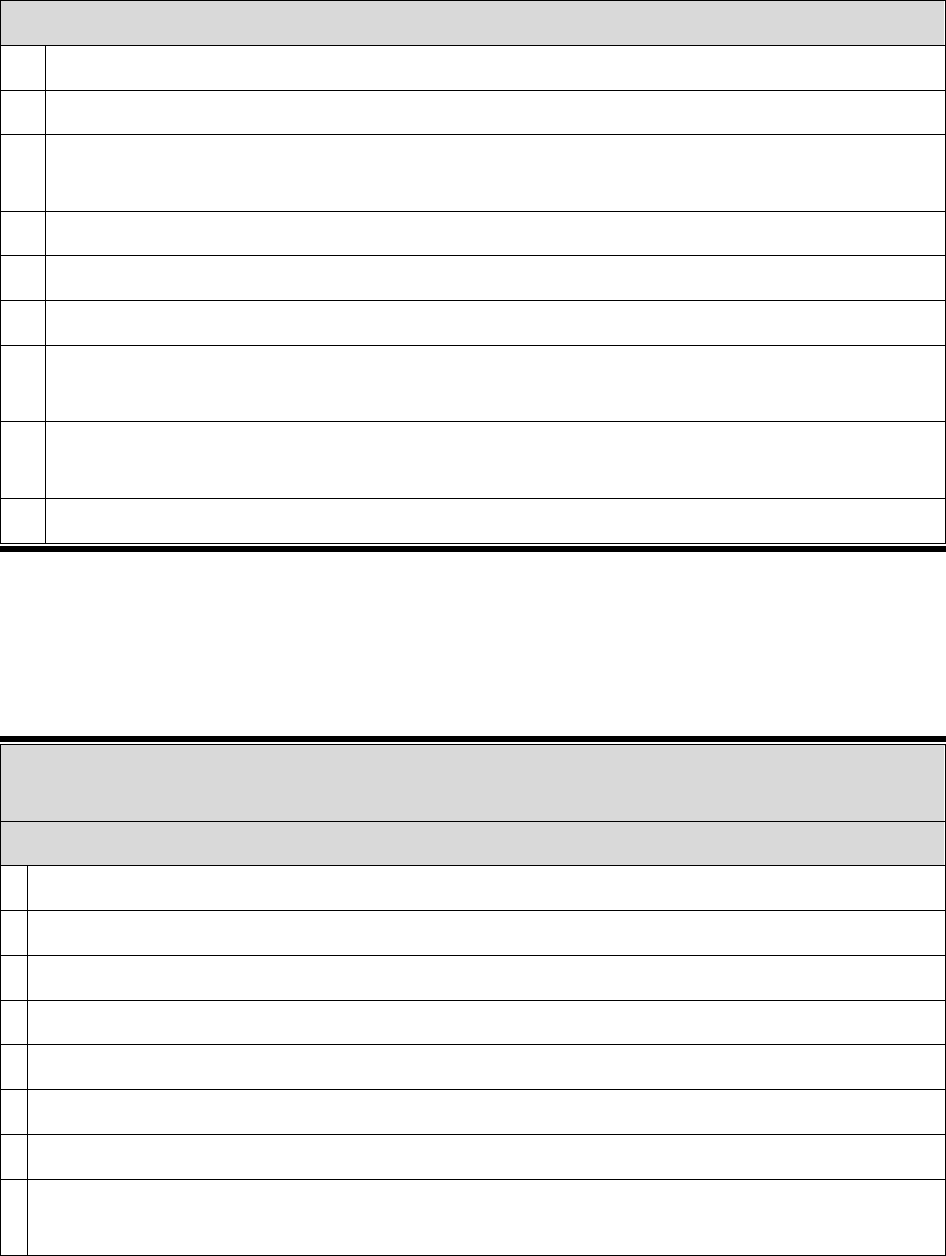
B-12
A1b. In brief, please describe the main responsibilities of your job:
* UAS Detail Coordinator for the [Company] State Police
* UAS operations over agricultural land. We are a team of 15 operators.
* UAS safety standards instructor and flight trainer for potential Part 107 pilots and Part 107
pilots.
* UAS Standardization Pilot
* UAV pilot / aerial videographer, photographer
* UAV remote pilot in command for LLC. Research assistant professor.
* We are a marketing firm that also specializes in content generation where we use drones to
aide in the visuals for people to identify with local business.
* Work with public safety agencies to start and expand UAS programs. COA writing, trainer,
pilot.
* [Company] is a drone delivery platform.
Table B3
Responses Provided by Respondents Who indicated ‘Works with drones, but none of the above’
on Item A3, and Who Provided the Capacity in Which Their Organization Worked With Drones
on Item A4 (n = 38)
A3. The organization that I work for is, or plans to be, a: [mark all that apply] (required)
Works with drones, but none of the above (please describe)
A4. In what capacity does your organization work with drones?
*
Animal and environment surveying
*
capture college event images
*
Crime scene reconstruction, search and rescue
*
Develops the standards for drones and pilots to be evaluated in the us and abroad.
*
Drone service operator, but not for monetary compensation.
*
Emergency services
*
Federal Emergency Responses
*
Full spectrum of operations including public safety, agriculture operations, GIS, research and
development, and marketing/communications.
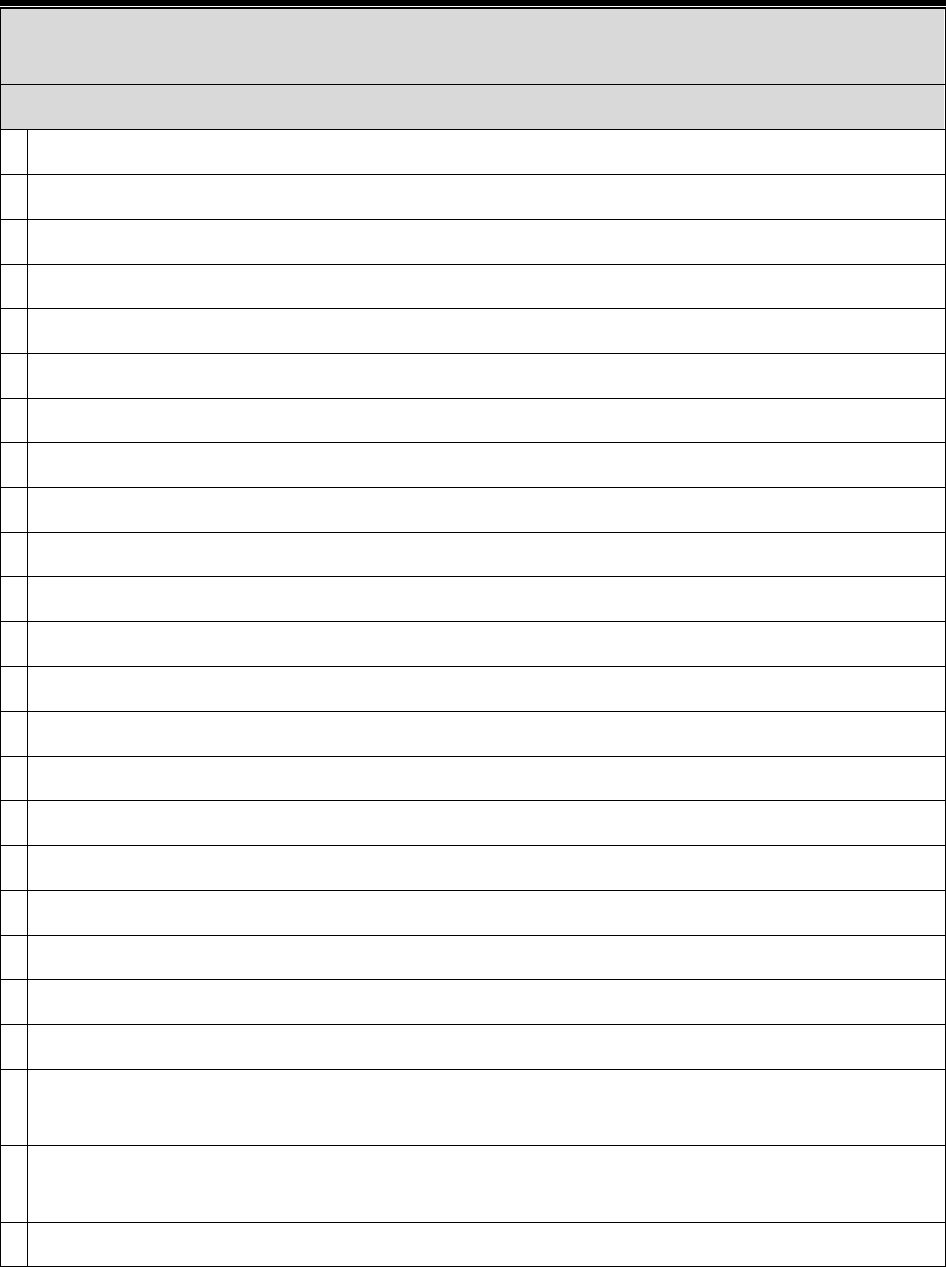
B-13
A3. The organization that I work for is, or plans to be, a: [mark all that apply] (required)
Works with drones, but none of the above (please describe)
A4. In what capacity does your organization work with drones?
*
Gathering updated aerial imagery and asset inspection.
*
In support of Military Operations
*
Land surveys
*
Law Enforcement/First Responder
*
less than 55 LBS
*
Local government use for public safety (not for-profit)
*
Military
*
national defense and security
*
Owner/Operator as a hobby.
*
Photo/Video/Agriculture and Natural Resources
*
Police drone operator.
*
Public Safety
*
Public Safety Agency
*
Public Safety Agency using Drones for law enforcement purposes
*
Research
*
search and recon
*
Supplies worldwide ready MQ-9A aircrew for DOD.
*
Supporting UAS Government Programs including the FAA.
*
survey jobsites, create 3d models from drone pictures
*
Use the camera and maneuverability to assess rooftops and maintenance
*
Uses drones as tools for scientific research
*
We are a public safety/law enforcement entity. We use drones for in-progress emergencies,
planned large-scale events, and video/photos for evidence and promotional items.
*
We are a state agency that utilizes drones for environmental uses and also for search and
rescue and documentation of different work activities.
*
We are an archaeological unit and use drones to look at the landscape
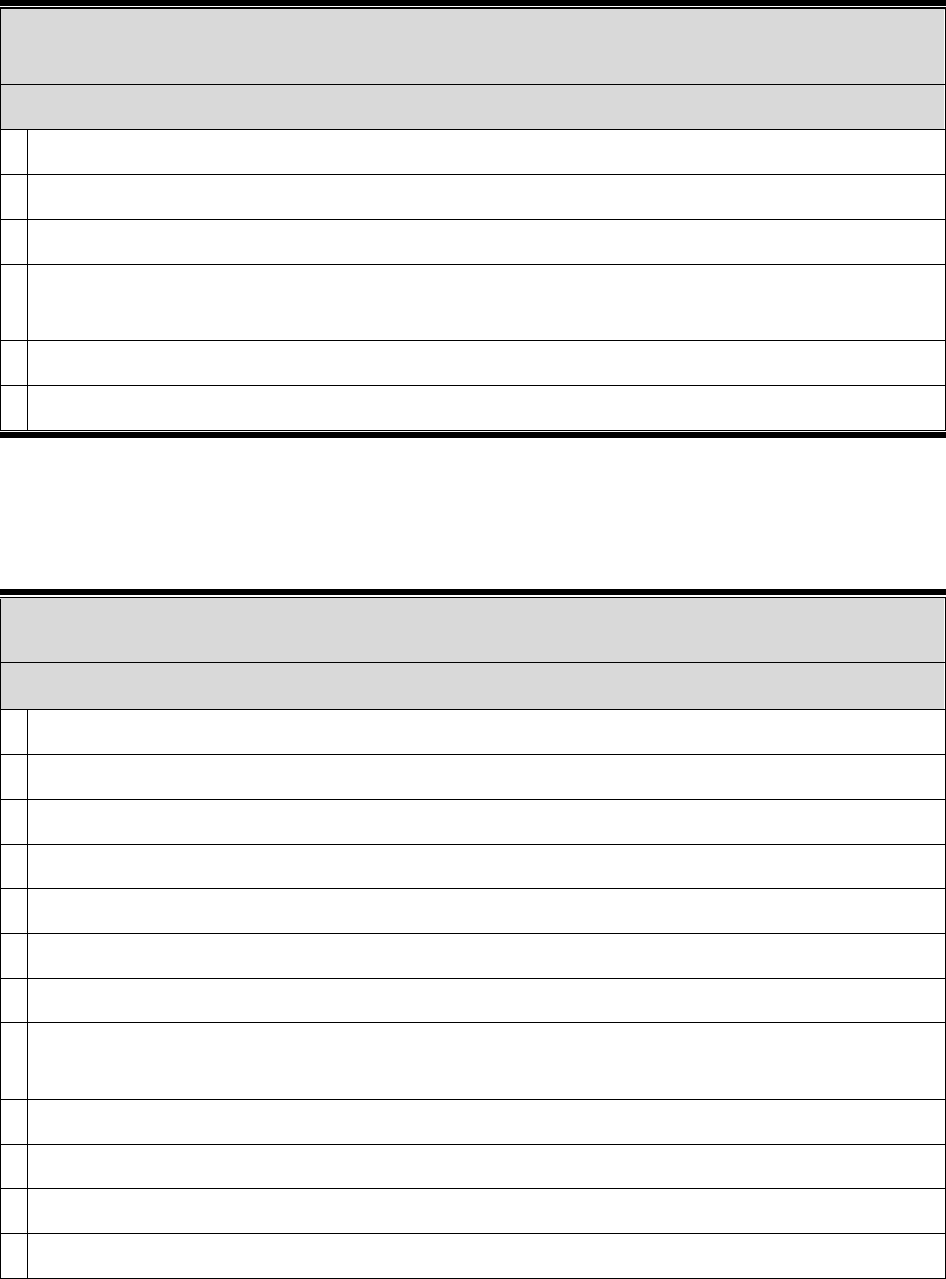
B-14
A3. The organization that I work for is, or plans to be, a: [mark all that apply] (required)
Works with drones, but none of the above (please describe)
A4. In what capacity does your organization work with drones?
*
We use drone for search and rescue
*
We use drones for aerial footage to enhance our projects/videos for community based pieces.
*
We use drones for life safety missions.
*
We use drones to enhance operational efficiency and safety aspects of various mining
operations.
*
We use drones to film.
*
We use them for searches, crime/accident scene photography/videography, and over watch
Table B4
Responses Provided by Respondents Who Indicated ‘Other’ on Item A5, and Who Described
Their Organization’s Current or Planned Drone Operations (n = 13)
A5. Please select the industry or sector that best describes the current or planned drone
operations of your organization:
[mark all that apply] (required) Other (please describe)
a. Other industry or sector, please describe:
*
all public safety
*
Athletics
*
construction
*
Film
*
Imagery for large property management companies and building owners
*
Law enforcement
*
Natural Resources Monitoring
*
Providing adaptive recreational drone therapy for neurological disorders like TBI, and PTSD
to name a few.
*
Residential Construction
*
Search and Rescue
*
Space Industry
*
Tribal Government

B-15
A5. Please select the industry or sector that best describes the current or planned drone
operations of your organization:
[mark all that apply] (required) Other (please describe)
a. Other industry or sector, please describe:
*
We fly for fun.
Table B5
Responses Provided by Respondents Who Indicated ‘Other’ on Item A7, and Who Described the
Certificates They Hold (n = 14).
A7. Which of these certificates do you hold? [mark all that apply] Other (please describe)
a. Other certificate(s), please describe:
*
ATP
*
ATP, commercial, single and multi-engine land.
*
CFI
*
CFI, CFII
*
Commercial Cert and CFI.
*
FAA Class II certification to perform MQ-9A senor operator LR and MCE duties.
*
Flight Instructor, Airplane Single Engine, Airplane Multi-Engine, Instrument Airplane
*
Former military officer/pilot
*
My 14 CFR Part 107 certificate expired in SEP 2018 and is not needed in my current
position. I am trained, certified DCMA Military UAS Pilot (equivalent).
*
Part 137 Agricultural Operations for UAS Part 61 Student Pilot Certificate
*
Part 61 student pilot certificate
*
PPL, CPL, ATP
*
Technical training…aircrew fundamentals initial qualification training, launch and recovery
training
*
[Company] Crew Member- Operator and Maintainer
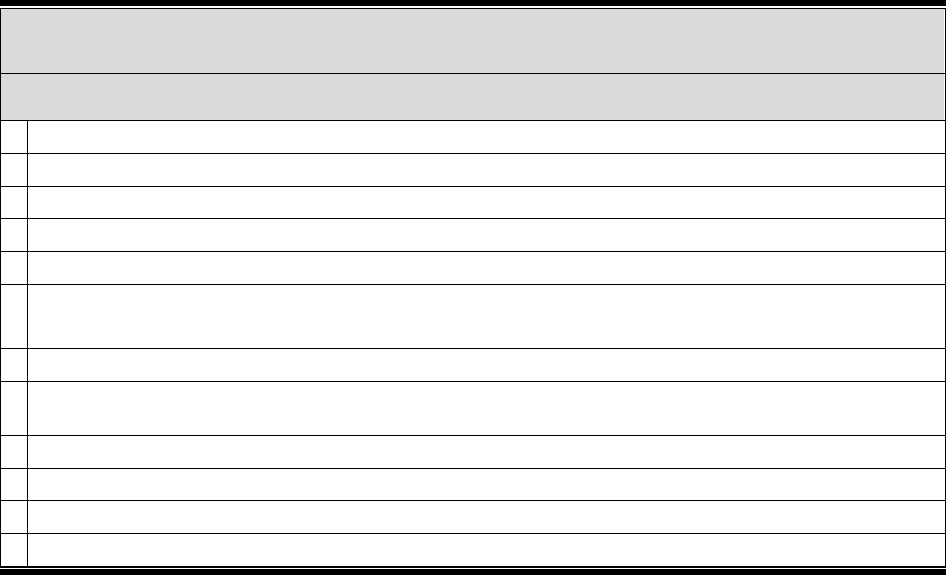
B-16
Table B6
Responses Provided by Respondents Who Indicated ‘Other’ on Item A8, and Who Described the
Certificates Required for Their Job (n = 12)
A8. Which of these certificates are required for your job? [mark all that apply] Other (please
describe)
a. Other certificate(s), please describe:
*
Basic Law Enforcement Academy certificate of completion.
*
Commercial
*
Experience satisfies the requirement for the company. Flown a variety of UAS for 10 years
*
FAA Class II certification.
*
I fly under the FAA rule 49 USC 44809
*
My 14 CFR Part 107 certificate expired in SEP 2018 and is not needed in my current position.
I am trained, certified DCMA Military UAS Pilot (equivalent).
*
No certificate required, just training provided by employer.
*
None
*
OSHA 10, OSHA 10 Construction.
*
PPL, CPL
*
SUAS certification
*
[Company] Crew Member- Operator and Maintainer
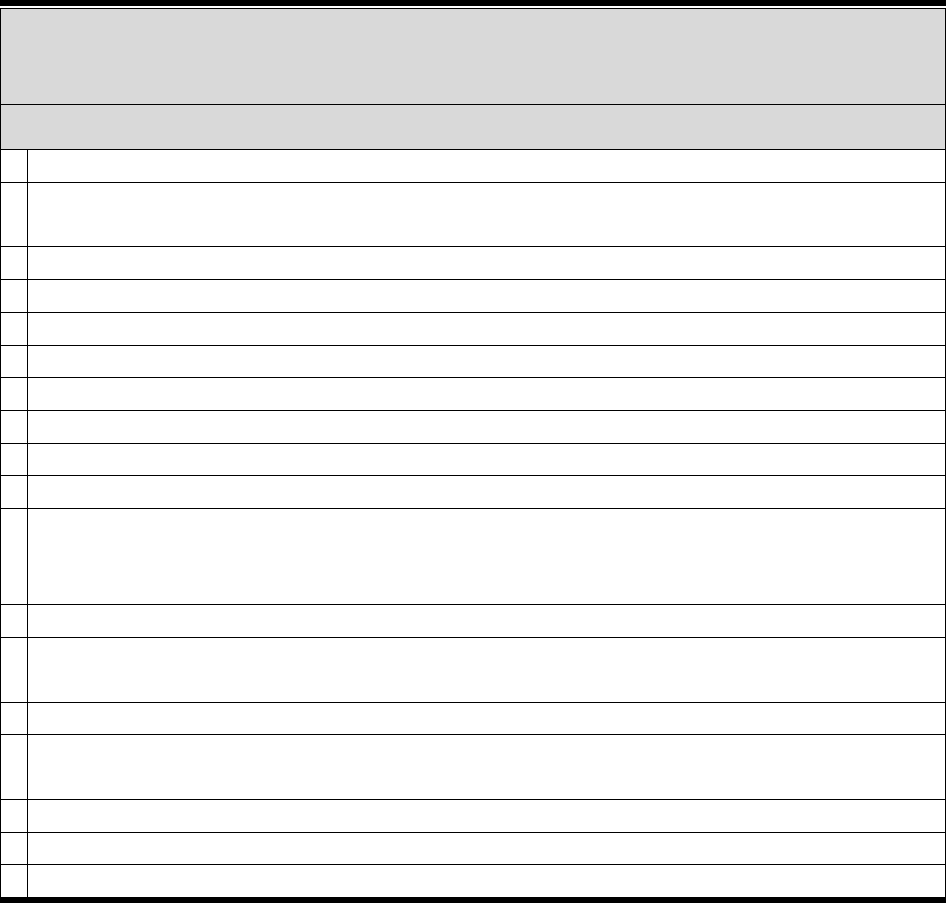
B-17
Table B7
Responses Provided by Respondents Who Indicated ‘No, I hold a certificate(s) from another
organization’ on Item A9, and Who Listed the Certificates They Hold from Another Organization
(n = 18)
Section B. Qualification Requirements
Table B8
Responses Provided by Respondents Who Indicated ‘Instructor’ on Item A1, and Who Listed
Their Organization’s Requirements to Become an Instructor on Item C6 (n = 39)
A9. Do you hold a Trusted Operator certificate from the Association for Unmanned Vehicle
Systems International (AUVSI)?
No, I hold a certificate(s) from another organization (please
describe).
a. What certificate(s) do you hold from another organization? Please describe.
*
Advanced Safety Levels One and Two Certificates from the Unmanned Safety Institute.
*
advanced sUAS operator, payload operator, [Company] Drones, Inc. National Emergency
Services Academy
- advanced sUAS course graduate
*
Aerial Applicator [Company]
*
AMA pilot
*
AMA Pilot instructor
*
FAA Part 107
*
FAA UAS
*
I have FAA approval [Number] for aircraft less than 55 lbs. I am AMA Member # [Number]
*
I hold a Safety Certification from Unmanned Systems Institute
*
Military Form 8, MQ-9 Instructor Pilot
*
Multiple UAS platform certifications, Instructor certification, Standardization certification,
multiple UAS autopilot certifications, safety certification, laser operation certification, crash
investigation certification
*
NCDOT UAS Operator Permit
*
NIST sUAS Standard Test Methods (1) Basic Proficiency; (2) Advanced Proficiency; and (3)
Instructor Certificate issued by the Airborne Public Safety Association
*
NIST sUAS Standard Test Methods BPERP and Instructor.
*
PRO Level 3 from Unmanned Safety Institute, OSHA 30, 50+ FEMA certifications, Master
UAS Instructor from USI, Certified SAR Drone Pilot with the Civil Air Patrol
*
Qualifications through the military
*
Safety, VLOS, systems and BVLOS certificates from the Unmanned Safety Institute (USI)
*
Unmanned Safety Institute PRO Pilot/Instructor

B-18
C6. What are your organization’s requirements to become an instructor?
*
2-year degree minimum, Community College of the Air Force certification, Instructor upgrade,
minimum 25 hours of drone flight.
*
500 hours observed flight time with instructor Part 107. In-house three week training class,
must pass with 85 percent or better.
*
500hrs for mission instructor, for launch and recovery IP you must be a mission IP and have an
additional 250hrs of launch and recovery time
*
6 months of training
*
75 hours of launch and recovery and knowledgeable.
*
an organization that is authorized to train and certificate, such as the FAA or NIST or similar
*
at least 5 years experience, within the last three years.
*
At least a master's degree or bachelor's with certifications or industry experience.
*
Be current on a UAV and have 25 hours flying that UAV. Must teach all PPTs and flight
operations.
*
BS degree, Part 61 Comm Pilot Certificate, Part 107 Remote Pilot Certificate.
*
Certification from myself, Remote Sensing Lead, or ownership team.
*
Due to the relatively inconsistent nature of "UAV flight hours" we do not have a formal flight
hours requirement at the moment but 3+ years of demonstrated UAS experience on a resume
(and a flight checkout with a
chief instructor) are our typical requirements. We tend to
prioritize geospatial or engineering experience over pilot proficiency due to the nature of the
work as training mostly for GIS, survey + data collection. The drone instructor role and data
capture
/processing instructor role are usually one and the same.
*
Extensive part 107 knowledge and EP Experience.
*
FAA Part 107, supervised flight demonstration of abilities
*
FAA remote pilot certification
*
Have a 107 and 100 hrs of flight time
*
Hold Part 107 certification.
*
Internally developed training program, including training on advanced operations, policy and
flight instruction
*
Long process that extensive knowledge must be demonstrated
*
Manned private pilot, remote pilot certificate, first or second class medical, 6 months on the
job experience and 120 hours crew duty hours, FAA line/observation check post 135
-
certificate
*
Meet the minimum state qualifications for teaching in the discipline and a current holder of the
Part 107 certif
icate.
*
Minimum 6 months experience in operations at the company. Must have P61 pilot certificate.
Must complete instructor training.
*
Minimum Part 107 certification with a high level of UAS experience
*
Minimum number of hours and experience

B-19
C6. What are your organization’s requirements to become an instructor?
*
Part 107 Certificate Adult Education Experience
*
Part 107 certification Internal safety and operation training
*
Part 107 certification and Part 61 certificate
*
Part 107 Remote Pilot certificate
*
Part 107, 100 flight hours, public safety experience
*
Part 107, 5 years industry experience
*
Part 107, flight review, in-depth FARAIM knowledge
*
Part 61 rating and or extensive UAS experience.
*
Pass our AVIA 235 and 236 courses, Pass a checkride, have a part 107
*
Remote pilot certificate, teaching adult learners certificate, background check, child abuse
clearance
*
System knowledge, 150 flight hours on system, total time as operator, flight exam, knowledge
test exam, additional required training
*
taken our in house instructor course taught by chief instructor
*
To be qualified as a Remote Pilot Instructor, a person must possess a Remote Pilot Certificate,
and AUVSI TOP Level 3 Remote Pilot Instructor certification and complete either our
SUAS4000FOI or the Worldwide_Student_TOP_Instructor_Addon
course; and be designated
by the Chief Pilot.
*
UAS certificate, Part 61 pilot certificate or Ground Instructor certificate.
*
Verifiable prior RPAS instructional experience (military or civilian), Part 61 CFI preferred
Table B9
Responses Provided by Respondents Who Indicated ‘Other training’ on Item C33, and Who
Listed the Minimum Organizational Requirements Necessary for Instructors to Operate Drones
(n = 14)
C33. What are the minimum requirements necessary for instructors to operate drones at
your organization?
Other training (please describe)
a. Other, please describe:
*
APSA NIST Proctor/Instructor
*
Continuing education training, semi annual examinations
*
Illinois state basic operations firefighter
*
Industry specific training on Safety, Regulatory Guidance, or other as directed by contract.
*
Instructor Training
*
internal RFI training
*
Minimum 50 hours of operational experience for instructor selection training. Minimum 100
hours of operational experience
for evaluator selection training and a management course.
*
NIST UAS
*
Sworn Law Enforcement experience.

B-20
C33. What are the minimum requirements necessary for instructors to operate drones at
your organization?
Other training (please describe)
a. Other, please describe:
*
Teaching training
*
TOP Level 3 Remote Pilot Instructor training and certification at our Worldwide Campus.
*
Train the Trainer course
*
Training involving learning types and ethical testing procedures.
*
We require each of our instructors to have a minimum number of multirotor flight hours. And
coaching/teaching experience that we suss out during our application.
Table B10
Responses Provided by Respondents Who Indicated ‘Other training or experience’ on Item C34,
and Who Listed Their Minimum Training or Experience Requirements (n = 19)
C34. What are the minimum requirements necessary for drone pilots at your organization?
[mark all that apply]
Other training or experience (please describe)
a. Other training or experience, please describe:
*
Aircraft specific and operation-specific training
*
At least 50 hours of Part 107 UAS operations time.
*
Basic Law Enforcement Academy Completion Certificate
*
Cinematography & Photography skills
*
Co tracts provide additional requirements as specific to the job location or industry including
DoD specific requirements. Some Civil operations require Industry specific compliance or
safety training.
*
Different clients may require additional training for each pilot with various platforms or
proprietary software.
*
FAA TrUST Certificate for our pilots and technicians. NIST
*
Flight hours and inhouse training for BVLOS operations (where BVLOS operations are
approved)
*
LOGGED HR REQUIREMENT FAMILIARARITY WITH PLATFORM
*
Manuel tree audit tasks, driving tasks, radio communications tasks
*
Manufacture training when available.
*
Military form 8
*
New crew members shadow experienced team before becoming full company authorized pilot.
*
Our own operational safety courses classroom, and in the field hands on flight training and
evaluation
*
Pesticide, Herbicide, Right of way
*
Previous experience with the autopilot software necessary to operate aircraft
*
Time as an effective police officer.

B-21
C34. What are the minimum requirements necessary for drone pilots at your organization?
[mark all that apply]
Other training or experience (please describe)
a. Other training or experience, please describe:
*
We do a comprehensive in house flight training which includes a practical and or oral exam.
Also require all students to pass a timed indoor flight course (using Syma's) and after the flight
training exams also needs to complete two missions before becoming a RPIC for our agency.
*
We require each of our instructors to have a minimum number of multirotor flight hours. And
coaching/teaching experience that we suss out during our application.
Section C. Training
Table B11
Responses Provided by Respondents Who Indicated ‘Yes’ on Item C5, and Indicated Which
Government Agency Provided Review of Their Training Materials (n = 30)

B-22
D2. Are your drone pilot education and training materials currently submitted to, or
reviewed by, another government agency (not the FAA)? Yes (please describe)
a. Please indicate which government agency reviews your training materials:
*
AFSOC
*
Air Force
*
Army Aviation Training and Doctrine
*
California Community College Chancellor’s Office, as part of certificate approval.
*
Civil Air patrol
*
Department of Defense
*
Department of Navy
*
Department of the US Air Force
*
Different classes and programs have different potential governing bodies. Out manned
flight courses go through a lot of FAA review. Our UAS courses have no governing body
other than the accreditation standards at the college level.
*
DoD
*
DOD
*
DOD
*
DOD customers
*
DoD, FAA, DOI, DOJ, CBP, DHS, Kansas Department of Transportation, Florida
Emergency Management
*
DOD, US State Department, UN, others depending on contract requirements
*
DOI
*
DOI IAT program and Region Training Coordinator
*
Idaho Division of Career and Technical Education
*
Maryland department of education
*
Military
*
NASA, NOAA, DOE
*
NOAA agency manages drone pilots and reviews/approves our paperwork and missions.
Any communications with the FAA are conducted and funneled through NOAAs aircraft
operations centers UAS program
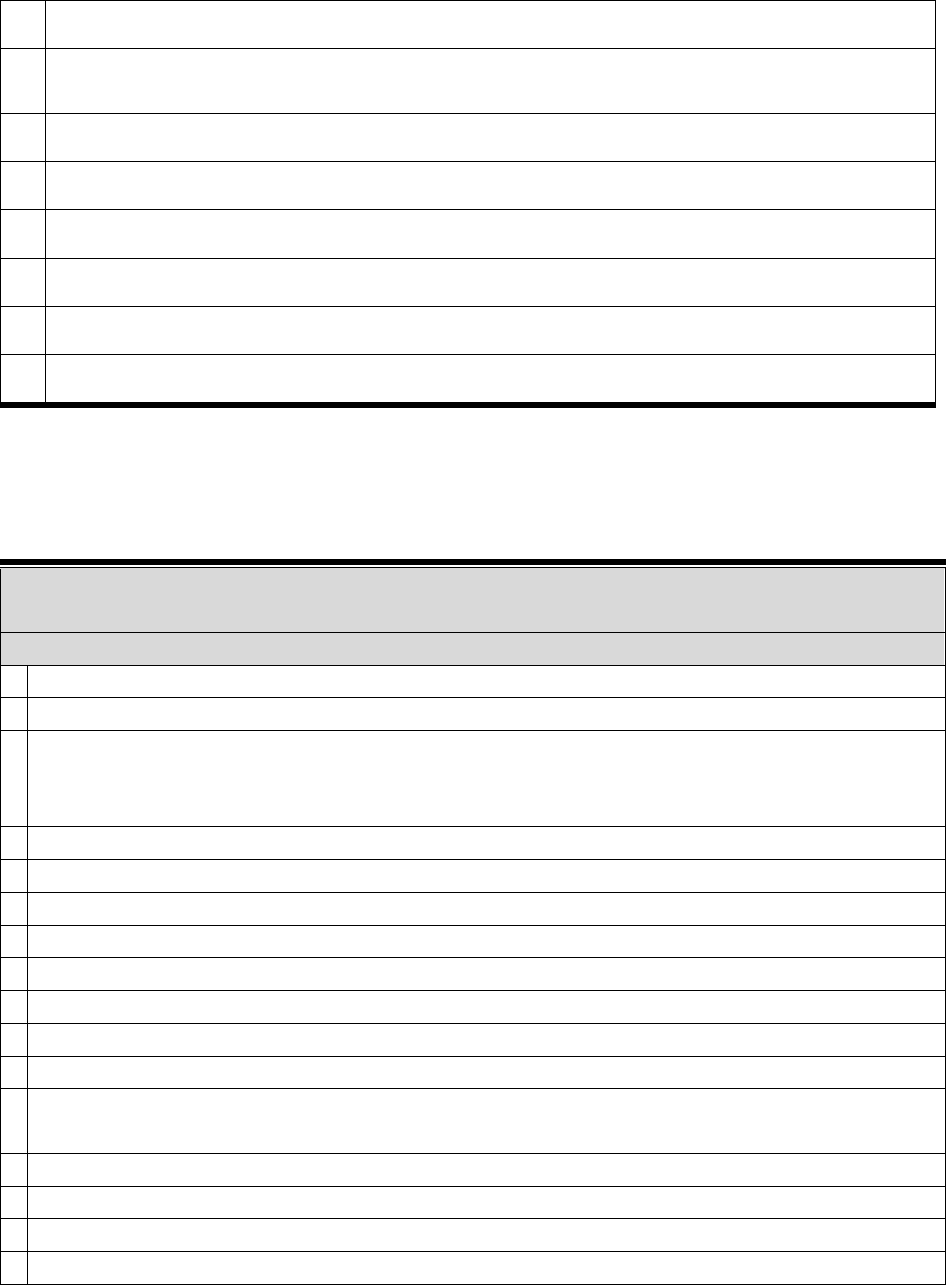
B-23
*
NOAA, USDA, FAA, DOD, DHS and Cherokee Nation
*
Several, most notably the department of homeland security uses them for training and
APSA uses them for credential in. Developed by the department of commerce
*
State of North Carolina
*
U.S. Air Force
*
United States Air Force
*
United States Army government liaison
*
USA, USN, USAF, USMC, DOE, DOI, DOJ
*
USAF
Table B12
Responses Provided by Respondents Who Indicated ‘Yes’ on Item C3, and Indicated Which Non-
Government Agency Provided Review of Their Training Materials (n = 28)
D3. Are your drone pilot education and training materials currently submitted to, or
reviewed by, a
non- government agency? Yes (please describe)
a. Please indicate which non-government agency reviews your training materials:
*
AABI
*
Accrediting body
*
All program documents are reviewed as directed under specific contract. This may include
State agencies, Educational Institutions, other Industry certifying agencies. Too many to list
here.
*
APSA - NIST
*
ARGUS
*
ASA
*
ASTM International
*
AUVSI
*
AUVSI for our TOP Training Provider certification.
*
Aviation Accreditation Board International’s (AABI)
*
Clients and Universities as required
*
Clients. Specific and determined per project. Based on complexity, location, airspace and
scope of work/d
eliverables.
*
CTI
*
Customers
*
DCJS
*
Disney, Universal Studios
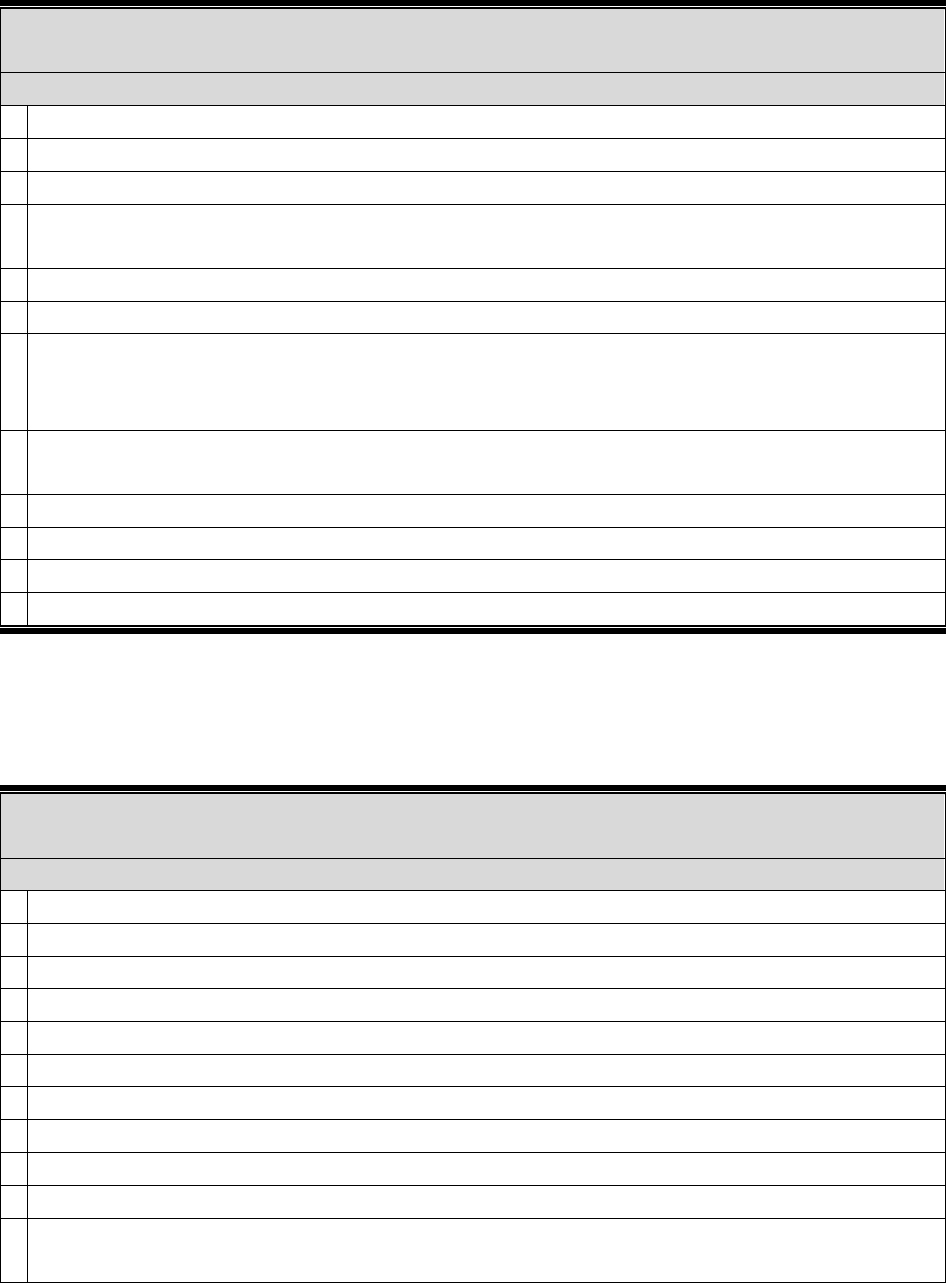
B-24
D3. Are your drone pilot education and training materials currently submitted to, or
reviewed by, a
non- government agency? Yes (please describe)
a. Please indicate which non-government agency reviews your training materials:
*
General Atomics
*
Internal as well as some of our training clients are law enforcement and first responders
*
IS-BAO
*
Kansas State University, North Carolina University, Auburn University, Embry-Riddle
Aeronautical University, Colorado University, United States Air Force Academy
*
MABAS Illinois
*
Our client flight departments may choose to review our program.
*
Our training materials have been submitted and are disseminated by the National Science
Foundation funded National Center for Autonomous Technology (NCAT) and Geospatial
Technology Center of Excellence.
*
Program is guided by a Technical Advisory Committee comprised of numerous industry UAS
operators
*
The Aviation Modelers Association of America, the AMA.
*
Unmanned Safety Institute
*
Virginia and Maryland Community College system
*
Wounded Eagle UAS
Table B13
Responses Provided by Respondents Who Indicated ‘Yes’ on Item C7, and Who Listed the
Certificates or Authorizations Held by Their Organization (n = 18)
D7. Does your organization hold any certifications or authorizations for training drone
pilots and/or operators?
Yes (please describe)
a. What kind of certificates or authorizations does your organization hold?
*
2 year collage Degree
*
Airborne Public Safety Association NIST BPERP Proctors (most instructors).
*
AMA Flight Instructor
*
Auvsi TOP
*
AUVSI TOP Level 3 Remote Pilot Instructor.
*
CCAF and initial qualification training on several group 1 systems
*
Certificate of training
*
Certified to teach military personnel
*
Created BUQ Level II courseware certified by Department of Navy
*
FAA colligent UAS trainers
*
FAA part 61 cfi/i/mei/agi, NIST proctor and one person in organization is an authorized NIST
Instructor
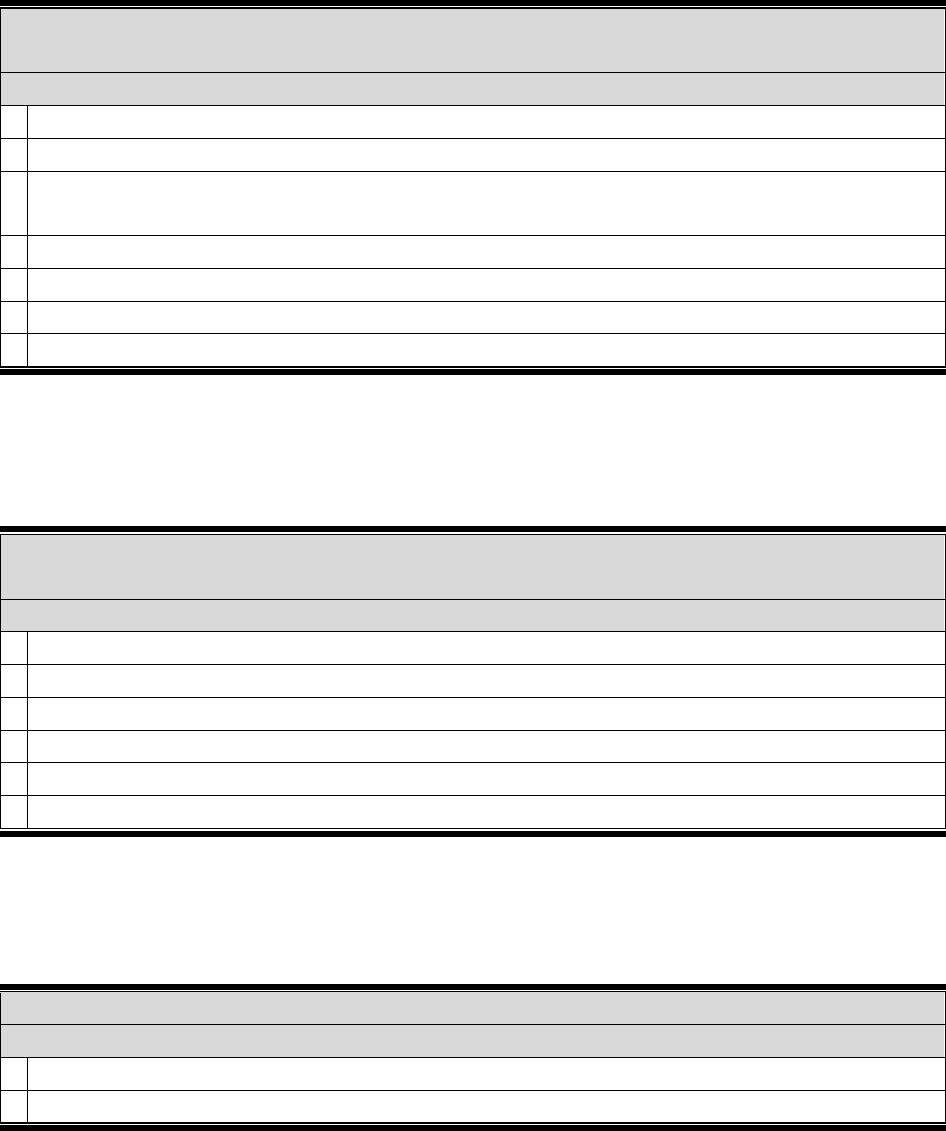
B-25
D7. Does your organization hold any certifications or authorizations for training drone
pilots and/or operators?
Yes (please describe)
a. What kind of certificates or authorizations does your organization hold?
*
Form 8 qualifications.
*
In the process of obtaining our part 135 certificate
*
levels of UAS operators, visual observers, mission briefer, mission coordinator, PIC, mission
approval
*
military formal training
*
part 107 and drone center flight authorization
*
teaching adult learners (24 hr course)
*
Unmanned Safety Institute PRO Pilot Level 1 and 2 curriculum.
Table B14
Responses Provided by Respondents Who Indicated ‘Other’ on Item C28, and Described the
Type of Operations Provided for Training (n = 6)
D28a. What type of operations do you provide training for? [mark all that apply] Other
(please describe)
Other, please describe:
*
2D and 3D mapping.
*
Aerial Mapping
*
all public safety
*
Disaster Response, Data Gathering
*
Drone training workshops for hands on flight instruction
*
Mapping and surveying
Table B15
Responses Provided by Respondents Who Indicated ‘Other’ on item C31, and Indicated the Type
of Drones They Provide Training on (n = 2)
D31. What types of drones do you provide training on? Other (please describe)
a. Other drone type (please describe):
*
Multicopter
*
Rear prop
Table B16
Responses Provided by Respondents Who Indicated ‘Simulation training’ on Item C32, and
Indicated the Type of Simulation Training They Provide (n = 17)

B-26
D32. What types of training do you offer? Simulation training (please describe)
a. Simulation training (please describe):
*
Computer simulations.
*
Drone Flight Simulators
*
Flight skill development and also flight software training
*
Laptop and hand controls
*
Mission Planner, Zephyr, DJI Flight Sim
*
Real Flight R/C simulator
*
Real flight Simulator, Drone Racing Simulator, and DJI flight simulator,
*
SimLat simulator training
*
Simulation used on all systems that have one. Mainly used for buttonology
*
Simulations used for initial training and poor weather days
*
Simulators.
*
The students preform take off, mission planning, flight of the UAV and emergency procedures.
*
Use of simulator prior to actual flights for training on controls to operate the SUAS
*
Use Real Flight for entry level training. Use simulator feature in Mission Planner for
automated flight training.
*
Utilize Aero-SimRC and included simulator training course to provide initial fixed-wing
manual control training.
*
We use simulation training to prepare our students for BVLOS operations. We call this
operation Remote Split Operations (RSO), whereas the instructor (RPIC) and VO are local
with the aircraft and maintain VLOC at all times; however, we transfer control to
our students
(persons manipulating the controls), who are not at the local flying site. We group students as a
team of two or three. They each have a role in the operation (i.e., remote pilot, visual observer,
data exploiter). The training is required by t
he FAA-issued COA. For this operation, we use
either UgCS or Swift GCS software (depending on the aircraft flown) in both simulation and
live flight. We also use RealFlight and an internally
-developed simulator in our online
courses. Our sister campus at
Daytona Beach uses Piccolo Command Center (PCC) in
simulation and live flight.
*
Zepher
Table B17
Responses Provided by Respondents Who Indicated ‘Yes on item C37a, and Described the
Training Provided outside Their Organization (n = 11)
D37a. Are there other types of drone/UAS training not listed in the previous question that
you have completed outside of your organization’s requirements?
Yes (please explain)
D37b. Other type of training provided outside of your organization, please describe:
*
Annual Check ride

B-27
D37a. Are there other types of drone/UAS training not listed in the previous question that
you have completed outside of your organization’s requirements?
Yes (please explain)
D37b. Other type of training provided outside of your organization, please describe:
*
Business Training
*
Cinematic bitrates and smooth drone operation speeds for different cinematic effects.
*
FAA's remote-pilot computer-based training/testing.
*
Flight Training
*
Flight training for ATP license
*
NIST UAS
*
Self study for test
*
Skills class
*
sUAS platforms for personal and entertainment use.
*
UAS Night Flying
Item C38a assessed other training requirements not listed on Item C38 that provided training by
your organization or by a 3
rd
party training provider. Item asked if the respondent’s other training
was provided by your organization (C38b) or by a 3
rd
party provider (C38c). Those respondents
who indicated ‘Yes’ were asked to describe (C38b) Table 18 and (C38c).
Table B18
Responses Provided by Respondents Who Indicated ‘Yes’ on Item C38a, and Described the
Additional Training Provided by Their Organization on Item C38b (n = 1)
D38a. Are there other training requirements not listed in the previous question that are
provided by your organization or by a 3
rd
party training provider?
Yes (please describe)
b. Other training provided by your organization, please describe:
*
NIST UAS
Table B19
Responses Provided by Respondents who Indicated ‘Yes’ on Item C38a, and Described the
Training Provided by a 3
rd
Party on Item C38c (n = 2)
D38a. Are there other training requirements not listed in the previous question that are
provided by your organization or by a 3
rd
party training provider? Yes (please describe)
c. Other training provided by a 3
rd
party, please describe:
*
Area Safety Council offers our client training programs for other than drone specific training.
*
CRM Crew Resource Management, provided by a contractor, Crew Training International
(CTI)

B-28
Table B20
Responses Provided by Respondents Who Indicated ‘Other training’ on Item C39, and listed
Training Required by Their Organization (n = 11)
D39. What type of training does your organization require? [mark all that apply] Other
training (please describe)
a. Other required training, please describe:
*
Agricultural Aerial Applications
*
Industry safety training and client site specific.
*
Instructor Training when required
*
Integration of multi-agency air operations such as Search and Rescue.
*
Manufactures Training, Payload Training, Specialized Sensor Training.
*
My agency covers all of those “training” categories mentioned in the earlier pages through
policy documents and many of those training aspects are covered via the remote pilot exam
studying. We do not have official training in many of those items but we have policies
outlining those aspects and the agency is always available fo
r further consultation if we have
any questions. Our pilots are very precautionary and ensure we are compliant with all FAA and
agency policies
*
night operations refresher
*
Not required, but it's recommended that the drone pilots attend drone flights accompanied by
an experienced pilot for on
-location "training".
*
Other Industry Specific training as required by individual contract.
*
Prior military UAS training
*
software, payload specific, hazard identification and risk mitigation strategies
Table B21
Responses Provided by Respondents who Indicated ‘Recurrent training’ on Item C39, and Listed
Frequency of Recurrent Training on Item C54 (n = 68)
D54. How often is recurrent training required?
*
1 year
*
1 year
*
1 Year
*
12 months
*
12 times a year
*
17 months
*
2
*
2 years
*
2 years
*
2 Years

B-29
D54. How often is recurrent training required?
*
2 Years
*
45 days
*
45 days
*
6 months
*
6 months
*
6mo
*
annual
*
annual
*
Annual
*
annually
*
annually
*
annually
*
Annually
*
Annually
*
Annually
*
Annually
*
Annually
*
Annually or as needed
*
annually or as required due to other events - illness, life event, etc.
*
Annually, or if currency lapses every 90 days
*
anually
*
bi-annual
*
biannual
*
Depends on currency, 60/90/180. 60 consist of a evaluated flight, 90 consist of a written test
and a evaluated flight, and 180 consist of an abbreviated qualification course, written test, and
an evaluated flight.
*
Every 12 months
*
every 2 years
*
every 2 years
*
Every 2 years
*
Every 2 years
*
Every 2 years
*
Every 2 years
*
Every 24 months.
*
Every 3 months
*
every 3 years
*
every 45 to 60 days
*
Every 6 Months or if new hardware being used

B-30
D54. How often is recurrent training required?
*
every 6-months
*
Every Quarter
*
every two years
*
every year
*
monthly
*
monthly
*
monthly
*
Monthly
*
Monthly or every other month depending on the skill
*
Once a week
*
Once every two years
*
Once per year or more frequent if needed.
*
one flight, at least once every 45 days.
*
Quarterly
*
Quarterly flights for currency and every other year recurrent training
*
semi annual
*
semi annual
*
yearly
*
yearly
*
Yearly
*
Yearly
*
Yearly
